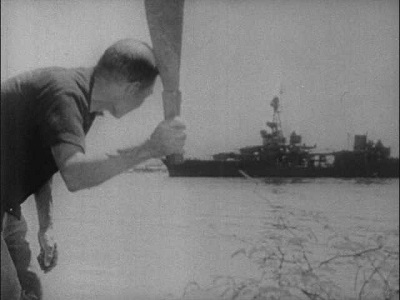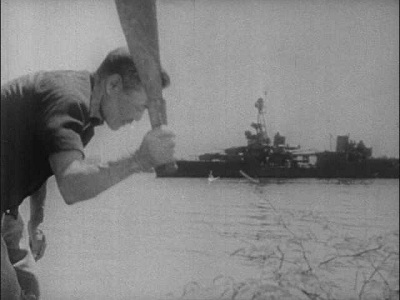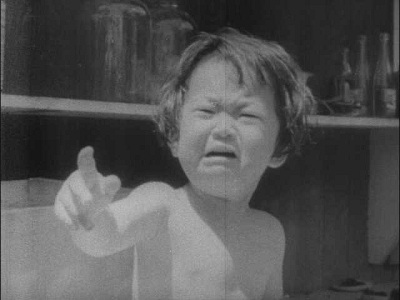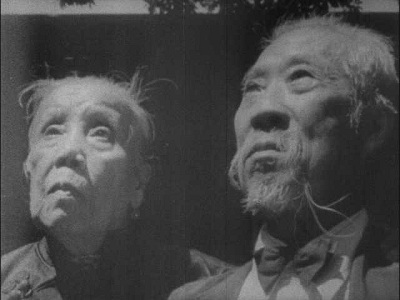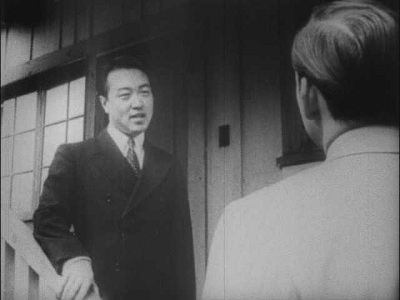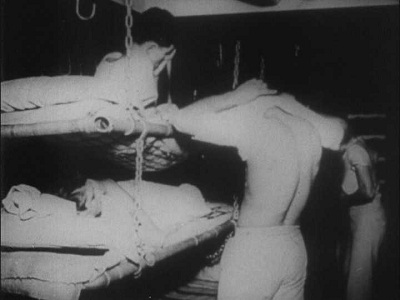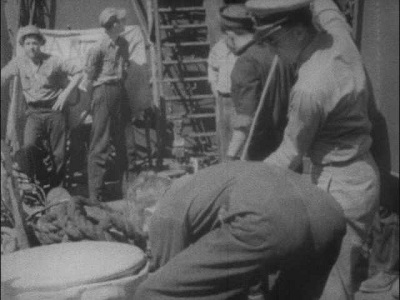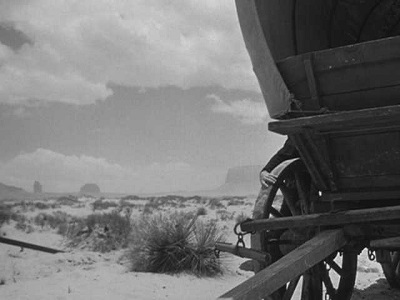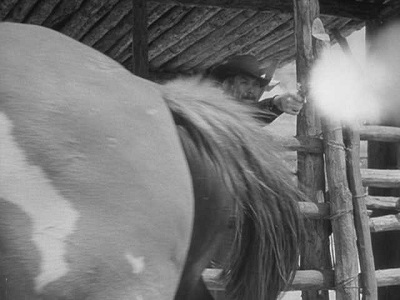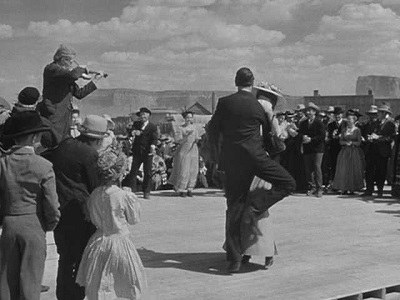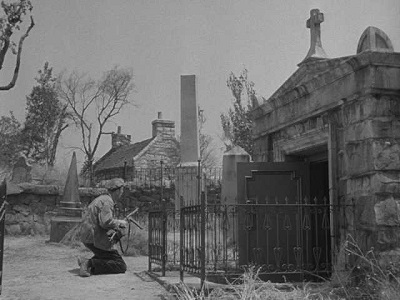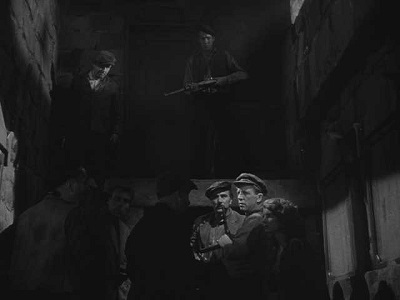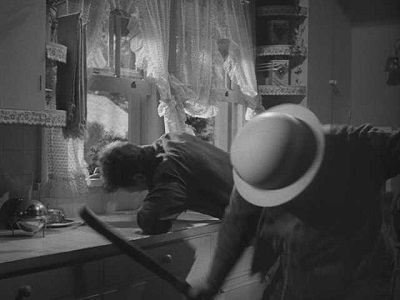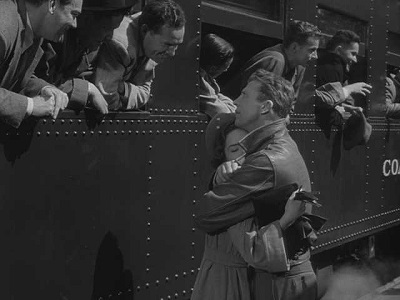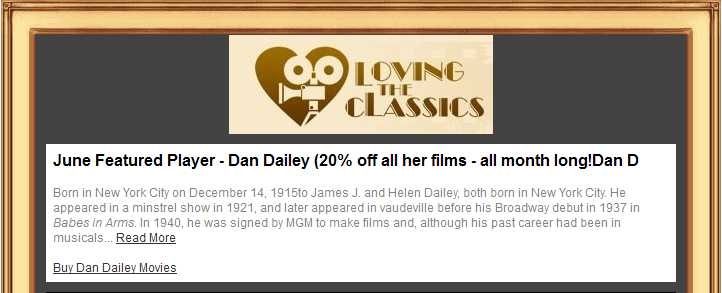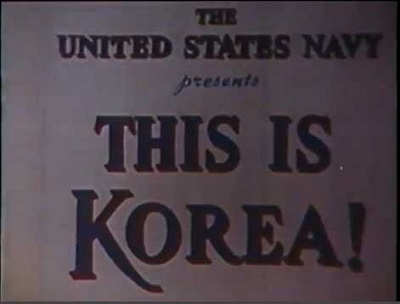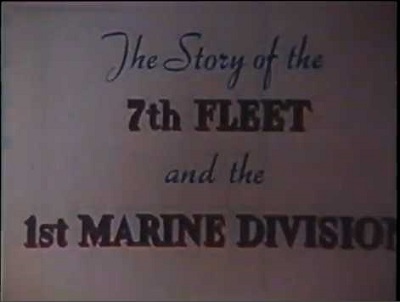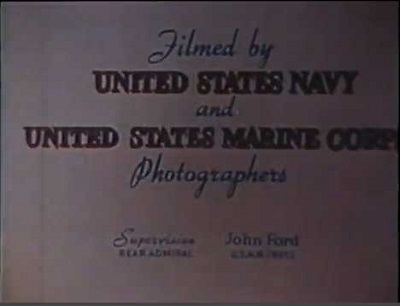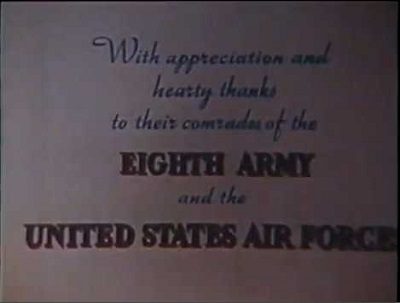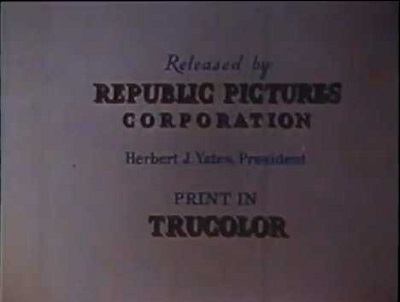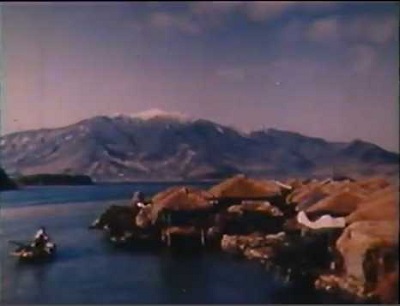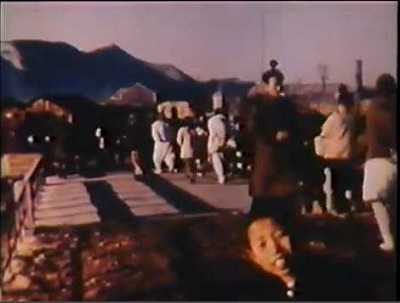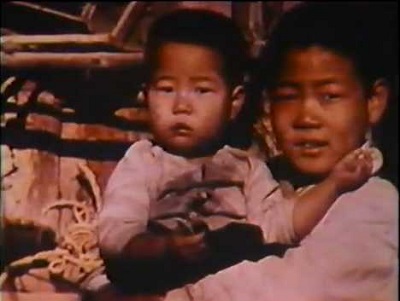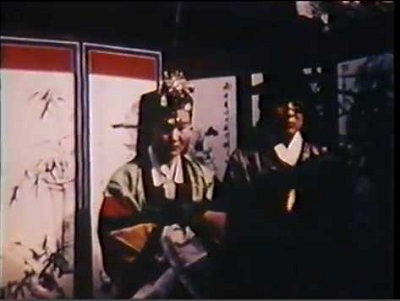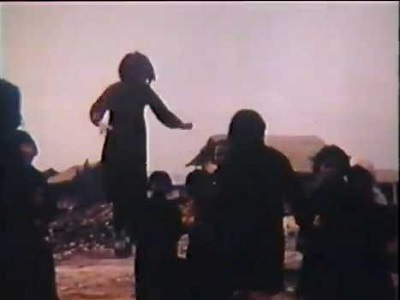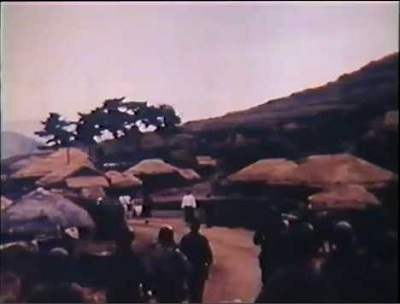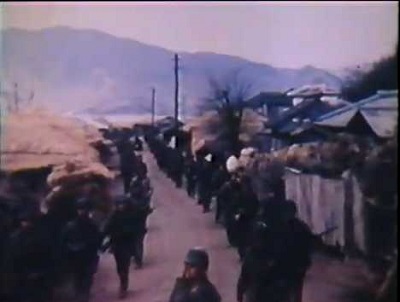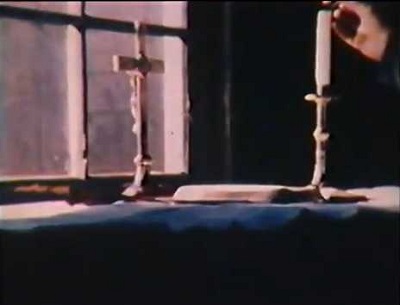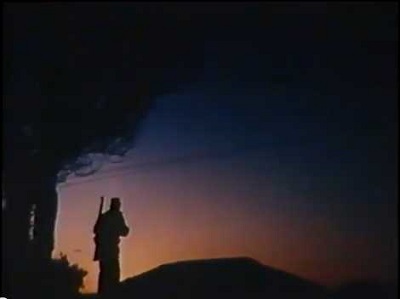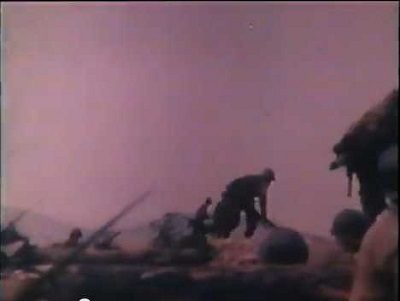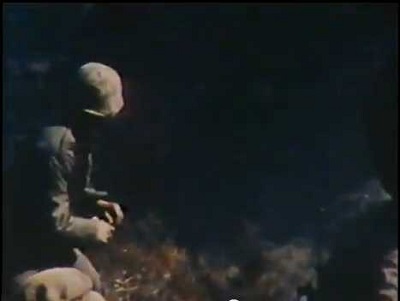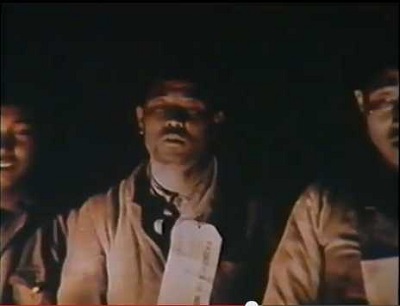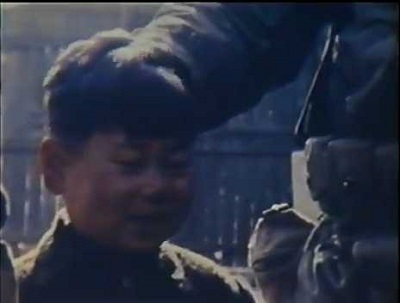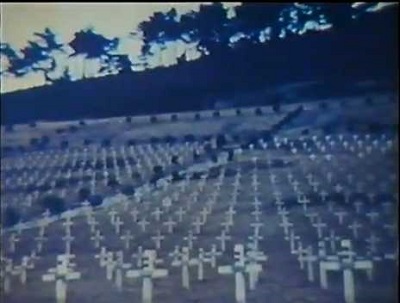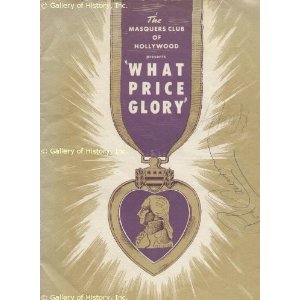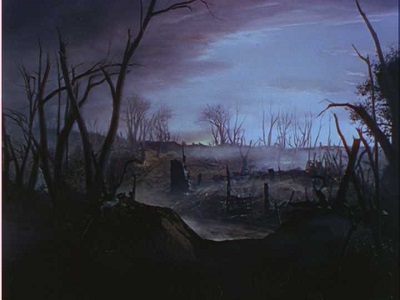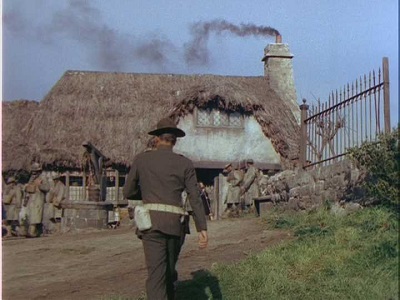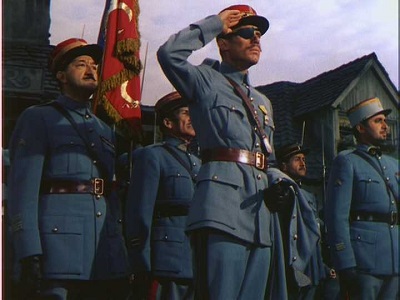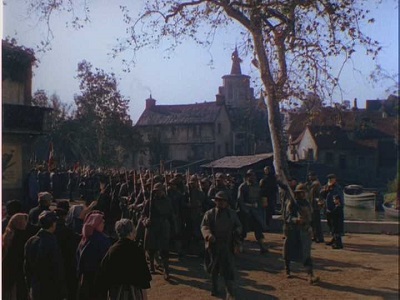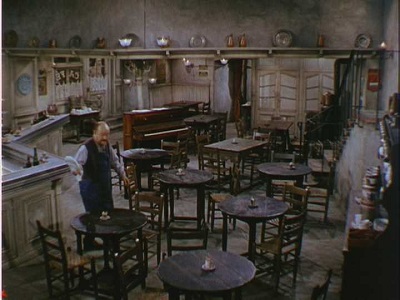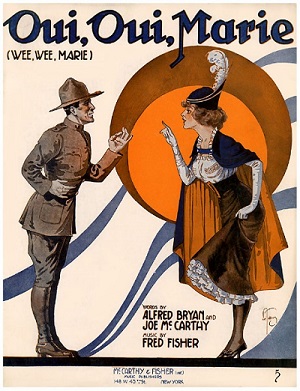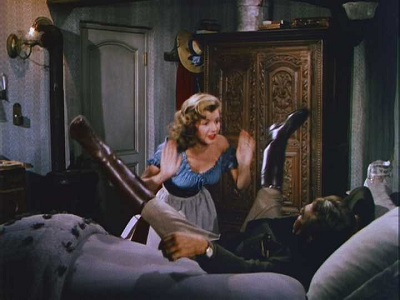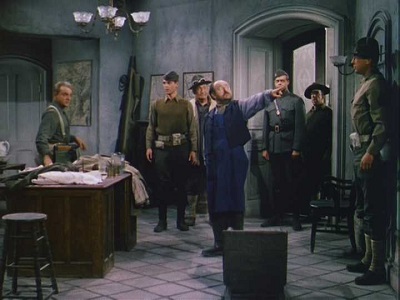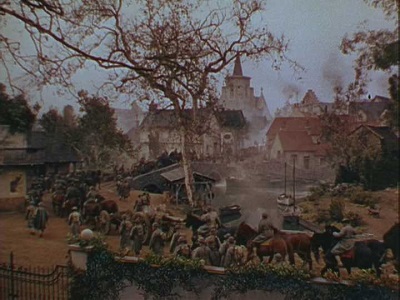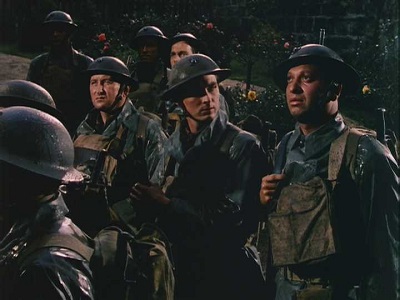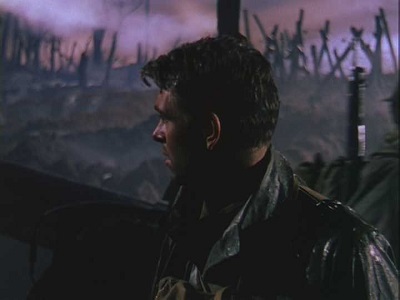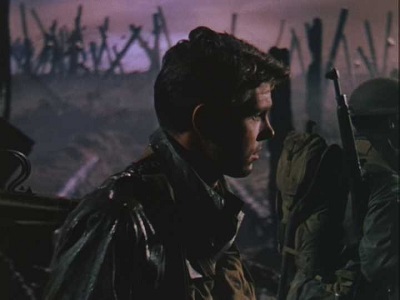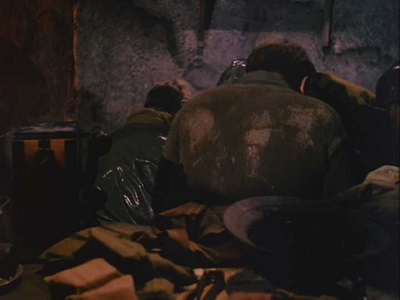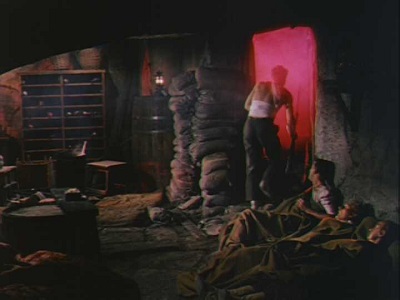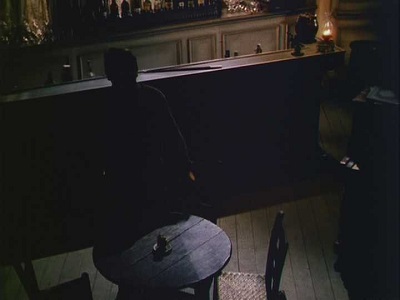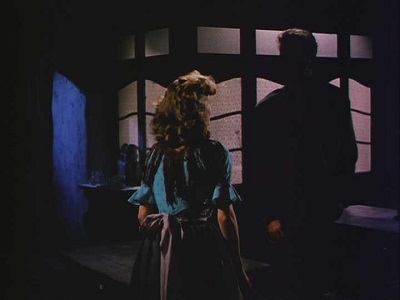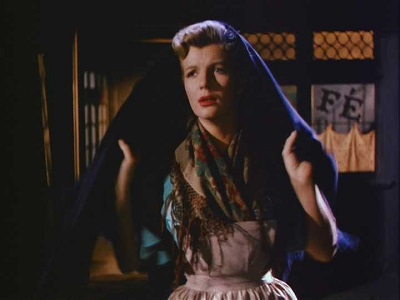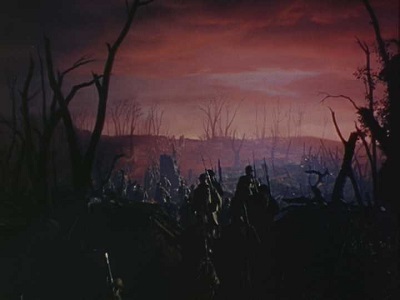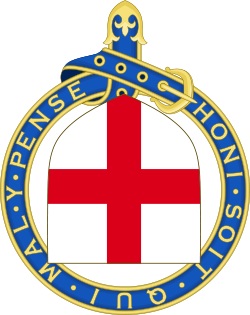Ford At Fox
4.1 Introduction to Part 4
4.2 Documentaries (1941-43)
4.3 [My Darling Clementine (1946)]
4.4 When Willie Comes Marching Home (1950)
4.5 This Is Korea! (1951)
4.6 What Price Glory (1952)
4.7 Summations
1. Ford At Fox
17 May 2013. This is a good moment, even a good week, to look swiftly over the whole Ford At Fox project, for on this date in the New York Times Dave Kehr wrote, “Fox has one of the best archival operations in the business, as can be seen in the superb work the studio did on the landmark John Ford box set, “Ford at Fox,” released in 2007 and still a triumph of the DVD medium.” [1]
Kehr’s is a good assessment. After writing the first review, where I thought Fox had not done right by simply going with the print of 3 BAD MEN which they had used back in the seventies, I found little or nothing seriously wrong with the actual restoration work – although sometimes the presentation on DVD left something to be desired and certainly Fox could have included some titles that it determined not to. A great deal of the restoration work was not done specifically for this Fox project (especially the Will Rogers and Shirley Temple films) and sometimes recycling already-released restorations with no written update or reconsideration was not the best plan (The Iron Horse, My Darling Clementine). New, better and more pointed commentaries for every film would have greatly benefited the series. That is, given the general excellence of the product, there seemed to be more penny-pinching than such a significant release warranted, and not enough input from some of the critical and scholarly talent they could have called on.
2. Ford at war
For Ford himself at first it seems that the war changed everything, that from this point “the guilt, paranoia, and irrational momentum of war” [2] never let him go.
“[War] was my racket for a while, and there wasn’t anything funny about it. I wonder what s.o.b. will be the first to make a comedy about Vietnam?” (Ford in Bogdanovich, p. 89).
“Whatever else war might be, Ford tells us [in The Battle of Midway], it is regardless an ultimate sort of experience of one’s life. What is life, or love, or death compared to it?” (Tag Gallagher, p. 236)
“of the thirty-three films made after 1948, eighteen are directly concerned with studying the problems of military communities, while nine others treat, in much the same terms, quasi-military communities (wagon trains, missionaries, political parties, police), while two others have military life as a background (The Searchers, Donovan’s Reef).” (Gallagher, p. 282)
However, war in general and military experience on active service in particular are significant topics in many Ford films prior to his service in the Second World War. In the Ford At Fox set these issues are to the forefront at least in Four Sons, Born Reckless, Pilgrimage, The Seas Beneath, As The World Turns, and Wee Willie Winkie before the period covered by this section of the review.
Like many others who saw active service during World War II, Ford came home with a specific freight of experiences, mostly undigested. The aftermath of Second World War may have furnished Ford with an audience receptive to military stories as well as providing that personal motive for their production. In the years that followed he had to come to terms with his wartime experiences within the context of a world at once changed and unchanged by the war and which, in its turn, continued to generate unsettling events apparently even more rapidly than before.He returned to work in an industry in the process of being pulled apart. Although he took (somewhat complicated) positions in the political events of those times, he was also an actor in the industrial restructuring that began with the United States Supreme Court’s “Paramount Decision” in 1948, which effectively ended the vertical monopolies that the major motion picture studios had enjoyed until that time. He worked out his contract at Fox, depriving himself of the security and infrastructure that the studio had provided as well as its interference, indifference and corporate direction. In its place he started his own production company, Argosy, and experienced the instability and penuriousness of being on his own as well as the freedom to fail on his own terms and to succeed on the box office drawing power of others.
If “guilt, paranoia, and irrational momentum” are characteristic of war, they are also appropriate to the American experience, and to Ford’s experience in particular, in the first decade following the end of the war.
[1] I have Jonah Goldstein to thank for drawing my attention to Dave Kehr’s article, “Dusting Off Items In Fox’s Attic” in The New York Times for 17 May 2013, which I had every reason to have read without his having to point it out for me. http://www.nytimes.com/2013/05/19/movies/homevideo/inconsistent- quality-from-fox-cinema-archives.html?pagewanted=all&_r=0
[2] Rory Stewart, “Lessons from Afghanistan” New York Review of Books 18 August 2012, p. 82.
‘Our job,’ Ford once told a newsman, ‘was to photograph both for the Records and for intelligence assessment, the work of guerillas, saboteurs, Resistance outfits . . . Besides this, there were special assignments.’ (Bogdanovich, p. 132)
The World War II documentaries included in the Ford At Fox set are to be found on the disc titled Becoming John Ford under the menu heading “Special Features” and then, under the “Special Features” menu, “WWII Documentary Short Subjects Directed By John Ford”. This heading is not, strictly speaking, accurate because the long version of December 7th, credited to Ford and Gregg Toland, is not included. Sex Hygiene, definitely a documentary made by Ford, was completed and released in 1941 before Pearl Harbor and is, thus, not a “WWII Documentary Short”. Another documentary, We Sail At Midnight (1943) is sometimes credited to Ford but, according to Tag Gallagher, “attribution to Ford is very dubious” (573).
Sex Hygiene (1941)
“I looked at it and threw up.”
Made before Pearl Harbor, while Ford was still working at Fox, covered here for the sake of convenience.
Darryl Zanuck was a reserve officer and he said to me, ‘This would just be for the Army – but these kids have got to be taught about these things. It’s horrible – do you mind doing it?’ So I said, ‘Sure, what the hell, I’ll do it.’ And it was easy to make – we did it in two or three days. It really was horrible; not being for general release, we could do anything – we had guys out there with VD and everything else. I think it made its point and helped a lot of young kids. I looked at it and threw up. (Ford in Bogdanovich, p. 80)
This is the sort of film you would expect to find on the internet in countless downloadable iterations. However, the quick and superficial searches which I have made have only come up with a few images (one of which graces the previous instalment of this review) and not one YouTube, download, streaming, or the like video. So I guess those of us with strong stomachs should be sorry that it was not included in the Ford At Fox set.
And, since Sex Hygiene seems to have been another instance of a successful Zanuck-Ford collaboration, it is even more of a pity that it was not included.
The Battle Of Midway (1942)
“I [shot] all of it – we only had one camera.” (Ford in Bogdanovich, p. 82).
America’s first war documentary (it received the Academy Award as such), filmed during the actual battle. Although he was wounded in the first attack, Ford continued to photograph the events himself. (Bogdanovich, p. 132)
It [The Battle of Midway] is even a sort of autobiography, for war is an extension of one’s cognition, down toward hell, up toward heaven, and broadly across a horizon no longer two-dimensional. (Gallagher, p. 237)
Never was Ford to make a film more cinematically and formally perfect than The Battle of Midway. The concision of its seventeen minutes never demands concession to amplitude. (Gallagher, p. 239)
I cannot imagine any improvement on Gallagher’s scrupulously detailed and characteristically eloquent analysis of this film (pp. 236-245). Additional footage shot for the film is also included on the Becoming John Ford DVD and, as is usually the case with such footage, there is something to be learned from comparing it with what was actually used.
Torpedo Squadron (1942)
The dead return
Just before the battle of Midway, a photographer in Ford’s unit took some 16mm colour footage of life on a PT Boat – Torpedo Squadron 8. When all but one man in this squadron were killed during the battle, Ford had the footage edited and reduced to an 8mm film to be seen only by the families of the dead boys. Prints were delivered to them by personal envoys (such as Joe August) and the film was never used for any other purpose. (Bogdanovich, p. 132)
Despite its apparently private purpose, the film appears along with The Battle of Midway and the short version of December 7th on the Becoming John Ford DVD in the Ford At Fox set. The squadron memorialised in this way was destroyed in the Battle of Midway and the footage is thus something of an appendix to Ford’s cinematic memoir of the battle. I feel an uneasy sense that a particularly important privacy has been violated by exposing it to the public.
December 7th (1943)
An Academy Award-winning documentary about the bombing of Pearl Harbor. According to Ford, his unit arrived about six days after the attack. ‘Gregg Toland directed that,’ he says. ‘I helped him along, I was there, but Gregg was in charge of it.’ (Bogdanovich, p. 132)
Bogdanovich’s account belongs to a more innocent age. It is now accepted that there were two versions of this film – one feature-length and one a little over half an hour (34 minutes, to be exact). The latter was the one (finally) released, the one that won the Academy Award. The DVD included in the Ford At Fox box set contains only the shorter version – although Ford gave a print of a longer version to the US National Archive in 1946 and it has been released on DVD. [1] Two iterations of the longer version can be viewed at the US National Archive site [2] , and I have found instances of the film in different versions on YouTube.
Much of the movie, December 7th, was eventually shot at Fox, with Ford and Toland co-credited as directors. For reasons that remain cloudy, the film was confiscated and Roosevelt issued a directive subjecting all future Field Photo material to censorship. (Gallagher, p. 246)
There would seem to be a rebuke implicit in President Roosevelt’s directive, just as there is something that looks awfully like prototypical producer interference in the “coda” to The Battle of Midway, “added at FDR’s request, [that] swishes paint across three successive signs tabulating the Japanese vessels destroyed” (Gallagher, p. 244). In time Ford came to dislike Roosevelt intensely.
December 7th was apparently originally intended as a report, “a complete motion picture factual presentation of the attack on Pearl Harbor” (Frank Knox, Secretary of the Navy) [3] . I say “apparently” because (1) intentions are not always easily discerned at the best of times, (2) in a wartime bureaucracy it is even less easy to track intentions, and (3) Knox was a Republican (as was Ford’s OSS boss, Wild Bill Donovan) whereas the President at the same time was a Democrat. At any rate what eventuated was rather more of a tendentious argument, a piece of oratory, than the dry documentation expected of an investigation. It seems a reasonable assumption that the Presidential directive cited by Gallagher represented the administration’s negative response to the long film’s argument.
In 1943, Ford and Robert Parrish eliminated December 7th’s fingerpointing, changing it from an investigation to a paean of the navy’s ability to bounce back. . . . It was screened, and it won Ford his fourth Oscar in a row. (Gallagher, p. 249)
It is impossible to deal properly with the short version included in the Fox At Fox set without taking the long version and the controversy surrounding it into account – and this is why it is such a pity that the long version was not included in the set. In order to offset that absence somewhat I am afraid I am going to have to spend more time and use more words than perhaps any of us would like.
Today the long version is a troubling and troubled film, difficult to read, while the short version is none of those things. Yet the long version is the parent of the short one: the latter is crafted entirely of the body of the former and preserves portions of its sense as well.
At least two different versions of what I have been calling “the short version” are currently in circulation. The one included in the Ford At Fox box set seems to be the one which won Ford another Academy Award; and I shall call it the “authorised” version from this point on. Another short version seems to have been included on the same DVD that contains the long version, but this impression is misleading. What the chapter menu for that DVD calls “the censored version” is actually only the last 42 minutes of the long version encoded on the disc. Nothing has been “censored” from that footage; in fact, it contains 8 minutes more than the authorised version. The authorised version also contains at least one shot from the long version which does not appear in the censored version.
Actually the differences between the long and the authorised versions of the film are instructive, and those differences are obfuscated if the viewer gets the idea that the last 42 minutes of the long version are the same film as the 34 minute version that won the Academy Award.
Here is a summary of the authorised version.
December 7th (1943).
Introductory sequence. Terror music. Ship, plane destroyed. “Your War and Navy Departments present December 7th”. Pan down to V shadow and Navy cap. Victory music. Black screen.
Opening. Palm trees: The narrator [4] : “Early Sunday morning …”. The initial argument stresses that adequate precautions had been taken against sabotage which the military had repeatedly warned was a danger. Sunday morning as usual. Field mass subsequence: Christmas is coming says the Chaplain. Radio message unheeded.
Attack. 7:50 am, the attack begins. Planes. Washington and the Japanese envoys. Cut back to planes. “They knew that our task forces were at sea, they knew their disposition, they knew too that no long distance airplane reconnaissance, no inshore airplane patrol, was being maintained”, etc. That is, the attackers had a great deal of information about their target. However, the opportunity to say directly that this information may have come from spies is not taken, and the phrase “favoured by our lack of readiness” suggests instead that American policy may be to blame. The attack sequence is long and apparently quite detailed. “By 9:45 the attack was over. One hour and fifty minutes of perfidy.” These words come to an end pretty much precisely 17 minutes into the film – that is, halfway through.
Aftermath. The dead. Their voice from the grave (Dana Andrews). Memorial service (including ribbon from Gold Star Mothers). “My Country ‘Tis of Thee” sung by an invisible African-American (?) male. Reappearance of Chaplain from the Sunday morning service as mourner. Fade to black around 24:14.
Lies and Truth. “Tokyo is calling Nagasaki, Kobe, Otaru”. Debate begins. “Mr Tojo”: “The aircraft carrier Enterprise, capsized and lost”. Narrator: “Incorrect. That’s the old target ship, Utah.” And so on. As the debate is concluded there is a shot of palm trees from beneath which recalls the “Early Sunday morning” shot. The camera pans down and left to reveal sandbags and an Asian soldier on guard. The “American schoolchildren” who go into “zig zag trenches” are mainly Asian, as is to be expected in Hawaii.
Section on Japanese in Honolulu. “Yes, your bombs, Mr Tojo, brought many changes, and in no small measure served to complicate the already complex life of the Japanese in Hawaii. As though to permanently erase their relationship with the homeland, they wiped out or removed every vestige of the written Japanese word. Closed are the language schools, empty and boarded up, the Shinto temples, gone the flag of the rising sun.” Visuals are about signs and writing.
Coda. Ironically the Japanese have not achieved what they set out to do much less what they claimed they had. The US has come back stronger than before and now Hawaii is on the alert. “For all that take the sword shall perish with the sword” are the last words of the narration, ending at 34:00.
This summary is intended to address two lines of argument which are highlighted in the long version but downplayed or absent in the authorised version. “The original eighty-three-minute version of the film argues not only that the military was caught off guard during the attack but also that it was blind to spying by much of the Japanese-American population of Hawaii”, McBride asserts (p. 354). That is, put in more report-like terms, both a lack of proper preparation and espionage by local Japanese contributed to the attack’s success.
Gallagher, however, makes a somewhat different claim.
Everyone who has written about December 7th, including myself, has assumed that the cause of official displeasure was the film’s bitter exposé of how administrative oversight had left Hawaii vulnerable. . .
Yet there is little criticism of the Navy in December 7th and, when a censored 34-minute version of the film was eventually released in 1943, at the Navy’s request, to be shown to servicemen and industrial workers, criticism was still there – the lack of reconnaissance patrols around Oahu, the grouping of planes at Hickam Field that made them easy targets . . .
The real reason for December 7th’s confiscation, then, was not its allegations of lack of vigilance, but rather a change in Roosevelt’s policy regarding the Japanese-Americans resident in Hawaii.
In Roosevelt’s judgment, the 110,000 American citizens of Japanese descent living on the West Coat were a terrible threat to national security. Accordingly, he [sic] had been interned in concentration camps, suddenly and brutally. Obviously, the 160,000 Japanese-Americans on Hawaii posed an even greater threat, since Hawaii was the most critical American base in the Pacific. Roosevelt wanted these potential subversives locked up as well, and the task of December 7th was to argue for this necessity by indicting the loyalty of 160,000 Hawaiian citizens.
But something rare in recent American history occurred. The military governor of Hawaii, General Delos Emmons said, in so many words, “Nuts, I won’t do it!” – and he prevailed. The Nisei stayed free. Accordingly, December 7th’s denunciation of their disloyalty was replaced with a tribute to their patriotism. And not a single hostile act by a Japanese-American was reported.
Hawaii’s successful defiance of Roosevelt is an ignored event in American history – not surprisingly, because it gives the lie to the excuse that continued internment of 110,000 people (mostly Californians) through almost four years of war (and the effective confiscation of their property to the profit of their neighbors) was an understandable precaution in the heat of the moment.
Ford and Toland, whatever their sentiments at the time, were following orders. A year after the war was over, in December 1946, Ford made a point of depositing in the National Archives in December 1946 an 82-minute print, unreleased (but now on dvd), containing Toland’s unreleased sequences preceding the 34-minute released sequences. As a single film it makes no sense: the second part contradicts the first, blatantly. Yet it documents a government policy that we have forgotten ever even happened. (Gallagher, pp. 246-247).
Gallagher presents a strong case for the effect of Hawaii’s special policy about internment on the administration’s attitude toward the long version of December 7th. However, the argument that this was “the real reason” for that attitude seems to assume there could be only one reason why the Roosevelt administration wanted the film shelved. And the idea that the long version “makes no sense: the second part contradicts the first” does not conform to my reading, at least. McBride’s summary, quoted above, more closely represents what I see and hear from the screen, although I do not believe it is entirely accurate either.
Below is Gallagher’s summary of the long version. I have highlighted in boldface the sentences which apply to the authorised version in the Ford At Fox set.
December 7th (1943 [5] ). Long version. On December 6, 1941, a character called “U.S.” — a traditionally garbed Uncle Sam (Walter Huston) — is musing about “Hawaii, Territory of Heaven,” but white-suited Mr. C (for Conscience: Harry Davenport) suggests U.S. is complacent. U.S. Narrates the cultivation of Hawaii, comparing it to the winning of the West. Sugar cane, pineapples, big business. From grass huts to modern Honolulu, its university libraries, schools, arts academy, streets, homes, trees, churches, 248 hotels, beaches, ports (typically repetitive: e.g., not one exemplary church, but eight different churches), businesses. “The Big Five” companies: “Castle & Cook, Alexander & Baldwin,” etc., “the nerve center… of the territory. Grandsons, aunts, held together by blood ties and interlocking directorates. Scratch one and the other bleeds.”
But, says C, the laborers are mostly Japanese, 37 percent of the population, at work in fields, restaurants, flowermarts, their streets, slums, Japanese telephone book, magazines, banks, their own “Big Five.” Thirty two(!) Japanese shop signs, with superimpressions of street life. Japanese boy scouts salute the flag. But the Japanese language is taught, too, “along with their morality and their culture” and their Shinto churches. Declares a monk [or “priest”, Philip Ahn]:
⁃ In Shintoism we worship the first Japanese emperor, whose creation started the world of mankind. … [Gallagher: Emperor Hirohito] is the mortal image of our immortal deity. … Shintoism preaches honor of the ancestor, thereby keeping alive the fires of nationalism and preserving a racial and social bond with the unbroken and divinely descended Imperial dynasty. To be a Shinto is to be a Japanese. This is not, nor can it be, a matter of choice. It is a duty.
Seventeen thousand Hawaiian children are registered for Japanese citizenship; the consulate carries on extensive espionage. We see various eavesdropping Japanese: a gardener outside a men’s room, girls in a barbershop, a chauffeur, a girl on a date. A Nazi tells the consul how overheard club talk helped him sink a destroyer (a frequent “plot” in propaganda films).
But U. S. remains optimistic. Nine lovely girls represent minority groups; children perform ethnic customs; six girls say “Aloha.” But U.S. dreams of the war in Europe. And, Sunday morning, the squadrons appear, “swooping down like flights of tiny locusts,” as Japanese envoys confer in Washington. Ten minutes of battle footage. Fifty of two hundred planes are downed, but 2,343 Americans die. The camera frames a grave. “Who are you boys? Come on, speak up some of you!”
A voice identifies itself as Robert L. Kelly, USMC. We see his picture on the wall at home. He comes from Ohio, he tells us, and introduces his parents. The same voice continues through six more dead soldiers, each representing different services, different regions, different racial origins. Iowa parents pose American-Gothic-like before their silo; a black mother hangs laundry. “But, how does it happen that all of you sound and talk alike?” “Because we are all alike. We are all Americans.” Notably Fordian is the funeral held on a shore midst white sand and flags (terribly beautiful photography). A tenor sings “My Country ’Tis of Thee”; an elderly officer and wife stand in attendance, she struck with such fragile sorrow that, though it looks actual, one suspects Ford posed her in his patented way; tracking shot looking up at palm trees.
From a map of Japan a radio tower arises, a Godzilla-like monster sprouting waves: our narrator corrects Tojo’s victory claims. Before-and-after shots chronicle salvage operations. “Who is that saucy little girl…? [A small ship sailing past.] By George, it looks like…Yes! It is! The mine-layer Oglala…!” Now Hawaii prepares for attack. Barbed wire, tunnels, drills, children in gas masks. Some Japanese buy war bonds; others are forced out of business, others arrested. But not a single act of sabotage. All traces of Japanese language are removed, all those signs changed, temples closed.
In Arlington Cemetery a Pearl victim talks to a Marine casualty, who points out where everyone’s buried. “I saw the General the other day,” the marine says, meaning George Washington. The World War I vet is cynical but the marine says, “I’m putting my bets on the Roosevelts, the Churchills, the Stalins [6] , the Chiang Kai-sheks!” Twenty-four UN flags pass in review. (Gallagher, pp. 247-249)
A comparison of the two summaries, mine and Gallagher’s, supports the latter’s contention about how the Japanese in Hawaii are treated in both films. The long version does contain quite a lot of words and images which argue that the Japanese in Hawaii are untrustworthy and dangerous enemy aliens, whereas the authorised version is parsimonious and positive in its references to the same group. However, it is also the case that both films contain criticism of the military response and overall preparedness, although the long version lays the blame ultimately on the government and “the people” (in the person of Uncle Sam) for adopting an attitude of appeasement. This is an issue that Gallagher’s summary does not address.
But if we accept, as I do, that Knox’s brief was the basis for making December 7th in the first place, military preparedness was what the film was intended to investigate or document. On the face of it, this is rather a strange goal for a motion picture as distinct from a written report. Presumably such an investigation is bound to be a contentious one with a potential for depressing public morale. The circulation of reports is routinely limited, whereas films are always made for wider audiences and generally for the public at large. To specify that the investigation be represented in a popular or mass medium suggests either that there will not be a thorough investigation or that the film is deliberately intended to question the United States’ military preparedness and, in the process, to upset the public at large. That is, Knox’s request, coming as it does from a prominent Republican advocate of preparedness in the year following Roosevelt’s 1940 Presidential election victory, is a disingenuous one: no “factual presentation” was intended as the result, instead the film was intended to argue the case that the military services, and the United States in general under the policies of the Democratic administration, were unprepared for the attack on Pearl Harbor.
McBride asserts that Gregg Toland (“director and cinematographer”) and Samuel G. Engel (“writer-producer”) were the team principally responsible for the long version, with Ray Kellogg providing miniature work (pp. 354-355). Gallagher only credits Engel as “crew”, but gives George O’Brien and James K. McGuinness credit as “narration writer[s]”. He also credits Kellogg with second-unit work and claims that “[a]ll the battle footage (accepted as actual for years) was staged by Toland and Ray Kellogg, mostly at Fox, using rearscreen” (fn. 355, p. 632). Robert Parrish, who edited the authorised version, is cited by McBride as claiming that it was only after Ford went to Pearl himself that the director “discovered that Toland and Engel had concocted an ambitious but bizarrely misguided scheme to turn December 7th into a feature-length hodge-podge of documentary and dramatization” [7] (pp. 354-355).
Now Parrish, by his own admission, broke with Ford over a conversation about Parrish’s Oscar for Body and Soul (Rossen 1947), in which the Oscar for the authorised version of December 7th played a part [8] . He confesses that he idolised Ford and, from his story about what he did at Ford’s behest during the editing of The Battle of Midway, one suspects that while he was working on December 7th he routinely believed everything Ford told him. He has also proved to be an imperfect witness of what happened on the set during Drums Along The Mohawk (see part 3c of this review). I suggest that the story about Ford’s unearthing Toland and Engel’s “bizarrely misguided scheme” and Ford’s concern about the content of what they may have been producing is one that only a bunny would have believed. Parrish seems to have accepted that the result of Ford’s concern was that he spent some time in Hawaii shooting scenes, got himself kicked out, told Toland and Engel to work undercover and then to “keep up the good work” as he left – not, I submit, a very reasonable course of action to scupper a misguided scheme. It really makes a lot more sense to think that, following Knox’s brief and in line with what Donovan wanted, Ford was thoroughly aware of, believed in, and may even have spelled out the “message” of the long version as well as the revisionist “message” of the short. I think December 7th is a “John Ford film” at least as much as The Grapes of Wrath is a “Darryl Zanuck film”.
The long version of December 7th then, is interesting to this project for what it says about the figure I have made around the words “John Ford”, and the authorised version mainly for what it suggests about what remains of the director’s vision when it is drastically re-edited in accordance with demands other than those which originally inspired it.
It is characteristic of wartime documentaries that they are overt propaganda, but it is also the case that propaganda is a determining component of many documentary films and that analyses of some methods of propaganda are often employed in interpreting documentary films. Propaganda, more or less concealed, is also a feature of many fiction films. At least one such Hollywood film bears an interesting, doubtless coincidental, relationship to December 7th – the 1933 MGM release, Gabriel Over the White House (La Cava). Walter Huston is a heavily figural presence in both, and political speech-making about American government policy is characteristic of both. More to the point, both are clearly didactic allegories rather than reportage or entertainment and both are critical of the course that the government of the United States has taken. Gabriel Over the White House called for a visionary President to assume dictatorial powers for the good of the nation, and it specifically stressed an enhanced and pre-emptive global military posture. The film was known to be a favourite of the Roosevelts’. It is worth noting that this unusual, tendentious film was made for Metro-Goldwyn-Mayer and intended for widespread theatrical release, and thus some of what seems strident or even avant-garde to us today about December 7th may not have been quite so striking to audiences in 1943.
It is also the case that the paradigms of textual analysis employed in a great deal of film criticism in general, including mine, are drawn as much from (Continental ideas of) rhetoric as they are from (Continental ideas of) narrative or literary discourse in general. Inevitably (for me) much of what I have been writing about Ford’s films has treated them as arguments or quasi-arguments (“thinking”) in which narrative elements, stylistic markers, certain images (“figures”) and so on, are significant mostly insofar as they contribute to a particular (“Fordian”?) way of making sense of things, which, if I am lucky, you will think of as “Ford’s vision”.
At any rate, the long version of December 7th is an overt exercise in moral suasion rather than a dispassionate investigation. The film gives prominence to three highly-stylised debates rather than taking the form of an enquiry. These debates take up almost all of the first half of the long version and its coda – which is to say most of what has been cut from the authorised version. The long version is also of specific interest for the means by which it represents those arguments, and for the repellent nature of some. Twice decent people who are clearly “on our side” argue with each other about the immediate past and the future, at times in ugly terms acknowledged by the speakers. This film is quite deliberately a slippery object in which different points of view are exposited at length and dishonestly.
The debates
– Mr C versus Uncle Sam
The long version of December 7th begins with a long debate between two figures, Uncle Sam (Walter Huston) and Mr C, for Conscience (Harry Davenport). That is, at the beginning we are placed within a fiction that is not a story (or, at least, not much of a story).
Uncle Sam, we are told, is in Hawaii to escape from the tensions engendered by America “making up its mind”. The first shot of this debate is a tight close up of the face of “Miss Kim”, lushly lit and with glowing lips, reading back Uncle Sam’s dictation in a heavy Asian accent. The words have to do with the “tropical beauty” of Hawaii – “not excluding the opposite sex”. We know this situation – the ageing boss ready to let his hair down and have some fun and the hot, exotic secretary there to fulfil his every wish – but does it belong in a documentary about the attack on Pearl Harbor? That kind of movie wouldn’t be about a May-December love affair; it would be about Americans and Asians fighting each other. Indeed. And this is where we might begin to think about the implications of the figuration of desire in this movie.
At another point during these preliminaries Mr C claims that what he says is “as factual” as Uncle Sam’s claim that the Hawaiian “air is filled with the scent of a million flowers” – a warning to those with the ears to hear it that there will be no “facts” in this exchange, only assertions. The “fact” here is that two points of view are disputing for our acceptance, two positions are being performed cinematically. Beyond this there are no “facts” at all, only unverifiable, questionable, words and images.
It is a situation that any viewer of Judge Priest or Young Mr. Lincoln ought to recognise – and it is wise to keep in mind the visionary ideas of truth, justice, character and argument that suffuse those sequences when considering this one. The antagonists are in some ways more complex, or conflicted, than the opponents in the other films. Uncle Sam, an idealist, does not seem to be vouchsafed the clarity of vision that characterises Priest and Lincoln, although he does share their tolerance and goodwill. Indeed, Uncle Sam is a deal too self-indulgent and expansive: he is unwilling rather than incapable of recognising the danger Hawaii is in. Mr C, on the other hand, does exhibit Priest’s and Lincoln’s dogged persistence and their sense of the urgency of the situation, as well as a great deal of their rumpled, shyster folksiness – but he may also seem to be acting like a paranoid and cynical misanthrope.
The (fairly long) “spy sequence” which climaxes the debate between Uncle Sam and Mr C consists of staged footage using “Japanese” – that is, Asian – faces (taking pictures, driving cabs, working in beauty salons, etc) with voice over dialogue suggesting that these are the faces of agents gathering intelligence and spreading disinformation. One wonders just where these images were shot (Hawaii or L.A.), what was told to the people who appear in them during the shooting and how their cooperation was enlisted. Gallagher and others have remarked that Fox soundstages were used to add drama (fiction) to the sparse actuality footage of the attack, but these shots serve a different, more malign, purpose.
This sequence is the crux of the film, even though near the end of the debate Mr C concedes that the danger it asserts has been taken into account in the United States’ military planning (“The Army and Navy have been aware of the Japanese spy activities for years. They even have a little black book, a grab list, of all suspicious persons if and when trouble starts”). It is the crux of the film because it is the climax of all that Mr C has been warning Uncle Sam about. Mr C has mounted an argument grounded in the ethnic variety of racism that Ford espoused. He asserts that Japanese culture, and specifically its religion, demands loyalty to Japan above and beyond any loyalty to the United States (an argument one would have thought would have given a practising Roman Catholic a guilty twinge, especially one as versed in American history as Ford was). Children, some pledging allegiance to the US flag, some absorbing Japanese culture in language schools, are shown in a way that seems to stress the similarity of the two activities and the triumph of the latter.
This argument is never repudiated by the film in either version (and, to be fair, is hardly presented in the authorised one). Both versions do attribute some of the devastating success of the attack to intelligence. And there is one shot which appears in both versions and is the subject of the same direct narrative comment in both that obliquely confirms Mr C’s racist stance even as the film in both versions appears to be modifying it.
“This young American Japanese gave the best illustration that over Hawaii the rising sun had begun to set”. Really? Who would believe in the loyalty of someone who can so quickly switch a Japanese war slogan to an American one (especially when that war slogan had been recently heard in the film as the sound of triumphant Japanese propaganda)?
Racism is not the only ugly factor here. Walter Huston’s Uncle Sam is drenched in images of seductive women when he makes his final case for “a melting pot in which everything literally melts”. That is, it is suggested that women, seduction, desire, are principal means for undermining American security. This is what Uncle Sam sees “with [his] head buried in the sand” (Mr C), and just before he has his “nightmare”, which prefaces the film’s account of the actual attack and its aftermath. John Carpenter’s Hallow’een (1978) is not more explicit in making a significant connection between (hetero)sex and violence.
The end of this debate suddenly switches ground when Mr C concedes that the military are indeed fully informed and could be fully prepared; what is missing is a popular will to fight.
Washington’s on to Mr Hirohito and company, but Washington has its hands full trying to keep the isolationists from disbanding the Army and at the same time trying to put our factories on a war footing. So it’s just a case of letting the Japanese push us around until you [Uncle Sam], every a hundred and thirty millionth part of you, provide Mr Roosevelt, Mr Stimson, Mr Hull and Mr Knox with good size clubs to back up their words with actions. . . You want peace but you want it the easy way. You want to go on leading your own way of life but you don’t want to fight for it. And if anyone suggests doing something about it – hah! – he’s called a war-monger. Watch out, U.S., some day one of these “incompetent, stupid little children of the Orient” will choose you – and when they get ready to square off, they won’t worry about offending you; they’ll pick their time and their method, and they’ll come over here, and they’ll blow that bastion of military might behind which you sleep so easily into smithereens.
According to Mr C, in Uncle Sam’s world the attack on Pearl Harbor, or something like it, has become a necessary precondition for war (a criticism of Roosevelt’s policy which would resurface in later years). The rather unexpected and harsh condemnation of the people of the United States, “every a hundred and thirty millionth part of you”, was dropped from what was finally released, and that circumstance surely does allow some credence to the notion that the film’s criticism of American policy (under the smoke screen of a figurative representation of the American people) may have been one of the things that got it into trouble in the first place. What Mr C favours is a policy of pre-emptive action – not unrelated to the policy that has been followed by the United States since the end of the Second World War, with results we continue to experience today. This is the foreign policy to which Ford himself certainly adhered after the war, and which became the cornerstone of his anti-communist conservatism. [9]
The narrative outcome of the argument between Uncle Sam and Mr C is that the former has a nightmare which the narration for the authorised version claims was an accurate representation/recapitulation of the events of 1941 short of Pearl Harbor, and surely a premonition of the attack as well. Mr C’s bleaker vision of the state of the world would seem to have prevailed.
However, in the course of this debate the focus has been shifted away from American military preparedness or the lack of it and onto spying by the Japanese in Hawaii. We ought not to be surprised by this, since Donovan’s OSS was the branch of the administration tasked with making the film and it was in the interests of this new branch of government to emphasise the importance of its area of activity and the apparent failings of the FBI in policing such matters. Mr C’s argument is that the Japanese, as a people, as a race, are untrustworthy and disloyal. So much time is given to this argument, and so sensational are the words and images associated with it, that any other arguments are overwhelmed. In addition when the attack comes, some of its success is directly attributed by the narrator, whose “voice of truth” has taken control of the images of the film, to Japanese espionage. Mr C has prevailed rhetorically as well.
What is upsetting about these outcomes is that the more or less even-handed multi-culturalism often displayed in Ford’s fiction films seems to be exposed as a pose, for although a great deal of time is spent showing Uncle Sam’s argument for tolerance and fairplay, little or none of it is validated. His images and words are a delusion, at best an insignificant part of the truth (they are, indeed, history as legend), whereas Mr C’s are not. Hawaii might be the proto-America Ford celebrates in Drums Along the Mohawk but it is not, and that is apparently because of the Japanese. That is, the film is dishonest and racist, and its existence reminds us that Ford was often dishonest and racist as well.
There is an apparently liberal, tolerant “Fordian” sequence which is identical in both versions of the film – one that perhaps prefigures some of the avant-garde theatrical artifice of The Battle of Midway. Representatives of the soldiers and sailors who died in the attack on Pearl Harbor are summoned to identify themselves on the soundtrack. They all speak with the same voice, Dana Andrew’s, although they are from different, easily identifiable ethnic and regional backgrounds – and they say they speak this way because “we are all Americans”. Here the message would appear to be the same as that of Drums Along the Mohawk – but in no version of December 7th, are there any Japanese, indeed any Asians, among the military dead; and although civilians are shown injured during the attack, the film says nothing about civilian deaths either, presumably because to do so might raise the question of how the attack had impacted on the 37 percent of the population of Hawaii who were Japanese-Hawaiians [10] .
The attack, or rather “early Sunday morning”, the prologue to the attack, marks the place where the authorised version begins. It seems to me that actually there is nothing in the authorised version which contradicts or conflicts with the racism presented in the long version. It is the long version that asserts that there were no acts of sabotage, suggesting that the military alert in effect was wrongly focussed on the local Japanese community and not enough on a possible threat from outside. The authorised version merely reproduces those lines – in the same cursory tone. It is the long version that describes how the situation of the Japanese in Hawaii changed as a result of the attack. Indeed, editing the authorised version down to 34 minutes allowed Ford and Parrish to take out some of the strongest pro-Japanese-Hawaiian footage, representing the community’s tangible support of the war effort (see Gallagher’s summary and my [lack of] emphasis above).
– The narrator versus Tojo
The debate motif resurfaces after the “rollcall of the dead” sequence when the narrating voice of the documentary directly challenges a “Japanese” accented voice that the former calls “Mr Tojo”. Here the cards are obviously stacked in favour of the American narrator, the voice of truth in most documentaries and newsreels. In the long version the parallel between the previous debate is instantly noticeable, but in the authorised version the ground for the narrator’s suddenly breaking the glass wall of the genre and becoming a character in a fictional debate is laid by the flashy artifice of the preceding rollcall sequence.
In this debate, as in the previous, the participants apparently command both words and images. “Mr Tojo’s” voice is greeted with a “banzai!” cheer. Shortly after, it misidentifies the image it has summoned on the screen as a ship that was not sunk in the attack – or so claims the American narrating voice in a kind of meta-misidentification. For of course all the sounds and images in this debate have been put there by the film makers, not by either of the voices in the film, just as the sounds and images attributed to Uncle Sam and to Mr C are not “theirs” but those provided by the authoring writing of the film. In this instance, however, the fact that the apparent argument is no argument at all is cause for various triumphant assertions instead of something buried or elided or obscured by the text’s presentation as a dramatised debate.
– The sailor versus the World War I veteran
Dana Andrews appears visually as well as aurally – and again as the all-American living dead – in the long version’s final debate. This exchange takes the form of an extended exchange staged in Arlington Cemetery, carrying clear overtones of the opening debate between Uncle Sam and Mr C. I think that Gallagher’s identification of the two figures in this debate in the summary of the long version above is not quite right. Andrews is a sailor, not a marine, and his opponent (Paul Hurst), whose face we never see, may be a marine, but is more definitely just one of those unknown foot soldiers who died in the First World War. They are dichotomous representatives of youth, age and their respective branches of the military (sea and land), as well as of the casualties of each war.
The debate itself appears to be another argument between idealism (the sailor’s claim that this war will indeed end all wars) and paranoid cynicism (the veteran’s “heard it all before” response). The veteran explicitly shares Mr C’s distrust of the common people. An extended, and slightly zany, baseball metaphor underpins their argument and has the effect of highlighting its fictionality. Then: “Six will get you twelve that fifteen or twenty years from now they’ll be opening up new sectors in here,” says the veteran. (He is too optimistic; in 1950 the United States went to war in Korea). And Andrews goes into a peroration: “I’m puttin’ my dough on a ballslugger called Reason, on a pitcher called Commonsense, on an outfield called Decency. Faith, Brotherhood, Religion, teams like that, are warming up all over the globe. They’re in spring training now but when the season starts they’re gonna be all out there slugging, pitching, fielding their way to a World Series pennant called Peace”. “Yes, all over the world!” chimes in the narrator, as a montage of flags begins, “in Australia! Belgium! …” and so on as a male chorus sings about “united nations on the march” until a fighter plane writes a white V in the sky, complementing, rewriting, the black V shadow which opened the (long version) film. [11]
This outcome surely invites understanding the argument of the film as a whole as vindicating Uncle Sam’s tolerance and hope. That is, it tends to reverse the outcome of the first part of the film, in which Mr C appears to win the argument. But although the long version of December 7th is rhetorically crude in the way in which it stigmatises one racial/ethnic group, loads its arguments against Japanese propaganda, and inflates an American sport beyond all reason and commonsense – not to mention its continuing and obvious recourse to fiction as a means for understanding actuality – there is also one subtle strand of a kind we have seen before in Ford’s work.
For although Mr C wins the debate with Uncle Sam, the actual course of events in the attack and its aftermath goes some way to undermine his case, thus questioning the anti-Japanese rhetoric of that part of the film. According to the narrator, whose status gives what he says a great deal more cachet than either of the first two debaters, some Japanese in Hawaii did provide information used in the attack, but most proved loyal to the United States, and there were no acts of sabotage. Uncle Sam’s idea of Japanese Hawaiians seems closer to what the immediate circumstances of the attack revealed than Mr C’s idea does. To some extent, at least, what Mr C has been claiming finds not very much support in the attack and its aftermath. The question of Japanese loyalty raised by the first part of the film is still on the table at the end of the second.
At the end of the film, in the final part, or coda, the outcome would appear to be the opposite of what occurs in the first part – with the sailor’s passionate idealism winning the day this time. But the sailor, like Uncle Sam, is making an argument about something that has not yet happened. The difference is that at the end of December 7th we still have no idea of what the actual aftermath of the war will be, whereas the outcome of the attack on Pearl Harbor can be presumed to have been known even before the long version of the film was made, much less viewed. Neither the sailor’s faith nor the veteran’s cynical assessment of human and political failure has been put to the test. As in the first case, the winner of the argument may not prove to have made the most accurate prediction of events, only the most convincing case. Anyone viewing the film today knows that, no matter how many flags are flying and voices singing, the old veteran is right and the sailor is a fool. Would the response have been all that different in 1943?
A distinction is being drawn by the film between arguments based on (visionary) conviction and what actually happens historically. Effective, convincing arguments are not always predictive of historical outcomes, but equally, the actualities of history do not necessarily vitiate the authority of an argument based on vision. That is, we are in the “print the legend/this is what really happened” territory of Fort Apache and The Man Who Shot Liberty Valence. If what I sense about the film is indeed the case, then it is a very good example of Ford’s commitment to the conviction of immediate experience. What is left unanswered by this strategy as applied to the nonfiction referent of December 7th is the question of what is to be done when the legend is a foul, corrupting lie.
The long version is supposed to be 82 minutes. The “censored” version is 42 minutes. This means that about 40 minutes is spent in the Uncle Sam/Mr C debate. By my accounting, this debate is the longest single section of the film. The attack and its aftermath make up another section (all the material in the authorised version plus what was cut from the long version’s “retraction” of Mr C’s anti-Japanese-Hawaiian stance). The sailor/veteran debate in the Arlington Cemetery would be the final section or coda.
I believe I have made a case for believing that the long version does put forward certain criticisms of the nation’s “preparedness” and that those criticisms do constitute reasonable grounds for the Roosevelt administration’s reluctance to release the film. But I think that the arguments Gallagher outlines also played an important part in its “suppression”. First, I think that the jingoistic hatred of the Japanese displayed in the long version made some in the government uneasy. Supporting evidence for this may be adduced from the delay in releasing Frank Capra’s Know Your Enemy–Japan, which pretty faithfully follows the line set down in the long version of December 7th. [12] Second, December 7th in its long version tacitly raises the question, “if the Japanese in Hawaii are so terrible why aren’t they all in concentration camps like the ones on the mainland?”, a question that the Roosevelt administration did not even want raised, much less answered.
Authorised Version
The authorised version runs 8 minutes less than the part of the long film covering the same events. The re-editing was not quite so simple as cutting two sequences from the last 42 minutes of the long version (for example, a few lines of narration had to be (re)written and (re)recorded), but that description is pretty close. Certainly it was not at all the careful excision and fiddly reconstruction that seems to be implied in some accounts of the process of change.
That is – assuming that the print Ford deposited at the archive was in fact the long version before Ford had made any substantive changes to it. There are some circumstances that suggest a least one substantial change may have been made before the long version we now possess. McBride, presumably following Parrish, claims that Budd Schulberg and James Kevin McGuinness were hired to write “a new narration”, presumably to replace the one provided (or merely suggested) by Toland, Engel and/or George O’Brien (p. 385). In point of pure fact, there are only a few lines which differ from the existing long to the existing short version, so a professional two man team of rewriters seems like overkill if what they were to rewrite was the narration of that long version. On the other hand, I cannot find any reference to a script of an earlier narration – which, if it did exist, would of course provide a good deal of weight to claims that Ford did or did not make substantive changes to what had been done under Toland’s supervision.
All of which is to say that the relation between what Toland “directed” and what Ford “directed” remains cloudy. What is certain is that Ford can be placed at a key, gate-keeping, point for each version: the man who deposited a print of the long version at the archive, and the man who at the very least produced and supervised the short version. Parrish claims that Toland was so upset with the reaction to his original film that he asked to be re-assigned to Rio. It is also a matter of record that Toland never worked with Ford again, even though he is said to have been asked to at least twice by the director.
Close analysis 1: four shots in the authorised version
Immediately surrounding the attack, four shots are of particular note, all of them images of Asians supposedly living in Hawaii and, I would argue, all supposedly Japanese.
1.
The shot from which this image is taken occurs in the short “authorised” version of December 7th. This man is shown cutting vegetation and looking out over a harbor during the “Sunday morning” preliminary to the attack on Pearl Harbor. Like the two images of Asian faces which follow, the man seems to be there as a witness to events which are, in this case, just about to happen.
The shot from which this image is taken occurs in the long version of December 7th. This shot is longer than its counterpart in the authorised version, and it “shows” more. In the long version the shot is part of the lengthy and elaborate sequence on spying by Japanese-Americans which was cut from the short version; it does not appear in the “early Sunday morning” prologue to the attack. In the first scene of the long version devoted to espionage, a Japanese consular employee reports to his boss that “the sugar cane fields … have a fortunate proximity to Pearl Harbor”. Shortly thereafter, in a scene which also implicates Japanese-Hawaiian children in spying activities, the shot showing the man cutting cane appears, and he is shown to be observing the movement of a ship. Thus, this image, which in the authorised version apparently signifies only peaceful agricultural activity, to the film makers bore an additional inferential sense of local Japanese espionage.
To be fair, this image as all the images in all versions of this film, is historically complex – for presumably it does not depict a Japanese-American spy, but any-Asian-man-whatever, engaged by the film makers to chop vegetation against a harbor with a warship moving in the background. We do not know what this man may or may not have been told about his fictional role in this documentary; indeed, we do not know what pressures or incentives may have resulted in his appearance in the film. We do know, however, that his image was appropriated and re-appropriated into the film’s two differing systems of meaning, and that he appears first as a villain, then as a victim – that is, that the film makers treated this image (as they treated all the others) as a sign-function, as a rhetorical device, purely as a means to an end, in both versions.
There is a significant difference between the images to which I am referring and those images, like those in which a Japanese consular official appears, in which actors impersonate fictional spies. The latter are often clearly indicated because the people in them speak. In the still of “Mr Kita” below (item 4) even the two-shot composition indicates that it is fictional, displaying the contemporary style of a fiction film not the contemporary style of a documentary. The silent images of Asians, however, carry strong connotations of actuality footage; and because they are usually brief shots, silent and apparently taken in situ, they also appear to be “spy images”, images stolen from actuality without their subject’s full awareness. The spying spies have been spied upon: the film reproduces the activity it shows and condemns. That is, the complexity of these images is as much a matter of how they appear within both versions of the film as of the actual circumstances of their acquisition or the specific sense they are made to make.
It seems to me that this use of domestic Asian images in wartime adds a particularly nasty dimension to the long version’s demonisation of the Japanese which the authorised version cannot wholly erase. Ethnic prejudice has shaded into racial prejudice partly because the camera can make no ethnic distinction between Asian faces. Ford’s gesture in depositing the long version in the US archives means that we cannot, ought not, ignore either face of that racism: the appropriation of those images or the sense they are made to make in the long version. Ford’s visionary ability in the cinema was perfectly suited to fictions in which he argued for the value of that vision, but it made any attempt of his to match his vision to the world in which he and others actually lived both insensitive and tyrannical to say the the least. Wherever the two, vision and world, came into conflict, as they did in most of his documentaries and sometimes on the set, he showed himself to be brutal, cruel, ignorant and, most of all, deluded. The most notable exception to this may be Battle of Midway, a film in which the paranoia induced by the experience of war has one of its most calculated and effective expressions or, to put it in another way, a film in which delusion and ignorance are brutally and cruelly set out as a privileged account of war and warfare (thus a good fiction but a dubious account of reality).
2.
3.
These images occur in both versions and in both version they are the first close up civilian reaction to the attack, presumably either staged or abducted from newsreel footage. The baby cries and points, immediately followed by a two shot of an older couple who stare impassively upwards. The woman turns her head to the left, looking at the man, then turns back to look upward again. These two heavily weighted, and somehow displaced if not misplaced, figural images recalled to me the student witness to gratuitous cruelty in Four Sons and the images of shawlies used to add mythic weight to Hangman’s House more than a decade before, as well as Lindsay Anderson’s remarks on Ford’s use of close-ups in Tobacco Road. They are followed by a single shot from newsreel footage of civilian reactions. Then . . .
4.
“One gentleman, when interviewed … ‘Mr. Kita'” (uncredited Asian actor, playing Nagao Kita, the Japanese Consul General). A recurring character in the long version, this is his first appearance in the authorised version and his last appearance in both versions. Interviewed by a white American reporter (Ralph Byrd), he says he doesn’t think it is an attack by Japan. There is a shot/reverse shot sequence of futile attempts to get him to admit that there is a Japanese attack, culminating in the official’s repeated “I have nothing to say” and his exit. In the long version this character is the director of Japanese domestic espionage operations in Hawaii. However the real Kita was probably not that – or at least that position has been claimed by Takeo Yoshikawa, who was arrested along with Kita shortly after the attack.
Something interesting is happening here. The three images that precede this one have been, momentarily perhaps, troubled. What is clearly marked in them – their “Asian-ness” – has been, might be, infused by a possibility, an opportunity, of “Japanese-ness” – the result of recognising that “Mr Kita’s” Asian-ness is “actually”, “really”, “Japanese-ness”. This invisible, incomplete, transformation, perhaps no transformation at all, prepares the ground for the transformation of the Japanese that will be accomplished later in the film.
Taken together, the four shots make up all the close shots of any civilians before and during the attack. Their placement and the sense they make in the short version may be interpreted as a retraction or partial withdrawal of the main argument of the long version, but the existence of the long version permits a cross-reading which complicates any easy interpretation, since each can be read as carrying with it vestiges of its reading invited by its original placement. Indeed one might say that in an author-centred reading of the authorised version, to which this writing appears to lend itself, a cross-reading of these images of Asian Hawaiian faces is mandated.
*
Although you know it is not my style, I do think that the “real history” of Japanese espionage in Hawaii, or what is accepted as “real history” these days, is relevant in this case. [13] The Japanese Consulate did include a person who was in charge of espionage in Hawaii. Indeed, Takeo Yoshikawa seems to have been in charge of German espionage as well (the chief German spy in Hawaii, Bernard Kuehn, was paid by Japan). He survived the war, although he was arrested shortly after the attack and then freed in an exchange of diplomats with Japan. Before he died he claimed that he personally did all the espionage and disinformation activities in Hawaii. He has also said that he got no help, no cooperation from Japanese-Americans (including nisei interned with him) because they were all stubbornly loyal to the United States.
His story stands in contrast to what is shown in the film, where a network of spies is apparently controlled by two men at the Consulate, and it conveniently exonerates Nagao Kita and the Japanese-Americans in Hawaii while at the same time building Yoshikawa’s image of as dedicated, self-sacrificing and heroic Japanese super spy. Only after I had learned about this man, did it strike me for the first time that there surely must have been some basis for what was said in the film about the spying which had been done in Hawaii – and only then did I begin to think about possible sources of such information and why the specifics of those activities might have been placed in this documentary film.
The film was made after those suspected of spying and disloyalty, including Consular officials and local Japanese-Americans, had been arrested and imprisoned. We are told in the film that these people were known to the authorities, which would seem to suggest that the principal Japanese means of gathering information and spreading disinformation were also known. On the other hand, it is not clear at all that the Americans knew about Yoshikawa specifically, and it does not seem likely that he would have volunteered any information even when interned in Arizona with Japanese-Americans who had been rounded up after the attack. Presumably those working on December 7th got their information about espionage from local police and/or the FBI, who believed that there was an effective local spy ring and that the Consulate only played a small part in its activities. After the attack and the neutralisation of the spy network, the extent of American knowledge of Japanese activities would become something to tell Japan about, in the same vein as “Mr. Tojo’s” boasts about what he thinks he knows about the state of the American navy after the attack. This, of course, could be done by means of a motion picture – and presumably would have been had the long version been released.
*
Close analysis 2: invisible faces in the short version
In contrast to the close-up, iconic Asian faces are seemingly innumerable invisible ones, scattered throughout the film. In the long version such faces act as background, Hawaiian scenery, signifying the ways things are in Hawaii for better or for worse, but in the short version, where we do not see crowds of Hawaii’s inhabitants until after the attack (that is, after the sequence of Asian faces just discussed), they take on a different tone. Here is a brief shot or two that occurs in both long and short versions.
Narration: “. . . together with hundreds of technicians, machinists, welders, mechanics, engineers – many of whom were recruited from the mainland – and working in complete harmony with Navy personnel”. This is an interesting juxtaposition of words and visuals, since the Asian faces would surely not have needed to have been recruited from the mainland. But we notice nothing unusual, relying on the narrator’s voice of truth as one does in documentaries from this period. This is a rather extreme instance of the invisibility of Asians who are actually, visibly, present in the film; for me it works in parallel with the absence of Asians in the roll call of Pearl Harbor’s dead.
These Asian faces appear in midshot or longshot, often surrounded in the shot by other faces or embedded within, and co-opted by, montage sequences intended to illustrate this or that phase of the attack’s aftermath. Many of the schoolchildren we see are Asian, connecting in the short version back directly only to the pointing baby (although in the long version also back to the spy cutting vegetation).
The Asian faces become “Japanese”, but not visible in the same way that the first four close-ups are visible, when the film’s attention is turned to the actions of the Japanese after the attack. In the long version these actions are introduced with the words, “Yes, all the people pitched in, the Japanese too”. (And Germans and Italians, no doubt). There follows a sequence on Japanese-American contributions to the war effort. Blood donors. War bonds. “Those who were known to be disloyal or undercover enemy agents were immediately taken into custody. Many [many what?] were forced out of business and interned. But, despite the wild Tokyo-inspired [“Tokyo-inspired” is good in the context of the long version] rumours and scuttlebutt, not one single solitary act of sabotage was committed on the 7th”.
Then, in both long and authorised versions: “Your bombs, Mr Tojo, brought many changes, and in no small measure served to complicate the already complex life of the Japanese in Hawaii.” (“Complex life” is pretty neat too). In this sequence the images are about signs and writing or, I should say, the effacement of Japanese culture in post-Pearl Harbor Hawaii. The Japanese we see are, then, shown in the process of becoming any-Asians-whatever – cinematically invisible – which seems as much a simplification as a complication when you come right down to it.
That is, what happens in the version that was authorised for public showing is that all Japanese-Hawaiian actions and contributions, both negative and positive, are downplayed whereas they are highlighted in the existing long version. The short version shows the Japanese, with the exception of “Japanese from Japan” as it were, as representative of the civilian Hawaiian populace, as targets, as victims, and finally not as Japanese at all, but Asian.
The last words of the short version are, again, “For all that take the sword shall perish with the sword”. But what of those who, like the figural and fictional Japanese in Hawaii portrayed in December 7th, do not “take the sword” but “also stand and wait”? How shall they perish? December 7th tells us. They shall be effaced.
The maternal
Young Mr Lincoln, Drums Along the Mohawk, The Grapes of Wrath, Tobacco Road and How Green Was My Valley all contain strong figures of mothers and motherhood – extended and condensed into a few telling and remarkable lines spoken by Jane Darwell in The Battle of Midway. But in December 7th such figures are absent. Uncle Sam is seduced by young, beautiful women, but the film contains only fleeting, inconsequential images of women as carers and childbearers – maternal images in short.
The principal maternal role in the film is played by a man we have already seen, Captain [Homer N.] Wallin. He directs the salvage and repair of the ships damaged in the attack while characterising “Mr Tojo’s” propaganda as “scuttlebutt” [14] . He takes care of the wounded ships and makes them whole again.
The Chaplain officiating at the waterside mass is one of the few easily identifiable fictional characters who appears in more than one sequence (he is present, but not officiating at the memorial service). In both appearances he too is enacting a maternal (pastoral) role emphasising family and compassion. At the memorial service he stands in for America’s mothers, just as Jane Darwell’s voice does in The Battle of Midway.
It seems to me that strong figures of maternal women are fewer and fewer in Ford’s films after the war, and that maternal roles are taken over by male characters in those films. I am intrigued by the swiftness of the transition from feminine to masculine figures of maternity and by the way in which it is accomplished with neither fuss nor fanfare. “Let’s go home, Debbie” is often all it takes.
*
Honi soit qui mal y pense
1. Sex hygiene 1941? Contagious by touch.
2. An interior shot, coming after the label “USS ARIZONA” and just before an explosion, could have affected the young Kenneth Anger, who was 14 in 1941, the year he has claimed he made his first serious film. On the other hand it would have been surprising if Anger had not had a thing for sailors given the historical circumstances of his early adolescence. So, no: on balance, John Ford was probably not Kenneth Anger’s mother.
3. And there’s this. We (and the enemy) hear what they are talking about, but what has drawn them together?
Finally, scuttlebutt.
*
The thanks of a grateful nation
“Ford’s contributions to the war effort using his talent as a director and filmmaker demonstrate how anyone can aid in the security of a nation.” Central Intelligence Agency, “A Look Back . . . John Ford: War Movies”, 9 January 2009 (my emphasis).
*****
[1] December 7th: The Pearl Harbor Story (Kit Parker Films, 2011), which contains the surviving 82 minute version that Ford presumably deposited at the archive and a short “censored” version embedded within the longer version. The first section of the disc’s commentary for the longer version explicitly summarises Tag Gallagher’s argument, reproduced here, for thinking that the original version was altered and shortened in order to avoid issues raised by the wholesale incarceration of Japanese people on the US mainland. There are significant differences between this long version and the short version in the Ford At Fox set.
There is a great deal of additional material on the Kit Parker disc – two hours and four minutes if I have done the maths properly. This provides an extremely interesting context for understanding December 7th. It seems very clear that Ford’s unseen film had a direct influence on Frank Capra’s 1945 documentary, Know Your Enemy: Japan (included on the DVD), for example; and in footage from earlier newsreels and shorts one can trace some of the footage that appears in December 7th. There is also an excerpt from a Japanese television program about December 7th which finds the long version a very measured treatment.
[2] http://www.archive.org/details/gov.ntis.ava18528vnb1 Dept of War print c81:32 minutes; presumably the source of, or the same as, the print that Ford deposited at the archive. http://www.archive.org/details/gov.archives.arc.40099.bl OSS print 75:03 minutes. The long paragraph purporting to describe the film’s contents on the site linked above raises the suspicion that it may be significantly different from, as well as shorter than, the 81-82 minute version. However, this is not the case. There are some (inconsequential) sequences missing and a short section in which there is no soundtrack, but the film as a whole follows the structure of the longer iteration, both visually and aurally (that is, the description is incomplete). Perhaps what has survived represents a stage prior to a final cut (the last indefinite article in this sentence is quite deliberate).
[3] The text of this letter, undated, appears onscreen, but it is also quoted in Joseph McBride’s Searching for John Ford (University Press of Mississippi, 2011 [2001]), p. 354. (Subsequent references to this book appear as page numbers in the text.) I have avoided using McBride’s book until this point because I have wanted to avoid questions of historical scholarship in what is intended as a work of criticism. McBride’s is unquestionably the most authoritative biography of John Ford; and its account of the protracted making of December 7th and other matters has, I hope, allowed me to approach the work covered in this section of the review with freshened eyes.
[4] There is no credit title screen for either version of the film as presented on DVD, although credits have been superimposed by the DVD’s producers on the opening shots of the long version. Gallagher (all references, p. 573) credits Irving Pichel as Narrator and the December 7th DVD credits Carlton Young (perhaps Carleton Young?). The IMDb credits James Kevin McGuiness as “Narrator (voice) (as James K. McGuiness)” – and lists Pichel as “Narrator (voice) uncredited” but not Carlton or Carleton Young. The IMDb also credits George O’Brien as “Single Voice of the Dead Servicemen (voice)”, but that Single Voice sounds like Dana Andrews to me. Andrews is credited only as “Ghost of US sailor killed at Pearl Harbor” on the IMDb whereas the December 7th DVD identifies him, strangely, as “Lt. William R. Schick”. Gallagher (more reasonably?) lists Andrews as playing “Lt. William R. Schick” AND “dead sailor”. No source I have seen credits anyone with having played Uncle Sam’s secretary, the Chaplain/priest, the Japanese Consul General (“Mr Kita”), or the Japanese woman spy/rumour monger, all pretty big roles. (All credible sources agree that Gregg Toland and John Ford were “co-directors” of the film.) There is more on credits, at least indirectly, in the main text. However I do wonder where all the credit information comes from.
[5] I think it is quite likely that a long version of this film was at least close to completion in 1942, although I am not aware that there is any hard evidence for this one way or the other.
[6] I can’t resist remarking that Dana Andrews pronounces the Soviet leader’s name, “Stallion”.
[7] Parrish’s book, Hollywood Doesn’t Live Here Anymore (NY: Little Brown, 1988), appears to have been McBride’s source, but I have not seen a copy of that book. McBride’s citation and account appear on pp. 354-355.
[8] Parrish’s short account of the incident appears in his Growing Up in Hollywood (NY: Harcourt, Brace, Jovanovich, 1976), on pp. 176-177. I suspect that Ford felt that the Body and Soul team were communists and that Parrish may have felt that pretty much everything Ford did for the short version of December 7th had actually been done by Parrish.
[9] McBride devotes the latter part of his chapter on Ford’s wartime activities to teasing out the relation between what happened to him in the war and the changes in his political stance in the years following the war, especially his developing anti-communism.
[10] Some 59 civilians are listed as having died during the attack. Apparently many of them may have been victims of unexploded US anti-aircraft shells. There are, as might be expected, many Japanese and Asian names on the list.
[11] There are many absences from the list of nations, presumably enemies and neutral nations, and some “rhetorical” manipulation of the names of those that are present: “England” and “Russia” for example. I wonder what Ford thought about Irish neutrality, a posture much reviled in Britain.
[12] See McBride, p. 386, fn 19. I do not think that Capra’s film was “even more xenophobic” than December 7th; one gets that impression only because Capra’s film is all about the Japanese and Ford’s only partly.
[13] The information about Takeo Yoshikawa in what follows comes from Will Deac’s article, “Taeko Yoshikawa: World War II Japanese Pearl Harbor Spy” (World War II, May 1997), reproduced at http://www.historynet.com/takeo-yoshikawa-world-war-ii-japanese-pearl-harbor-spy.htm
[14] I know you want to know what that word means – or, at least, I know that December 7th wants you to want to know what it means – so here are two definitions: (1) a barrel with a hole used to hold water for sailors to drink and thus, a shipboard drinking fountain or water cooler; (2) slang for gossip.
4.3 [My Darling Clementine (1946)]
I used to think of My Darling Clementine as “classic John Ford” – meaning, I guess, that it was a defining film, one that made the director evident. There are complications in this thought. For one thing, “classic” has for me connotations of Henri Focillon’s schema for the stages of a style (archaic, classic, baroque), which in turn suggests that “classic” must be a balance of simplicity and complexity – but of what style? Ford’s? Hollywood’s? I am pretty sure that other Ford films I used to put in the same category included Drums Along the Mohawk, Fort Apache, The Last Hurrah, The Man Who Shot Liberty Valence and The Searchers. So the “classic” Ford period I was thinking of actually came fairly late in his career. Indeed, for me at that time, and even now, most of the “classic” Ford films were made after the war and not made at Fox – that is, they fall outside the range of this review.
Probably what was going on was that I found My Darling Clementine a likeable film that also did what most people thought John Ford films did – which was to extend itself out to an idealised portrait of America, an innocent pluralistic community caught in the transitory process of history and in need of good (itinerant) men for protection. I called My Darling Clementine “classic” because I thought it did that rather well. Somewhere in the mix there is the fact that My Darling Clementine is a western, coloured by André Bazin’s characterisation of the postwar (post-Welles?) western as a sur-western, which in Focillon’s terms would suggest a late baroque or mannerist phase of the genre.
Now – and partly because of the DVD included in the Ford At Fox set, which is nothing other than the Fox Studio Classics release still available as of this writing – I am not so sure about the conjunction of “John Ford” and “classic” in my perception of My Darling Clementine as “classic John Ford”. A lot of what makes this film feel so “classic” is surely the same thing that makes the 1939-41 Fox films surveyed in the last instalment feel “classic”, a thing I am willing to call “Darryl Zanuck” for lack of an equally pithy equivalent. There is the striking “classic” black and white cinematography (by Joe MacDonald this time), very much in the mode of the five Fox films made just before the war. The script is focused, the music fullsome: sets, costumes and landscape mesh together like the elements of a N. C. Wyeth painting; and Ford’s direction is always aware, taking full advantage of everything that the production, “Darryl Zanuck”, has given him.
But this sort of “classicism” is more than just “Darryl Zanuck”. There is a stylistic shift in the American cinema that takes place in the years just before and just after Orson Welles moves to Hollywood, and which probably has something to do with his particular and innovative adaptation of Ford’s style, but probably also has something to do with the influence of the “Poetic Realism” strand of French cinema in the last half of the thirties and a certain assurance, an accession to mastery, apparent in many American films at that time. Ford’s films are a (marvellous) part of this shift, and My Darling Clementine is, in some ways, the last of his shifting movies. That is, taken together, there are reasons to think that this film is “classic” by virtue of historical circumstance rather more certainly than it is so by virtue of its director.
At the same time, much of what I like about the film has to do with those moments when Ford moves away from “classicism” and makes important what is immediate and transitory
Or a trademark joke.
(That would be Ward Bond on the left and the right.)
And, of course, the wonderful dance, changing your prejudices about what is truly graceful.
After the end of the war, Ford made one feature, They Were Expendable (1945) before this one. They Were Expendable resembles the wartime documentaries in that it seems to exist for the sake of the historical record: it is directly and deliberately a movie about the war. But insofar as it is about a military group of men in war it also forecasts the milieu that will most occupy Ford during the coming two decades. My Darling Clementine foretells another aspect of Ford’s work after the war: the milieu of the American west. It is, figuratively, a war film as well – a film about the invasion, by forces driven by overweening greed and desire, of territory populated by innocent, hardworking folks (peasants in some sense). James McBride writes that it “paints the Earp-Clanton feud in militaristic terms” (p. 417); and Tag Gallagher: “My Darling Clementine allegorises the war and loss of innocence” (p. 253). If the effect of war on Ford is manifested in the films he made about military groups after the war, it is also there in repeated stories about invasion from outside, about how what was supposed to be held in peace and perpetuity is continually, perhaps inevitably, menaced by the tide of historical circumstance.
*
Wyatt Earp: Frontier Marshal is the title of Stuart N. Lake’s 1931 book on Earp, a book no one believes any more. It is also the title of Fox’s 1934 adaptation of the book, starring Ford’s friend George O’Brien and directed by Lewis Seiler. I suspect that Ford might have seen George O’Brien’s version as well as Alan Dwan’s version with Randolph Scott (1939), which is cited regularly as “the” film Ford saw in preparation to make My Darling Clementine. Taken together, the two versions of Frontier Marshal and My Darling Clementine, made within a twelve year span, surely account for at least some of the “popular acceptance” writers tend to attribute to Lake’s account of Earp’s career.
Neither McBride nor Gallagher mentions Law and Order (Edward L. Cahn, 1932) and, to be fair, I am mentioning it strictly by chance since I saw it for the first time yesterday [1] . But what we have here is an instance of serendipity, not of Martin’s Law – for Law and Order is directly relevant to My Darling Clementine. Law and Order is an early sound film with something of a cult reputation among western enthusiasts; it is a film about the Earp-Clanton feud which casts it in terms which are far more “realistic” than those in My Darling Clementine or Frontier Marshal. Indeed, Law and Order is a far better film about the Earps and the Clantons than My Darling Clementine, although the latter is a far better film about the romantic, legendary west. Cahn’s film also appears to be something of a hommage to the westerns Ford, Frank Borzage and others made in the ‘teens, based on groups of men attempting to find some way to live in what we understand today as a society in the grip of warring tribes or gangs, rather than the consensual and idealised rule of law assumed by right thinking people. It seems to me likely that Ford would have looked at, or known about, Law and Order as well as Frontier Marshal – because John Huston wrote the screenplay, and particularly because Ford’s old mate, Harry Carey, starred in it along with Walter Huston, John’s father and star of Gabriel Over The White House and December 7th. John Huston’s screenplay is deliberately iconoclastic and poses ethical issues in very stark terms – often in the terms in which Gallagher discusses My Darling Clementine.
The production history of My Darling Clementine provoked more open conflict between Ford and Zanuck than had been the case for the films made just before the war. Ford was particularly upset by what Zanuck did to what he had originally shot and edited. Although in the narration of What is The Pre-Release Version?, the documentary about the re-editing and restoration of the longer version of the film included on the Ford At Fox DVD, Bob Gitt explicitly says that Zanuck must not be considered an interfering producer – because he had worked with Ford before (and, Gitt says, understood him) and because he was good at tightening and re-editing material – it seems to me that the comparison scenes shown in that documentary suggest that Zanuck fairly consistently softened and romanticised what Ford had already softened and romanticised (new music is put under scenes which really do not need it, for example), and that he cut some nicely-played comedy as well. I don’t think that what he did actually improved what Ford seems to have done in any instance shown and, as such, I do think his actions qualify as “interference”.
So here is Ford coming back to Fox to make a film that has all the earmarks of joining the ranks of those prewar classics surveyed in the last instalment, and finding himself in very much the same subordinate position with Zanuck that he had been in since at least 1935. Moreover, Ford had come back from the war something of a hero – at least as someone who did his duty and more – while Zanuck had come back with the reputation of someone who exploited his position and did very little. (“Disgraced” may not be too strong a word.) Possibly Ford felt some contempt for Zanuck, and he may even have made that feeling more or less explicit.
At any rate the situation/conflict/tensions culminated in a preview at which, it was reported, the audience laughed at the ending Ford had filmed. It seems to me that Ford is likely to have felt humiliated by that preview. The ending he wanted and had directed (pretty well I think) was laughed at by 2000 people (or so Zanuck said). Surely that could not have sat very well with Ford. Although Zanuck claimed after the preview that he thought Ford’s original ending was good, the audience’s response served as the excuse for the producer to insert a chaste kiss where Ford had put a restrained handshake. Gitt says that Ford was avoiding a clichéd Hollywood ending, and implies that Zanuck’s kiss is what audiences accepted and wanted. [2]
Now as it happens, I showed My Darling Clementine to a class of media and arts teachers decades ago and they laughed at the ending. Only the ending they were laughing at was Zanuck’s and the reason they were laughing, as became apparent in the discussion following the screening, was that the cliché of the scene was not the kiss at all, but the situation: the lone cowboy riding off at the end of the movie, leaving the school marm with a promise of return sentimentalised by the film’s narration. If that is so, then a handshake instead of a kiss would not have altered their response one whit.
At any rate, you can test your own reactions to the two versions of My Darling Clementine on the DVD (one on each side). The version on the B-side of the disc is the one Zanuck approved for release. The DVD Menu calls the longer one on the A-side, with the handshake, “pre-release”, which seems accurate. However Bob Gitt calls it the “preview” version (an opening title identifies its source as “a 1946 nitrate preview print”) even though, according to his account, it does not seem to be the preview version which motivated Zanuck’s drastic change.
*
Honi soit qui may y pense
Only a handful of years later Ford behaved much as Zanuck had, perhaps worse, with Budd Boetticher’s The Bullfighter and the Lady (1951). [3]
Panicked that his movie was going to be ignored or ruined ([John] Wayne was now referring to it as “that Mexican hassle”), Boetticher called John Ford for help despite having never met him. Ford had an office at Republic, knew about the movie, and was anxious to see it. Upon screening it, Ford offered to recut it, even saying, “I’ll win you an Academy Award.” Boetticher signed a document readily accepting the great man’s help, then heard this from Ford: “The only problem with your show, Budd, is that it’s got about 40 minutes of chi-chi sh*t that’s just gotta go.” Out went footage of the real-life matadors, designed to lend Roland’s character credibility and dignity. (“Mr. Ford claimed no one in the United States would know who they were anyway.”) Out went sentimental scenes of Mexican children and domestic life designed to build atmosphere and warmth. “But most important,” recounted Boetticher, “was the editing of the relationship between Stack and Roland…I have always believed that real men can love each other without concern that their honest affection might be misconstrued as something abnormal. ‘Bullsh*t,’ Mr. Ford said.” [My emphasis]
“Decades later” when Ford and Boetticher had become “close friends” and the former was dying, Ford told Boetticher that he had not disliked the footage he cut but Wayne had insisted that the film be cut to B-picture length. All of this makes an interesting story. Perhaps you ought to mull it over by yourself, keeping December 7th (an Academy Award) and My Darling Clementine in mind. It helps if you have read Maureen O’Hara’s ‘Tis Herself, in which The Bullfighter and the Lady is not mentioned at all, and the film O’Hara made with Boetticher in 1955, The Magnificent Matador, is only mentioned in passing.
*****
[1] That would be 16 November, 2012.
[2] I should point out that there is some parallel between this situation and what happened to the ending of The Grapes of Wrath.
[3] There is a summary of what happened by Jeremy Arnold on the Turner Classic Movies site at http://www.tcm.com/this-month/article/188860|0/Bullfighter-and-the-Lady.html. (Boetticher is Arnold’s source for much of the information in Arnold’s nicely written piece). Gallagher does not really cover the incident and McBride only mentions it in passing.
4.4 When Willie Comes Marching Home (1950)
When Willie Comes Marching Home begins “early Sunday morning …”, the day of the attack on Pearl Harbor. Idyllic, utterly conventional Punxatawney mirrors Uncle Sam’s utterly conventional vision of Hawaii, both upset by the outbreak of the war, both displaying an uncanny ability to preserve their idyllic conventionality. Moreover, both When Willies Comes Marching Home and December 7th are “montage films” in which narrating voices and conventions nudge viewers to make conceptual links between and within shots: looking and seeing, words and images, gestures and characters, specific actions and abstracted tropes. In this way each makes a particular kind of cinematic world in which ideas and relations apparently arise from and then actually take precedence over instances and experience – that is, each mimics the role of convention in the immediacy of life.
Four feature films were completed and released between My Darling Clementine and this (The Fugitive 1947, Fort Apache 1948, 3 Godfathers 1948, She Wore a Yellow Ribbon 1949). Two are about the cavalry (Indian wars), two are about being pursued. When Willie Comes Marching Home, however, seems to be a comedy more or less about war. “I wonder what s.o.b. will be the first to make a comedy about Vietnam?”.
I thought When Willie Comes Marching Home was first-rate, acutely observed and told with fresh, honest humor and comedy . . . (Nunally Johnson, letter to Lindsay Anderson, in Anderson, p. 245)
“Ford called it “one of the funniest films ever made,” and in later years would lament, “I feel I’m essentially a comedy director, but they won’t give me a comedy to do.” (Gallagher, p. 304). But then, Ford said a lot of things “in later years”, and only some of them were intended to be taken seriously.
“Actually a look at the Army by a Navy man” (Bogdanovich, p. 135). Support: the treatment of the two services in the movie, especially in the sequence where Charley Fettles (Jimmy Lydon), a genuine hero in the Naval Air Corps, returns home. The butts of the anti-bureaucratic comedy are the Army Air Forces and, unnamed, the OSS – where Ford himself had served.
Mitry too likes it; but he also thinks it is a minor work (he calls it an “oeuvrette”, p. 93; in itself one of the reasons we all ought to speak French).
*
This film seems more like Four Men And A Prayer than the 1939-46 Fox films. It is polished, fast, and apparently quite superficial.
Lindsay Anderson opines that When Willie Comes Marching Home is “an amusing, Sturges-type comedy, capably done” (p.79). Anderson is absolutely right about “Sturges-type”. But whereas Sturges is able to maintain a rather contemptuous distance by focussing on the eccentricities and grotesqueries of his characters, which has the effect of highlighting the satire in the treatment, Ford concentrates on how his conventional protagonist perceives and is perceived conventionally, another iteration of the clash of conventions that Ford’s work so often displays. No one in When Willie Comes Marching Home is able to see anything that is not conventional (or not within conventional boundaries), whereas it may be the acceptance of what is abnormal, askew, that is the point of Sturges’ best work.
One example of the way conventions are used in this film is Ford’s treatment of the two musical numbers in it. Looked at sensibly in the way you are supposed to look at things in a “realistic” movie, what Dailey and his band do with “Somebody Stole My Gal” and what happens on stage during the “You’ve Got Me This Way” number is very strange [1] – but still both songs are treated the way musical numbers get treated in Fox musical films, that is, conventionally, as something that happens within quasi-realistic limits all the time: which is to say, on stage, as performance. [2] By and large Fox films of this period won’t allow the conventions of musical numbers to warp the conventional reality of the films they are in, and When Willie Comes Marching Home seems at first to hew to that line. When Ford did the same thing in earlier films (Born Reckless, Up The River, The Grapes of Wrath) the musical performances were staged and photographed as musical performances completely within the “realistic” diegesis of the film around them. But here they are just a little bit too “movie musical”. Does a Dixieland band mug it up that much in rehearsal? Does your girl friend know your song routines so well that she can do them onstage at the drop of a hat? If not fully-fledged “clashes” of conventions, these numbers represent at least some bumps, but in the tradition of Ford’s work, they do not challenge the conventions they mockingly conserve.
Then when Bill Kluggs [3] (Dan Dailey) finally, conventionally, lucks in to an unbelievable conventional adventure, the film steers clear of anything like the skilful but impossible slapstick of Buster Keaton’s The General (1927), and consequently Bill’s (in)action is figured entirely under the conventional sign of fortuna, which is, as I remember, a mark of the favour of some god or other.
That would not have been Sturges’ way. To him conventions were too weird not to provoke weird unconventional responses. Of the cast, William Demerest, who is practically a barking seal of Sturgesian authenticity, is perhaps the most askew character in Ford’s movie. But in the crew? “When Leo Comes Marching Home”, the story on which the script is based, is by Sy Gomberg, and is the earliest credit to that name. In the same year, Gomberg wrote The Toast of New Orleans (Norman Taurog, MGM) and the story and screenplay for Summer Stock (Charles Walters, MGM), which garnered him an Oscar nomination. But that was his biggest year and none of his work suggests that askewed social satire was his particular forte. Richard Sale, credited with the screenplay, was a director as well as a writer – a Fox contract employee from 1950-53. He has some interesting credits (Rendezvous with Annie, Driftwood, This Side Of the Law, The White Buffalo) and on the face of it is the most talented and slightly skewed person in the crew apart from Ford himself. According to the IMDb Mary Loos worked uncredited on the screenplay as well. She shares some Fox writing credits with Sale and was a studio regular at this time. Fred Kohlmar produced a variety of films including this one and landed pretty consistently in the money, not usually the mark of a strange person. Leo Tover, the director of photography, was also a thorough professional who maintained a consistently high, straight-arrow level throughout his career. There is a feeling of the second team in all of this or, if you think the way I am right now, of a pretty conventional bunch of people – “fair to good”, like the film’s box office (see Gallagher, p. 609).
*
Before we go any further, let’s get something out of the way.
Bill Kluggs is called “Willie” by just two characters. His mother (Evelyn Varden) calls him that by preference and says “Willie” mournfully as he rushes off to combat. And the woman who heads up a French resistance group (Corinne Calvet) uses the name as well – the first time she is kidding, and thereafter she calls him “Willie” to establish closeness: “Willie?” she breathes embracing him, “You’re a swell guy.” Bill’s real girl friend, Marge (Colleen Townsend), calls him “Bill”, rather pointedly I think, in virtually every other sentence.
“Willie” is not a very common name in movies. However, two John Ford films have “Willie” in their titles and in neither case is “Willie” the name that the title character, played by the film’s major star, is usually called in the film. There is some similarity between Shirley Temple and Dan Dailey – both personae are quite artificial/conventional, both are “musical” stars, both were box office at the time of their first appearances for Ford. Dailey made two other Ford films (What Price Glory and The Wings of Eagles, 1957). Temple’s only other film for Ford was Fort Apache (1948), more than ten years after Wee Willie Winkie. [4]
But the point for this brief exercise is that the “Willie” which marks and connects these two John Ford films is a slang term for the male organ which Ford surely knew. Not only are Priscilla and Bill brought together with this name, they are brought together as penises; however not, I should think, as phalli – more likely as diminutive (childish) or flaccid (impotent) members.
*
The film falls into three rather disparate segments and it may be the differences between those segments which most strongly articulate its satire.
– Segment 1: The Musical- upward trajectory
Takes us up to and through the town’s welcome reception for Bill when he returns after basic training. The town (including his parents) first celebrates him because of his conventional ordinariness. “Bill’s” voiceover narration stresses, just as the film’s “musical” conventions do, the everyday ordinariness of his character, his band and his enlistment. Even his most outstanding military talent, sharpshooting, is folded into the everyday pastime of duck hunting. Punxatawney’s positive response to his enlistment and his status as a soldier seems to insist that his ordinariness be especially valued, insofar as it co-opts him as a representative of itself, even down to exploiting the band (which then disappears entirely from the story, effectively sealing off the musical aspect of the film). Both musical numbers occur in this segment of the film, which makes for a very bland musical indeed.
– Segment 2: The Comedy – downward trajectory
Takes us up to Bill’s departure on the combat mission. In this segment Bill sticks to his job while asking constantly for something else, and everyone else becomes more and more disillusioned with him – not just the town and his family, but his senior officers (one of whom says that he is deliberately bucking for combat because he knows he is unlikely to get it) and his trainee students (one of whom says he is goldbricking). Only Marge and his mother stick by him, accepting that he is as he appears to be, and by the end of the segment they are wavering. Marge simply and ordinarily, takes him for granted as one does the person one loves; and one of the reasons that his mother is so content with his staying in town is that she is happy to have him not in combat. Contrast with this the conflicted state of Marge and Charley Fettles’ mother (Mae Marsh), who always weeps about her son no matter what is happening to him (and, of course, compare mother Kluggs with Hannah Jessop in Pilgrimage). Doing what he is doing out of combat, Bill gets hurt – but no one cares. This is a rather depressing comedy.
– Segment 3: The Adventure – loop out and back (“fort! da!”)
Bill’s voiceover drops out as his real/combat war experience begins. The positive treatment of what Bill does in the last part of the film, not to mention our empathy/sympathy for him earlier on, is worth further discussion, for When Willie Comes Marching Home ends up looking like it is “about” passivity, a quality that functions here much as it does more “seriously” in The Grapes of Wrath.
One misperception shared by the characters in the film seems to be that most people control what happens to them – that is, that most people are active rather than passive. The townspeople take Bill’s appearance at the head of the enlistment line as a sign of special effort on his part when it appears to us that if any special effort has been made it has probably been by his father. Punxatawney’s older men believe that Charley Fettles has actively done something in combat, even though Charley himself recognises that most of what happens in combat is routine and repetitive. Bill thinks that the special active ability of sharpshooting guarantees him an early combat assignment. He also believes that asking for a combat assignment will result in his getting one and that making a miraculous escape from a plane that blows up will be recognised as a meritorious action by his comrades.
The small town figures here as collective passivity: behaviour is dictated by consensus and custom. In such a system socially-defined action/thought is not merely a matter of accepting orders from above, it is a mechanism for getting on with life. This is the bedrock of human society, its foundation – it is what soldiers and other active outsiders fight to preserve or destroy. The passivity of this sort of convention in a sense places it somewhere prior to good and evil, the background against which those qualities must be defined.
By the same token, Bill is not caught by Punxatawney’s desire for him to be a hero; rather he is the victim of the expectation that there is a code about what happens to people who enlist. He becomes an anomaly, his enforced passivity appears like evil activity, he must be guilty of something.
The film moves him out of the small town community before it makes him “a hero” by chance. In point of fact most of the movie is involved in this process of shifting. First there is Bill’s narrating voice which explicitly places him within the community in the very act that distinguishes from that community (significantly, much as Punxatawney’s name distinguishes it from all other small towns). His virtuoso trombone playing and his first place in the enlistment line are early signs that a story is pulling itself and its protagonist away from iterative passivity. Each step thereafter separates him further until he takes the train to become a soldier. When he returns then, it is as one marked by his face as part of Punxatawney but by his uniform as something other, part of another community, a conflicted status that the town is for a short time pleased to think replicates its own position within the national war effort. As the weeks and months wear on however, Bill’s anomalous position becomes harder and harder for either Punxatawney or his fellow soldiers to accept, and we come to understand that his superior officers are using his talents to advance themselves by passively resisting his requests for combat. When he gets the combat assignment he has been wanting it is only because the Colonel of his base [5] has to make a decision that is virtually forced on him – that is, Bill’s and the Colonel’s only available actions are to passively accept things as they are.
There is a formal convergence here between the clearly planned nature of Bill’s shift to the outside and the equally clearly foreseen nature of his “heroism”. He is the darling of the film before he is the darling of some god or other. The film has been plotting his luck all along, setting convention against convention until the signs align around his exceptionalism and the path is open for an adventure.
Once on the mission, Bill goes to sleep. He wakes up only moments before the plane crashes and just has time to jump out. It goes without saying that his parachute catches him in a tree, and that he is not able to effect an escape before he is found. He appears to have been slightly concussed in the crash. The Resistance takes him prisoner and during his interrogation he is allowed only limited speech and mobility, initiating a set of scenes on the same premise. I think there is really only one point in the whole mission when he takes an obviously heroic initiative: staying slightly behind to guard the group’s flight . . .
. . . into a safe sepulchre underground, an identifiably “Fordian” world.
A little later Bill drinks too much when he is only supposed to pretend to drink too much. His judgment has been impaired by concussion and fatigue, his movement by his status as an enemy in territory occupied by the Nazis, and now intoxication overpowers him, sending him to sleep again, only for him to awake with a headache and nausea. These conditions – headache, tiredness, captivity, intoxication and illness/hangover – remain constant until he has returned to the United States and escaped from military custody.
The film’s treatment of intoxication is perhaps a little peculiar. Everyone, including Bill’s mother, feeds him alcohol to “make him better” – that is, to combat his illness. But it is soon apparent that a great deal of Bill’s illness is a reaction to alcohol poisoning. If only the authorities, and the enemy, would (1) let him sleep and (2) stop dosing him with booze, he would be an active participant in what they are doing. But this never happens. Like the officers at Loring Field, the people most sympathetic to his situation collaborate over and over to make it worse by pouring spirits into him. In the end his mildly erratic conduct combined with another officer’s resentment over what is interpreted as “special treatment” gets him put into the psycho ward – well known as a place you never get out of.
The last part of the film then, shows an extreme version of the passive persona that Bill has manifested pretty much from the beginning, a creature of fortune, entirely at the mercy of fate/the narrative. His sleeping, captive, sick, drunken and hungover states pointedly recall the sometime Irish notion [6] that God looks after children, fools and drunks. As it happens this epigram used to be attributed to Otto von Bismarck in the form of “God takes care of children, drunken men and the United States” (my emphasis), which adds quite an ambitious and unintended (?) figural dimension to Bill’s condition. [7] In the end, the heroism that redeems Bill in his own and everyone else’s eyes is just as accidental and just as unrelated to his active talent (shooting) as everything that has happened to him and for which he has been praised (segment 1) and blamed (segment 2).
I think Bill’s behaviour displays the same passive endurance that Ma Joad extols as the virtue of the common people at the end of The Grapes of Wrath. Even escaping from the psycho ward and subsequently getting home and breaking into the house under his own steam seem to me to be shown as reflex or instinctive actions. Very often Ford’s “heroes” are active, or they take up activity having lived passively to a certain point, but activity is also a defining quality of villainy – which may be why neither Bill’s fiancée nor his father recognise him when he appears to be actively doing something bad around his own home.
And his treatment once he gets inside his own home is brutal. His own father clubs him over the head, rendering him passive again.
His father, mother, and girlfriend do not believe it when he actively disobeys orders and tells them what really happened. His mother gives him milk generously laced with sweet sherry, provoking a(nother) vomiting attack (as well it might).
Significantly, Bill’s silence about what happened on his mission is taken as a sign that nothing happened and the fabulous (true) story that he does tell is also taken as a sign that nothing happened. That is both a passive response (not talking) and an active response (talking) are interpreted as passive lying. No one can imagine him as a hero because no one can imagine a passive hero, no one can face the fact that heroes are sometimes those favoured by the gods, rather than those who take destiny by the horns. There is every indication, as the film ends, that his family still does not believe he told them What Really Happened – only that he has done something heroic but secret.
*
Honi soit qui mal y pense
Dan Dailey is the biggest Name in the cast, although the character actors in the supporting cast are strong. The film ends up being built around Dailey in the way that Four Men ends up built around Loretta Young and the way the Will Rogers series are all built around Rogers.
Unhappily, Dan Dailey is not Loretta Young – much less Will Rogers. I guess I need to know more about Dan Dailey.
Born in New York City on December 14, 1915,[1] to James J. and Helen Dailey, both born in New York City. He appeared in a minstrel show when very young, and appeared in vaudeville before his Broadway debut in 1937 in Babes in Arms. In 1940, he was signed by MGM to make movies and, although his past career had been in musicals, he was initially cast as a Nazi in The Mortal Storm and a mobster in The Get Away.[2] However, the people at MGM realized their mistake quickly and cast him in a series of musical films.
He served in the United States Army during World War II, was commissioned as an Army officer after graduation from Signal Corps Officer Candidate School at Fort Monmouth, NJ.[3] He then returned Hollywood to more musicals. Beginning with Mother Wore Tights (1947) Dailey became the frequent and favorite co-star of movie legend Betty Grable. His performance in their film When My Baby Smiles at Me in 1948 garnered him an Academy Award nomination for Best Actor.
In 1949, he showcased his singing abilities by recording four songs for Decca Records with the enormously popular Andrews Sisters (Patty, Maxene, and LaVerne). Two of the songs were Irish novelties (“Clancy Lowered the Boom!” and “I Had a Hat (When I Came In)”). The other songs, “Take Me Out to the Ballgame” and “In the Good Old Summertime” capitalized on the success of two MGM blockbuster films of the same names from that same year, starring Gene Kelly and Frank Sinatra, and Judy Garland and Van Johnson, respectively. Dailey and The Andrews Sisters were an excellent match, and their vocal stylings on these selections were full of gaeity [sic] and fun.[4]
In 1950, he starred in A Ticket to Tomahawk, often noted as one of the first screen appearances of Marilyn Monroe, in a very small part as a dance-hall girl [sic]. He portrayed baseball pitcher Dizzy Dean in a 1952 biopic, Pride of St. Louis. (Wikipedia entry for “Dan Dailey”, 10/01/13 [8] )
Actually, Dailey was not much before he went into the Army in 1943. Initially with MGM, he played no leads from 1940 to 1943. When he got out of the Army in 1947 he signed with Fox and went directly into the lead of Mother Wore Tights, opposite Betty Grable, probably Fox’s biggest box office star. Now why was that? At any rate, the movie was a smash.
By 1950 Dailey was Big Stuff. Presumably his box office value had something to do with Ford’s making What Price Glory for a 1952 release. He also appeared in Ford’s 1957 The Wings of Eagles. But …
by the early 1950s Dan Dailey’s life was under considerable strain. In 1951 he checked himself into the Menninger Clinic for five months and, after his return to Hollywood presented his experiences there frankly to Hedda Hopper [9] and other reporters, pointing out that the necessity of this break from his hectic show business career was prompted by his “cracking up” over a period of time. During this period of excessive strain, he was performing in the serio-comic “I Can Get It For You Wholesale” at 20th Century Fox [released in 1951]. Director Michael Gordon, in an interview with film scholar Ronald Davis in “Just Making Movies” said that he had found him “enormously gratifying” to work with and was later surprised to learn that Dailey later admitted that “he didn’t even remember doing some of the scenes…Yet he worked hard on the picture and gave a fine dramatic performance.”
The performer later explained that “Work, any amount of it,even too much work is all right if the rest of your life O.K. But when work is the only thing you have, when you bury yourself in it 24 hours a day — well, that’s dangerous.” The actor-dancer’s unusual candor in Hollywood may have made it easier for him to continue his career, which ended in 1978 after his unexpected death following a hip replacement. Unfortunately, psychological problems may have contributed to the suicide in 1975 of his only child Dan Dailey, Jr. (IMDb 10/01/13 [10] )
“In Hollywood, after you get a little success, the next thing you usually get is a divorce”, is a quote often attributed to Dailey. He was divorced from Elizabeth Hofert after eleven years of marriage in 1951. This happened before the Hopper interview, but it is not clear to me whether it occurred before or after his stay in the Menninger Clinic (and/or whether his wife had anything to do with his commitment). It was their son, Dan Dailey (Jnr or III), who committed suicide.
Dailey, speaking to Roger Ebert [11] :
“I remember once I flew from New York to Spain on Christmas Day, and I was the only one on the airplane. I’ll never forget it. But when I got there, everybody was waiting, and we had our Christmas. And it was a lovely Christmas. Spain. There was a marvelous little boy who used to wait on us. Jesus was his name.”
“[Martha Graham’s] dancing is like the movement of a great athlete who can be off balance and still run and move and throw. It’s beautiful. That’s how I wanted to dance. That’s what I was trying to do in my own stupid way, and I didn’t know it until I saw her. That’s what dancing can be, now.”
Ebert’s piece presents a has-been who knows it. Bitter, drinking, no life, endless complaints of how everything has got worse, striking moments of some kind of poetry. Ebert stresses that Dailey thinks of himself as a vaudeville-trained dancer, that is, as a performer; he is describing himself in the quote above as an “eccentric dancer” in the mould of Ray Bolger or even James Cagney. This may well be what Ford respected in him – that and the drinking.
A rumor that Dan Dailey was a cross dresser came out in the late 1950s, and it damaged his career. With the downfall of the American movie musical, his career was also hurt further. Dailey was always a heavy drinker, but when his only son committed suicide in 1975, it further sent him on a downhill spiral. Dailey broke his hip in 1976 while performing in The Odd Couple, and died on October 16, 1978 of anemia. He is an example of another talented star whose fame did not shine bright long enough in Hollywood… [12]
There is more, documented, detail in the entry for “Dan Dailey (1915-1978) dancer, actor” in Zagria’s Gender Variance Who’s Who blog. [13] Zagria’s site quotes from several sources to support its view of Dailey, beginning with an account from Andre Previn’s autobiography claiming the actor had appeared in female clothing at a press screening in 1954. Stories about his cross-dressing appeared sporadically after that. However the blog site suggests that Dailey’s career in movies was effectively terminated by a story which appeared in the January 1957 of Confidential. The Wings of Eagles, in which Dailey appeared for Ford, was released on 22/02/1957 (that is, after the publication of Confidential although it was clearly made some time before that). He did not appear in a Ford film after then, although he did appear in a handful of features and did have a decent career in television. His last film role was as J. Edgar Hoover’s close friend, Clyde Tolson, in The Private Files of J. Edgar Hoover (Larry Cohen, 1977).
In this context, some analysis of the Hedda Hopper article/interview cited above is needed. Hopper claims Dailey is about to begin work on a picture with June Haver to be called Father Does A Strip. This would seem to be the movie released as The Girl Next Door in 1953, Haver’s last film (before she briefly became a nun and then married Fred MacMurray), in which Dailey plays a comic strip artist. One doubts it would ever have been called Father Does A Strip except as a joke – but whose? Dailey says of what had happened to him only that “I’d cracked” or “I flipped” and does not describe anything specific beyond vague claims that he had himself committed because he thought he could be a danger to himself and/or others. He refers to work pressure as the only cause. All of this occurred before any of the published stories of his cross-dressing.
As a performer in 1950, Dailey was very limited, very mechanical. One watches a series of facial ticks and automated gestures (the opening musical number is particularly disturbing); no wonder he found he could not remember some of what he had done during this period. He is all surface. Indeed, he is, because of that quality, an apt choice for the protagonist of the kind of satire Ford presents in When Willie Comes Marching Home. But Ford treats him like Will Rogers, even like Henry Fonda. The film does not seem to feel the need to criticise his shallowness, his conventional blindness; or at least, it does not recognise these traits as flaws in need of correction, as it does similar defects in Loretta Young’s character in Four Men And A Prayer – much less Jeeter Lester.
*****
[1] Not to mention what the DVD’s “Deleted Scenes” show us was cut from those numbers. “You’ve Got Me This Way” is not credited in the film at all. The song was written by Jimmy McHugh and Johnny Mercer and is a genuine 1940 number, sung first on screen by Harry Babbitt in an RKO horror-comedy called You’ll Find Out (David Butler). By the way, Babbitt sings it much better than Dailey does – as you can see and hear for yourself on YouTube.
[2] This is an elaboration of something Ethan Mordden points out somewhere, but I cannot remember where.
[3] I share a first name with this character. Indeed, I share, or have shared, all the first names bestowed on him during the course of the film. Some may find this flagrant coincidence significant.
[4] I ought to have looked up the phrase “Wee Willie Winkie” when I was writing about that film. In several varieties of English “to wee” is slang for “to urinate”, “willie” a British slang term for penis, and “winkie” both British and US slang for the same thing. Thus I suspect that “wee willie winkie” has at least some of the sense of “small penis”. I would not be surprised to find that Kipling intended the double entendre. However, “Wee Willie Winkie” is identified on one website of British slang as “London Cockney rhyming slang for a Chinese person (chinky)”. http://www.probertencyclopaedia.com/browse/ZW.HTM So far as I can work out, this means that Muhammed Din (played by Willie Fung) is really the Wee Willie Winkie referred to in the film’s title. This is not so far-fetched as it might seem were John Ford not involved.
[5] You would think it would be easy to credit a specific actor with this role. After all, the character has a name, identified with a nameplate, “Col. H. W. Butterworth”, a speaking part and a pivotal narrative role. I can find no credit for Col. H. W. Butterworth in Gallagher or the IMDb. It is not Gregg Barton, credited as “colonel” in both sources, who was too young (38) for the person shown onscreen. It might be Don Kohler, for whom I can find neither a picture nor a birthdate and who plays “American Colonel”, uncredited, according to the IMDb and “colonel” according to Gallagher.
[6] I first heard this saying when I was a boy in Ireland where it was represented as a purely Irish locution. As will become apparent in this review this personal memory is not entirely unconnected to John Ford.
[7] All the same, I cannot help pointing out how much Bill resembles “every hundred and thirty millionth part” of Uncle Sam as characterised by Mr C in December 7th.
[8] http://en.wikipedia.org/wiki/Dan_Dailey
[9] See http://news.google.com/newspapers?nid=1350&dat=19510729&id=3lhOAAAAIBAJ&sjid=UAAEAAAAIBAJ&pg=3460,5313335
[10] http://www.imdb.com/name/nm0197314/bio
[11] The following two Dailey quotes appear in an excellent piece by Roger Ebert, “Dan Dailey’s long journey into night: Memories of a song-and-dance man” (Chicago Sun Times, February 12, 1967): http://rogerebert.suntimes.com/apps/pbcs.dll/article?AID=/19670212/PEOPLE/702120301/1023)
[12] David Lobosco, “Forgotten Ones: Dan Dailey”, 28/02/2011: http://greatentertainersarchives.blogspot.com.au/2011/09/forgotten-ones-dan-dailey.html
[13] Zagria, “Dan Dailey (1915-1978) dancer, actor” (22/12/08, rev. 24/01/11): http://zagria.blogspot.com.au/2008/12/dan-dailey-1915-1978-dancer-actor.html
Now I am going to break a rule of this writing. When he made this movie, a documentary, Ford was working directly neither for the United States military nor for Fox Studios; it was financed by Republic, shot during the first weeks of 1951 and released in August of that year. Thus it is not actually a Ford At Fox picture. But This Is Korea! fits directly into the line of documentaries about war which had begun with Battle of Midway and was to continue to Vietnam! Vietnam! which was shot in 1968, the year I met Ford (but not released until 1972). While I was researching this section of the review, Tag Gallagher told me I must see This Is Korea!, and once I had, I realised that it provided a crucial link between the 1939-41 features, the wartime documentaries, and the last two features for Fox. [1]
-Background
First, since “Communism” is the target of much of the narrator’s commentary and since communism seemed to me to be an issue arising out of The Grapes of Wrath, let me put This Is Korea! in the context of Ford’s supposed “turn to the right”. Both Gallagher and McBride discuss the perception that Ford’s political position, having been more or less “left” before the war, seems to become “right” during the years after. Gallagher represents Ford’s politics as purely his own, often shifting, guided by instinct and inspiration (Gallagher, pp. 389-392). McBride, whose discussion is more detailed than Gallagher’s and also, I would say, far more nuanced, appears to think that there was indeed a turn to the right and that the process was complete sometime in the mid-fifties at the latest (McBride, pp. 461-491). Both agree, however, that during the period around the time that this film was made, things happened which had a bearing on Ford’s political position.
Chief among these was the House Un-American Activities Committee hearings on communism in Hollywood, which began in 1947. Ford’s role in the fallout from the hearings has been much discussed. He made a key intervention in the long, fraught meeting of the Director’s Guild in 1950 which eventually resolved itself two weeks later in the Guild’s adopting a “voluntary” loyalty oath. This intervention is commonly identified as a “liberal” act, but it was more like a successful middle-of-the-road tactical move: Ford suggested that the current board of the Guild immediately resign and call for a vote, knowing that the vote would result in the board’s re-election. This brought the meeting to a close with a Pyrrhic victory for the embattled board but left the major issue – establishing a blacklist by means of a loyalty oath – to be decided outside the meeting. Ford’s action was followed by a formal letter of praise to Cecil B. DeMille, the chief spokesperson of the far right, and an effusive phone call. [2] On balance, Ford could be seen to have been more interested in avoiding a public confrontation than preventing injustice.
Indeed there is little if any evidence that Ford’s opposition to HUAC itself was anything other than a tactical one. [3] Gallagher quotes him as saying, “Send the commie bastard to me, I’ll hire him”, but actually he didn’t do any such hiring and, so far as I am aware, never had. In the draft of a letter that may or may not have been sent to the Department of Defence objecting to its having identified Frank Capra as a potential target for investigation, Ford wrote: “I never heard him [object] to the Congressional Investigation of Hollywood Communists. I don’t believe he did. Frankly, I objected to it loudly and vociferously. I’ll now go on record as saying I think it was a publicity stunt and taxpayers would have saved a lot of money in rail fares if the investigation had stayed in Washington.” (qtd. in Gallagher p. 390). There is not one iota of principle in those lines, unless it be a principle about unnecessary government spending.
Ford’s friends came from the Hollywood right: Bond and Wayne and O’Brien, for example. He publicly lambasted their stupidity and loutishness (see, for instance, Gallagher, p. 389). However, they remained his inner circle of friends, no matter what his declarations of his own political position were (“socialist democrat”, “liberal Democrat”, Gallagher, p. 391). He told Bond and Wayne that he had voted for Truman in 1948, presumably to get their goats, but that does not mean that he actually did. Richard Nixon wrote a letter thanking Ford personally his help in winning the state for Eisenhower in 1952 (McBride, p. 478). Publicly Ford declared his admiration for John Kennedy (Gallagher, p. 391). [4] However, he was opposed to Lyndon Johnson, Robert Kennedy and Eugene McCarthy, and he claimed that he had voted for Barry Goldwater (Johnson’s opponent) and Nixon (Hubert Humphrey’s opponent – but also JFK’s opponent) because he knew them personally, as he knew his rightwing friends (McBride, p. 691). [5] I am not convinced that Ford ever voted for a Democratic candidate for President (or anything) after the war was over, perhaps not even in 1944, by which time he had some reason to be annoyed with the Roosevelt administration.
McBride points out that Ford was a member of the Motion Picture Alliance for the Preservation of American Ideals (MPA), a rightwing group very much in the vanguard of paranoid anticommunism and one in which his friend Ward Bond was particularly active. He was part of the group when it was founded in 1944 and a member of the executive committee from 1949. The MPA played a key role in cooperating with HUAC, drawing up and implementing the blacklist; for directors, a condition of working in Hollywood from the mid-fifties to early sixties was not to hire from the blacklist. It seems to me that Ford’s position by the end of the war is clearly that of the “centre-right” or “liberal Republican/rightwing Democrat” variety. As that position became tactically useless in Hollywood, he abandoned it and moved further right, much as Ronald Reagan did around the same time.
Ford’s anticommunism at this time appeared, in his films at least, as having to do with foreign policy and can be seen as an extension of his sympathy for military preparedness prior to World War II. However, by coincidence (?) the documentaries Ford made also had to do with the politics and cultures of the East, which had only figured sporadically in his fiction features (in Wee Willie Winkie, for example). Gallagher, like Ford himself when asked about racism, focuses on what may appear to be Ford’s anti-Semitic, anti-African American and anti-Native American claims and attitudes. He does not discuss Ford’s attitudes towards Asian ethnic groups, although December 7th and Wee Willie Winkie suggest something less than evenhanded liberal tolerance.
What happened in Hollywood as a result of communist cleansing was merely a bizarre exaggeration of what was played out nationally. In the years from 1945 to 1950 “Communists” were quite deliberately manoeuvred into the place “the Axis” had occupied in the national imagination; they became America’s worst nightmare. The Korean war was an emblematic part of the nightmare, in which the Communist monster was constantly, and all-too typically, shifting national identities – North Korean, Chinese, Russian – more in the service of American military and government expedience than it ever was at the bidding of an International Master of Evil. During 1950 in Korea the “Free World’s” defence against “Communism” (the North’s invasion of South Korea) became an aggressive war to invade and destroy “Communism” (North Korea’s forces and the government of North Korea itself), and seemed to be leading toward a full-scale invasion of China, when “Communist troops” (Chinese) counter-counter-attacked and drove the “Free World” back behind the 38th Parallel (the border between North and South Korea).
This was the situation when Ford’s crew began shooting This Is Korea! in January, 1951. It seems significant to me that the Chinese counter-attack was commonly represented at the time as having occurred “suddenly, without warning”, just as the Japanese attack on Pearl Harbor is said to have occurred by the narrator of December 7th. Ford’s position in the events of this war was not unlike that occupied by his and Toland’s crew in 1942. He was documenting a defeat and a reaffirmation of purpose, representing the darkest days of the war and bearing witness to the heroism and faith of the servicemen and civilians who had suffered and survived.
-The narration
In his moving section on the film, Tag Gallagher offers a convincing account of the immediate experience that This Is Korea! provides (pp. 309-311). But as you know, my inclination, sharpened by the context in which I have seen This Is Korea! and within which I am writing about it now, is to understand documentaries as rhetoric. I think that This Is Korea! directly bridges the gap between December 7th and What Price Glory, deliberately repeating and varying tropes and figures of the former in ways that gesture toward an interpretative context for the latter. Also I think that the argument made in This Is Korea! bears significant relations to that made in December 7th and, I believe, the films suggests very strongly that Ford was quite aware of the kinship between the two. Moreover it occurs to me he may well have been asserting a claim to the “authorship” of December 7th by remaking or reworking it in This Is Korea!, a claim also bolstered by the print of the long version of the former that he deposited with the archive in 1946.
The attack on Pearl Harbor might have been prevented had the United States adopted a more aggressive military stance internationally and responded pre-emptively to the internal menace of the Japanese-Hawaiian community – or so argues December 7th. The intention of that attack was to destroy the United States’ military capability, effectively removing it from the war. As represented in This Is Korea! the invasion of South Korea took place in an atmosphere characterised by US military preparedness, but the action was still intended by “international Communism” as a pre-emptive, lightning strike to conquer South Korea before the “free world” would be able to respond. This plan was effectively foiled by America’s preparedness and its extraordinary military efficiency – the same qualities that foiled Japan’s plan to take the United States out of the war according to December 7th.
Both films make extensive use of images of children as victims of war. However, December 7th also shows children as, perhaps unwitting, collaborators of the enemy – tacitly dividing its shots of children into two categories: “Hawaiian children” and “Japanese-Hawaiian children” although often the children shown appear “Asian” whichever category they may be illustrating. The implication I draw from the distinctions in December 7th is that the children whose images we see are innocent – which is to say, passive. Hawaiian-Japanese children are not to be held to account for the “indoctrination” they have received in Japanese culture, but it is also the case that they cannot be assumed to be loyal Americans just because they have learned how to behave as Americans do. They are children, unformed, incomplete.
In This Is Korea! South Korean children are ubiquitous in the areas held by UN troops and, like the “Hawaiian children” in December 7th, they are the group of humans most powerfully and piteously affected by the war. The film avoids any direct suggestion that these children may have treated UN troops as enemies, presumably at least partly because this was not something that the US military wished to discuss publicly. Thus, these Asian children too are figured as innocently passive.
However, This Is Korea! extends its idea of “children” in another direction – toward the troops. Over and over the Americans are identified as “boys”, in this way harking back to Jane Darwell’s voice calling for someone to “get that boy to a doctor” in The Battle of Midway. As the film goes on, the narrator stresses the boys’ rawness and inexperience and praises their dedication and enthusiasm, turning their all-American innocence into a potential for productive action. Then, in an awkward scene which nonetheless looks genuinely “documentary”, a South Korean “boy” is identified as one of four captured “enemies”. This “boy” is allowed to go free because he says the three other “wise mugs” forced him to join them. Like the Japanese-Hawaiian children in December 7th and the American “boys”, he is innocent; he will reject the culture of his captors as he returns to the shaping influence of “freedom”.
The children in both films are the victims of a mostly invisible enemy. In December 7th the enemy is “the Japanese” (which is why a fuss must be made about Japanese-Hawaiians); in This Is Korea! the enemy is “the Communists”, an identity that has no geographic centre, as I have already remarked. [6] However, “Communist” and “Asian” are as clearly linked in this film as “Japanese” and “Japanese-Hawaiian” are in December 7th. Again race, in this case “Asian-ness”, seems to be a necessary, but not sufficient, factor in determining an enemy that cannot quite be seen/shown.
The children of Honolulu are taken care of by unnamed and unmentioned, but highly visible, women: presumably mothers, teachers, nurses responding to instructions and orders emitted from mostly masculine institutions, military and civilian. The children of South Korea are taken care of by each other, some adult women, and, most evidently, nuns. However, just as men play significant maternal roles in December 7th, officers, chaplains, male medical personnel, and the US Navy care for the Marines in This Is Korea!.
December 7th belongs to the “montage tradition” of documentary. Dialogue, shots, and sequences from disparate sources (most obviously location and studio) are cut together to produce a world, and an argument, that could not be made of actuality footage alone. This Is Korea! does some of this. It splits the narration between a standard narrating voice (Irving Pichel from December 7th) and the voice of an actor playing a Marine (John Ireland), it mixes footage from different sources into coherent sequences, it repeats shots in different narrative contexts, and it stages a few short artificial sequences where officers elsewhere oversee the situation in Korea. But, as Gallagher stresses, its principle aim is like that of The Battle of Midway: to make a world that simulates the experience of those fighting (on Midway, in Korea) during a particular period. There is an argument in This Is Korea!, as I hope I have shown, but it is secondary, suggested or perhaps intentionally concealed – seemingly a by-product of the film’s overt intention to document, bear witness to, experience. Gallagher evokes that experience very effectively:
It was “Christmas in the year of grace, 1950,” and marines were giving bubble gum to kids and dying for them thinking of home; they were retreating in desolate cold and tending myriad war machines and killing people, and all this was for God, mother, and orphaned children, for Christmas and the flag and things that make life worthwhile. Still, they wondered why they were there; something seemed wrong. It was a job to be done, duty, and there were the kids, but, god, it was awful. There are glimpses of heroes: MacArthur in silhouette. Chesty Puller growling (“Put some more fire down on those people! Thank ya!” [7] ); but mostly there is marching, drudgery, and, above all, machines: again and again Ford cuts away to name weapons. The enemy in person is almost never encountered; but others keep returning dead or maimed. We go on, leaving cemeteries behind, one hill after another, endlessly, until space and time merge into dreary sameness and it no longer matters whether we are “advancing” north or south or whether it is now or then. (p. 309)
The movie concludes quietly, in perhaps the most refulgently haunting montage of Ford’s career. There is no glorification here; but in this infinite purgatory, what magnificence! what weary, Iliadic persistence and sacrifice to undergo, so that somewhere way around the world in some semi-stoneage nation, little kids can have bubble gum. (p. 311)
Of course the experience shown in This Is Korea! is by no means a contingent by-product of artless film making, and Gallagher is quite openly describing the craft of that experience. The film’s rhetorical intention is also openly, even belligerently, signalled by its title and hyperbolically asserted in the exclamation point. On the screen, soldiers, aircraft, ships, move in side-to-side or looping out-and-back trajectories, doing the same things over and over, moving in place, often in frame. Battles are not fought in this film. Instead of battles we experience combat, endless combat – repeated actions, repeated sights, repeated sounds: firing, shelling, bombing. You know it is going on even when you do not see it on the screen, just as you know that troops are always moving up to the front and back again, marines are always passing out gum to children, life – of a sort – is going on behind the lines.
Gallagher thinks the narration is “preppy coldwar jargon”, but really it is only another instance of kitsch thirties populism, like what happens in December 7th. Wise, folksy words of experience. Those words, said by the same voice, older now, that said such words almost a decade before, and answered by a new voice recruited from a new crop of promising male stars to embody a new generation of Marines, those words in almost every case specify, pin down, connect generic visuals and abstract concepts to finite historical instances. They make the argument based in experience.
Take the first words Gallager quotes. They give a date and a place to what we see, and they come near the end of an opening sequence which, taken as a whole, foreshadows the concerns of the forty-some minutes following it. These words, the words preceding them, the type and tone of voice in which the words are delivered, the sounds, the music – in short, the entire soundscape – dominate what is shown, defining the experience.
This is the soundtrack for the film’s pretitle sequence:
SOUNDCLIP: This is Korea Pretitle
And here are the notes on the first six minutes which I made during a second viewing of the film: a transcript of the narration, illustrated with stills:
Pretitle sequence sound: “This is Korea!” (said by a voice that is not heard again?), followed by montage of combat sounds (& visuals of course).
Titles (Martial brass and drum music beneath):
[Trucolor: a two-strip (red and green process) – three-color live action not used until 1951 (when? probably not January) – Trucolor fades over time. Although Ford photographed This Is Korea! in Trucolor, he refused to use the process for The Quiet Man (filming began 07/06/51, shooting finished in July, released on 21 July 1952 in the UK, shown at Venice in August and released in the US on 14 August). NB Trucolor gives a distinctive muddy reddish tinge (fading?) to the print I am looking at. Contributes to the “moodiness” of the film.]
Post-title narration by Pichel with pastoral? music softly under: “And this is Korea – a peaceful land once with lakes and villages and mountains where the rice grew. Men and women worked and people lived for living until the ruthless red hand of Communism reached out to snatch it”. Visuals of peasant village, river, boat. //s Uncle Sam’s Hawaii.
Visual of bridge “Old people … and kids” (timed to coincide with boy looking in at photographer from screen right)
“… and more kids … sometimes I think that’s the last thing any of us will ever forget … those kids … laughing … crying … homeless (MCU boy and baby)
… hungry … until we fed them … Korea … where it gets cold in the wintertime … as it does at home … where young men and women marry …” (MSs INT wedding
/MS EXT children jumping on springboard)
“… where the kids used to play” (jumping music up along with ambient kid sound)
LS troops
“And here come your kids … and yours … and yours” (sound of footsteps) RS from soldiers POV as they enter a village
“… dog dirty and tired, slogging back from the desperate Chosin Reservoir fight … not retreating, as they say (ironic chuckle), but advancing in a different direction” (RMS of troops advancing on camera, cf What Price Glory both versions)
“. . . (stronger voice as RS shows more be&bt [bright-eyed and bushy-tailed] Marines) the First Marine Division!”
“While the headman of the village watches them pass, and wonders – and the villagers still all wonder – and little Po Sang Rhee wonders too … poor kid …”
More and more shots of troops walking “Into the rest camp near Mesan for Christmas, Christmas in the year of Grace, nineteen hundred and fifty … last Christmas” (pan down flagpole as “O little town of Bethlehem” rises / sign “Wishing A Merry Xmas and a Happy New Year to All Hands From Charlie’s Company”)
cf Christmas sermon in December 7th … First CU religious hand shot lighting candles
as singing continues eventually cut from one soldier doing guard duty to Korean kids sliding on the ice (sound of play) “Christmas Eve … and all those kids again on their funny ice sleds … and Joe Blow out there on guard duty
… Merry Christmas, Joe!” Black curtain descends c6:06.
Before we ever get to “Christmas in the year of Grace” (and the religion that succours victims of the bloody power of Communism), two kinds of children have been explicitly compared and contrasted, ceaseless combat introduced and constant marching explicated, and two contrasting voices have proclaimed, “This is Korea”. This all in the form of a kind of elegy, a poetic musing, associating one image with another, disingenuously random. Just an image that happens to be a just image.
Pichel continues by describing the Marines’ Christmas. Uncle Sam (or in this case the Navy) takes care of his boys, “… Steaks that the Navy flew in for Christmas … Hot coffee …”.
Listen to Pichel’s voice: to its music. Listen to the silences. Listen to what he is saying, captioning the images, telling you what you see.
SOUNDCLIP: This is Korea Pichel
John Ireland’s Marine, entering about 9 minutes into the film: “Well, it started the summer before at the Inchon landings”, signalling the (easy to miss) flashback that is to occupy most of the film. He is the one obsessed with ordnance and hard facts. He introduces the move to take Seoul, the tanks, the guns, the ammunition. Artillery sequence (distanced combat). Marines walking along “hard rubble roads” intercut with distanced combat. “Hill after hill … some theirs … some we made ours … the hard way.” Marines coming out of trenches and advancing.
Listen to Ireland’s voice: to its music. Listen to the silences. Listen to what he is saying, captioning the images, telling you what you see.
SOUNDCLIP: This is Korea Ireland
“Where that guy is with the rifle is the front of the war … The Navy air comes strafing, the Marine air with rockets and napalm to burn ’em out”. World War I imagery.
World War III imagery. “Another hill and another village, then the Marines move on up carrying their homes on their backs”
Pichel: “But hills cost”. That is, Pichel provides the Big Picture, Ireland the day-to-day specifics. Strategy and tactics. There is a montage effect between them for sure as well as the caption/image montage that practically definies classic documentary.
Pichel tells about the medical treatment of wounded soldiers. Ireland describes the return to Seoul, Pichel talks about starving families, vaccination, the nuns taking care of orphaned children (sign: CATHOLIC HOLY MOTHER ORPHANAGE – there is an intruding voice in this sequence that says, “Hey, nuns don’t smoke – ya dope!”). The shot of a Marine passing out candy (and/or chewing gum) is not so brightly coloured in this faded print as Gallagher describes (and passing out gum to kids takes place just this once). Ireland takes over to say, “Then we move out once again”. Describes the cold, the hills, the rivers, the rice paddies, moving out, moving up “to the power plant on Chosin Reservoir” (where they were coming from at the beginning of the film). “And another hill, always another hill … [several shots, then tensely] The orange cloth on that guy’s bag is an air marker to indicate the front line to planes”. “Grenades”.
“Flame throwers … fry ’em out, burn ’em out, cook ’em … we found ’em dug in ten feet deep” (perhaps the most shocking lines in the narration).
“Now the prisoners come in … prime looking lot, aren’t they? … we searched them … we smashed their weapons … we questioned them … This young kid says they killed his mother and father and gave him a gun”.
“But these wise mugs were tough”.
“They clammed up; they wouldn’t sing … Hey! three on a match” – the last line delivered as the prisoners are getting cigarettes lit by Korean translator … Why would he say that??? Are they going to be unlucky? What will happen to them?
From this point the line between specifics and Big Picture is broken although the two narrators continue to maintain separate characters: Pichel is caring, father-like; Ireland is tough, the combat Marine. I think that Pichel is still mostly associated with softness and idealism, Ireland with hardness and brutal pragmatism. Is there a (rhetorical) reason for this change, or is it Ford’s music, his form?
Pichel picks up the narration with a description of the terrible winter weather and the specifics of its effect, “… But boys will be boys … they’ll keep clean [which I find a peculiar line] … and warm when they can … and share their chow with those poor Korean kids always [like Ma Joad] …” (more). Then, “Winter decisions had to be made in Tokyo … and an old soldier made them”. (Shot of “MacArthur” getting out of a car). Then, surprisingly, “Pearl Harbor … Admiral Radford’s headquarters [the central Pacific Navy base] … the decisions are passed to the Navy for action”, and back to Tokyo and more officers. Was the excursion to Pearl Harbor strictly necessary or was it there to remind viewers of what had happened there not so long ago? All the to-and-fro articulates the bureaucracy that makes things happen to ensure maximum support for the troops. The naval maternal image as in December 7th.
Ireland picks up the narration here. Several signs identify participating units. He introduces “the Mighty Mo” (USS Missouri).
Pichel announces the decision to withdraw “back to the 38th parallel, back under our own guns”. There follows a very long sequence of “support” combat: air units, big guns, etc. Then Pichel: “And all night long, the Mo pounded the beach”: long sequence of flashes and big guns firing. All this operation is to support the troops as they are withdrawing – and, I would say, to “cover” that withdrawal rhetorically with images of aggression. The Mo, it seems to me, is a mother (a ship, a carer) awakened to protect her children.
Pichel: “So that’s how the faces got tired … hill after hill”. Ireland, signalling what happens after the Christmas at Mesan: “And then we go back again, the long weary shuttle begins once more”. The film climaxes with shots of an inferno of Marines in combat, as it began – but this inferno is direct confrontation, taking a village: “the Marines go in” whereas in the opening, distanced combat they stayed out.
What’s the war for? Pichel: “… for little Babe Ruth Dimaggio, it’s his whole future and all of his life ahead,
and that goes double for our own sons’ lives, and yours – for this is everybody’s fight – that the doctrine of life, liberty and the pursuit of happiness shall not perish from this earth. Whisper: “Remember us”. Ireland: “And remember us”. Pichel: “And ?????”. What does he say? I don’t know. Why don’t I understand him? Why doesn’t he speak to me?
-Two or three moments
Throwing
connects us with and separates us from the distanced destruction that characterises virtually all of the combat shown onscreen in this film. When grenades are thrown in This Is Korea! I am reminded forcefully of the aptness of Sheigehiko Hasumi’s sense of Ford in the gesture of throwing. [8]
It is natural for an American soldier on the World War One battlefield to throw grenades, as James Cagney does in What Price Glory? [sic [9] ] (1952). The situation is less natural when the throwing theme has a metonymic function. Compare the battle scene in Ford’s colour version of What Price Glory? to the corresponding scene in Raoul Walsh’s silent, black and white 1926 version [10] . In Ford, war is symbolised by a single scene of grenade throwing, in a near-abstract, artificial set lit in an almost Expressionist manner. …
For Ford, it is the eloquence of gesture which prevails. …
Only those characters capable of throwing an object at decisive moments are truly Fordian. They are defined neither by their character nor their profession, but by their performance of the act of throwing. …
[How is it the case that] in every Ford film, this solitary gesture uncovers a thematic configuration based on the act of throwing? Precisely because of their solitude, Fordian characters are in solidarity via the emotion that is expressed by throwing an object far into the distance.
It seems to me that Hasumi is definitely referring to a figure, the Ford Figure. He writes “in Ford, for Ford, Fordian” – not so much a person then, as a textual emanation.
And in that context, look at this:
The hands,
disconnected and powerful figures in themselves, launch souls into the infinite. They appear first at the beginning of the film when the Marines come back to Mesan and then again when the Marines move out into endless combat near the end. Could it be that what is in play here is a throw of the dice, a wager? We respond to Ford’s scenes of death and commemoration in The Battle of Midway and December 7th as reaffirmations of community, which surely they are. But at the same time they are rituals that assert the separation of the dead, their removal from the living. Precisely what is risked “by throwing an object far into the distance” is what has been realised when visible hands commend solitary spirits to the care of the unseen.
In the actions of religious ritual and in spoken words (that is, in poetry) there is said to be an immediacy, a summoned spirit bearing truth beyond the literal, resisting translation – vision. Such beliefs fuse all people, all persuasions into a polity of inspiration that is at once elitist and populist – like Grace itself, for the few yet available to all. The meanings of these varieties of experience, then, are intended to be apprehended by other organs than the physical senses (by the soul, the heart, the spirit). They do not make sense: you cannot touch/smell them, you cannot see/hear them, and most of all, you cannot (must not?) think about them, cannot make them figures, patterns, cannot assemble and disaggregate them. Which is to say, you are not allowed to argue with this form of argument.
But let’s do it anyway.
The reason for the Korean War, we are told, is: “that life, liberty and the pursuit of happiness shall not perish from the earth”. This may sound familiar, but it is a mashup of two quintessentially American documents: the Declaration of Independence (“life, liberty” etc.) and Lincoln’s Gettysburg address (“shall not perish from the earth”). What Lincoln actually said would not perish from the earth was “government of the people, by the people and for the people”. And what the Declaration of Independence says is that human beings have “certain inalienable rights” – rights that cannot be alienated, separated from human beings, that is, destroyed – which include “life, liberty and the pursuit of happiness”. There are gaps here in the way these two documents have been abducted and appropriated in This Is Korea!, opening perhaps onto a secret which has been cast in the form of an enigma. I mean, the Declaration of Independence never for one moment pretends that “life, liberty and the pursuit of happiness” are immanent, already here, no longer rights but states of being – nor that they could be anything other than rights. And Lincoln was not concerned that those rights would not perish, because of course rights do not perish even if they are suppressed. Lincoln was talking about one common understanding of the term “democracy”, an empty signifier much deployed by Americans these days but significantly missing from the narration for This Is Korea!. Ford’s narration obfuscates an already confused situation, confronting one empty vehicle, “Communism” with an empty, parodic phrase somehow worth rending the earth, all the while pulling into that maelstrom the Asian and American children.
Because this film is not an “anti-war” movie. This is a film about the necessity, the exigency of war, its imperative. A part of its secret is that it is a film (not) about how mothers raise their children to be soldiers, (not) about how boys are cast into war, (not) abandoned by their mothers, (not) cared for by virgins, priests and orders of outcasts, (not) how they are maimed and die because an evil power which will always already hold dominion over half or more of creation. The cycle is unending, it is history and prophecy. War is the human condition.
Transition
Ford had “supervised” a version of the stage play of What Price Glory for the Masquers Club of Hollywood in 1949
which had also included [John Wayne,] Ward Bond, Pat O’Brien, George O’Brien, Oliver Hardy, Gregory Peck and Maureen O’Hara, and had been intended to raise money for a clubhouse for paraplegic veterans. Ford was then president of the Purple Heart organization. In the event, the play project grossed $46,000, but expenses were $40,439, then the Masquers took 25% of the profits, leaving only $4204.84 for the clubhouse.
“It was always Ford’s wish to do a stage play because he loved actors for the theater,” said Pat O’Brien. “It was all for charity. None of us got a quarter. The kicker was that Ford was a lousy stage director. Well, maybe not lousy, but he wasn’t very good. He finally called in a fine stage director named Ralph Murphy and told him to clean the show up.” (Gallagher 308-309)
I think that Ford’s exposure to the play would have sensitised him to the ways in which the Korean War resembled World War I – a war of attrition characterised by long periods of stalemate in which most of the action was strategically, even tactically, pointless. This kind of fighting was the opposite of actions in which Ford could find some hope: battles which made a real difference, like the island war in the Pacific or the D Day landing on Omaha beach. This Is Korea! implicitly criticises the way in which the Korean War is being waged on the same basis that December 7th implicitly criticises US foreign policy, and the play of What Price Glory directly criticises the governments of Europe in World War I, suggesting in all three cases that a more militarily aggressive course of action is preferable to inaction in a world of endless war.
*****
[1] I have used the print available on YouTube at http://www.youtube.com/watch?v=JQ3lMxdTLFI
[2] Scott Eyman, Empire of Dreams, pp. 410-411. DeMille apparently took notes on the call. James Ulmer’s full account of the meeting, “A Guild Divided”, appears at http://www.dga.org/Craft/DGAQ/All-Articles/1101-Spring-2011/Feature-Loyalty-Oath.aspx
[3] Under Martin Dies, the House Un-American Activities Committee prepared a document sometimes called the “Yellow Report” in 1942. “The investigation was presented to the 77th Congress [1941-43] and alleged that certain cultural traits–Japanese loyalty to the Emperor, the number of Japanese fishermen in the US, and the Buddhist faith–were evidence for Japanese espionage” (Wikipedia, “House Un-American Activities Committee”, accessed 14/03/2013). It seems likely that the Committee was a key source for the writers of December 7th. See also Brian Niiya, “The Dies Committee” in the Densho Encyclopedia: http://encyclopedia.densho.org/Dies%20Committee/. However, the film also reflects ideas about the likelihood of Japanese sabotage attributed to Admiral Husband E. Kimmel, the Navy man in command at Pearl at the time of the attack. Kimmel was removed from his command ten days after the attack, reduced in rank, and retired in 1942. (See http://en.wikipedia.org/wiki/
[4] Presumably Ford would have loathed JFK’s father, Joseph Kennedy, who was one of the most public and vocal campaigners for appeasement as Ambassador to Great Britain (1938-1940).
[5] He also told Tavernier that he voted for neither Johnson nor Goldwater (Gallagher, p. 392)
[6] “Communism” is not mentioned in December 7th although, as I have pointed out in these endnotes, “Stalin” is. When it comes to identifying the united nations of the allies, “Russia” stands in for the “Union of Soviet Socialist Republics”. Few details testify so tellingly – I would say chillingly – to the hostility of elements of the government of the United States toward the Soviet Union.
[7] Chesty Puller’s voice sounds a lot like Joseph Cotton’s.
[8] Shigehiko Hasumi, “John Ford, or the Eloquence of Gesture”, Rouge 7 http://www.rouge.com.au/7/ford.html.
[9] Everyone seems to think that this title phrase is a question – everyone, that is, except those who actually titled the play (see, for example, Maxwell Anderson and Laurence Stallings, Three American Plays, Harcourt Brace, 1926) and the two best-known films made from the play, Ford’s and Raoul Walsh’s (see the title credit for each film). “What price glory” is an assertion, couched in the oratorical style of another age. An exclamation point would be in order, perhaps.
[10] For various reasons the scene from the Walsh film to which Hasumi refers could not be included in the English translation of his piece. Here, however, is a scene in that film which does show a grenade attack and the response to that attack.
Two features (Wagon Master 1950, Rio Grande 1950), as well as This Is Korea!, were completed between Willie and this, his final film for Fox. The Quiet Man (1952) was shot after but released before What Price Glory. Because many critics do not like the film (and because my own reaction to it is pretty weird) it may be worth pointing out that it made something like two million dollars in its first release (see Gallagher, p. 610). It still seems to be popular: the DVD gets a picture disc. It also contains a fine print, so the Ford At Fox box set may be said to close in a manner that is fittingly professional.
What do we have here? A Comedy? About war? Peter Bogdanovich appears/appeared to think so:
(1962) Delightful, exciting, often moving version of the famous World War I stage play and film, very well played—as Capt. Flagg and Sgt. Quint—by James Cagney and Dan Dailey, directed with gusto and humor in typical Ford style… effective and enjoyable. (1966) The old dialog is a trifle stilted at times and there’s a certain awkwardness in some of it, as though Ford’s heart wasn’t in it all; but there are also marvelous things—especially the humor—that could only be Ford. (1969) Many delightful, touching moments, beautiful color. [1]
He likes it, but surely he thinks it is a minor work characterised by ups and downs (“Ford’s heart wasn’t in it … marvelous things that only be Ford”). The film is uneven, disturbed. Lindsay Anderson seems to agree:
The rowdy farce and the wry militarism of this obviously appealed to Ford, and there is a good deal that is recognisably personal in his film; but it is far from successful in combining its oddly-assorted elements. The knock-about lacks charm, and the serious side of the story is hopelessly dated. The intrusion of two musical numbers adds the final touch of the bizarre to this strange picture. (Anderson, p. 81)
Tag Gallagher is more upfront, and less satisfied:
(When Ford fails, at least he does not fail timidly.) … Although all Ford’s movies of the early fifties are eccentric, What Price Glory is the weirdest of the lot. … What Price Glory is the volte face of When Willie Comes Marching Home, and it works best when closest to comedy. (Gallagher, pp. 306-308)
And Jean Mitry truly hates it:
[T]he worst film of his career, glorifying anew all that he had mocked in When Willie Comes Marching Home. For What Price Glory, filmed from an inept scenario which had already been the basis of one of the worst films of 1926, is not a failed work, nor even one that has been thrown together, a potboiler made in order to get the chance to make other films. It is execrable from form to foundation. It seems that every one of John Ford’s qualities encounters itself deformed. Theme here becomes convention, method process, and art an assemblage of bits and bobs. … In short, this is the 1914-1918 war as seen by Hollywood through other movies about the 1914-1918 war as already seen by Hollywood … Of course – and moreover, happily – nothing is truly felt here, nothing is sincere. You sense the director’s nausea behind each image … (Jean Mitry, John Ford vol. 2, pp. 95-96)
Possibly influenced by Mitry’s opinion, a French blog claims the film has “une réputation calamiteuse”, which I would have dearly loved to use as a title for my own assessment if only there had been more textual evidence.
All these reactions, not excluding Gallagher’s exceptionally interesting and sympathetic analysis of the film, are quite troubling to me – partly, I suppose, because they reflect my disturbed reaction to Tobacco Road and partly because adjectives like “weirdest” and “bizarre”, not to mention descriptions like “lacks charm” and Mitry’s quite visceral dislike, seem to me reasonable reactions to the psychopathological side of Ford as it appears, quite sensationally, in Maureen O’Hara’s autobiography, mentioned above, and is perhaps referred to in Gallagher’s tag [2] to a later period of Ford’s work/life, “Decomposition”. That is, what is going on in What Price Glory might be something Ford could not control, any more than he seemed able to control what he did – or rather, failed to do – with Tobacco Road. Then again, not being able to control one’s vision is a condition of the existence of some poets.
But I find I have another, prior, problem with all of these reactions, and one I did not expect. I don’t think Ford’s What Price Glory is at all “weird”, “bizarre”, “calamiteuse”, although I would like to believe that I do “sense the director’s nausea behind each image”. I think What Price Glory is a perfectly good film, a lot more interesting than Walsh’s [3] . This is a wild claim, and one that perhaps cannot be “objectively” sustained. What I will attempt to do instead in the section that follows is to describe what my messy, blinkered perspective has made of the film – that is, how it appears to me in the context of what has gone before in this writing.
The secret that will unlock this enigma is the film that preceded it: This Is Korea!. What seems to hold: What Price Glory together is what pulls it apart: the the riven experience of troops on the ground. Compare the dichotomous, “montaged” treatment of the same topic in Born Reckless, where there is first a baseball game and then a massacre – two experiences, not one. The same species of a discontinuous tension between humour and pathos, is the chief impression I get from Tobacco Road, where I think the smooth studio style results in an uneasily unconvincing film. The pathos of war, however, is far easier to evoke through scenes of action than the pathos of poverty, which is a state in which action is suppressed. What Price Glory plays pointless and petty comic action against the momentously pathetic action of fighting and dying, drawing parallels and conflicts between the two – not least between the human destruction wrought by both. Ford’s at times highly stylised treatment brings the two modes of action onto the same formal plane, creating a “Hollywood” movie that seems to be another face of the “propaganda documentary” which preceded it.
Form is foregrounded in What Price Glory in a very peculiar way. Form and convention at the expense of documentary actuality are markers of comedy; and at first the film concentrates on the comedy of form. However, as the story moves from village to battlefield, the film’s formality is not discarded. Combat is as abstracted, distanced, subjected to conventional imagery as it is in This Is Korea! Returning again to the village, the whole of the last scene is played out as a “continuation of war by other means”, eternal combat destined never to be resolved, combat that ruins things and people, mere action grasping for consequence – a comedy of war after all.
Anecdotes persist about Fox (and Zanuck) wanting to make a musical of What Price Glory and, having failed to come up with a convincing treatment, turning to John Ford to make things right. These stories are interesting because they are so suggestive and, when you come down to it, so implausible. If you were Darryl Zanuck and you wanted to humiliate one of the men who had put it around that you feather-bedded your way through the Second World War, surely enlisting him to helm such a doomed project would seem like some kind of revenge. On the other hand, if you were John Ford and you wanted to get your Fox contract finally out of the way, why not sign up for a movie you did not believe in and zombie through its production? (This is more or less what Mitry believes.) On the other hand, from what we know about Ford it is hard to credit the idea that he would have considered making a musical about the First World War based, however loosely, on a play noted for its supposed pacifist message and an extremely successful (comedy) movie by one of his most successful rivals. And from what we know of his theatrical production and of his documentary about the Korean War, it is reasonable to suppose that Ford had been thinking about the play and the First World War. For Ford then, such an offer from Fox might well seem like an opportunity to bring his theatrical and documentary ambitions together into one project.
James Cagney was hired to do a musical – and he told Peter Bogdanavich a story about the film’s production that contains a typical instance of Ford’s brutal “malice” aimed at him, presumably because Ford had wanted John Wayne to play the role of Captain Flagg. [4] Yet at the same time, Cagney’s Captain Flagg dominates proceedings. His drive and anger seem to literally motivate the film, as they do in others of his films, most obviously Billy Wilder’s One, Two, Three (1961). Indeed Cagney’s Flagg seems to be a figure that Ford adopted as his own during production, as witness his treatment of Robert Wagner, whom the director treated very much as Cagney’s Flagg treats the “little boys” under his command. “There are no conditions under which I would treat a dog as badly as John Ford treated me”, Wagner said later. [5]
Dan Dailey and Corinne Calvet were also apparently hired for the musical. Dailey’s Sergeant Quirt – a character with the last name of one of the standard implements associated with caricatures of movie directors – a drill sergeant, a Jack Pennick figure, is used quite deliberately to heighten the formal qualities of the film and even to draw our attention to them onscreen. In this role he does not seem to be unaware of what he is doing; he does indeed provide an excellent foil/rival/doppleganger for Flagg. Again according to scuttlebutt, Corinne Calvet was forced on Ford who wanted Maureen O’Hara (he wanted Maureen O’Hara in all his movies and, according to her, in every other way too). O’Hara might have been able to bring a little dignity to one of Ford’s most misogynist portrayals, but Calvet is rather systematically stripped of any quality save that of an object of trade between men. It would be reasonable (?) to think that this happens at least partly as punishment for her not being O’Hara, but I suspect that it is just part of the general nastiness, or nausea, of the film – a personal nastiness that just happens to work in tandem with the nastiness of what the film shows.
Does Ford actively translate his immediate experience of production to what comes out onscreen? We know he values immediacy in performances – the first take. We know he is fascinated by the theatre and with the representation of theatrical artifice/performance. Compare How Green Was My Valley and What Price Glory (two films whose titles are assertions one might mistake for questions). All the love and affection on the set of How Green perhaps influenced the tender, elegiac tone of a film that is certainly about power, contamination and decay. In this case the reverse might be said to have happened: under the influence of the ugly and bitter atmosphere of its production, a film intended to be a comedy and a musical has turned instead into an uneasy blend of senseless noise and brutality in which power, contamination and decay are highlighted. Both films are, after all, about dying; both films take leave of the world as most of us sense it.
So the artistic aspect of the situation is secondary. The situation has to gel physically. [Big smile] And then you ride a rhythm, a mood and things roll. (Béla Tarr) [6]
Looking again and anew
The pre-title opening shot recalls shots in Walsh’s What Price Glory, but it also directly evokes This is Korea!: troops returning from what seems to have been a futile effort at best. This image, however, is carefully dressed, composed and lit to conjure ghosts and death. Then, after brightly coloured opening credits braced up by loud marching music, images of defeat and exhaustion return. A narrator says, “This is France. 1918. World War I”. We are told that these soldiers too are Marines, “the first American troops to land in France and to fight in France”. Anyone who thinks that Ford was not conscious of his films constituting what the French call un oeuvre must be unaware of the transforming self-citation in play here. Watching the men return is a figure at the bottom centre of the screen wearing an armband which identifies him as an MP. This is Jack Pennick, playing Ferguson – and the reason I identify the character as Pennick is that it seems to me that Pennick is one of the most important presences in the first parts of the film.
This still may remind you of “the shadow” figure in The Grapes of Wrath, illustrated in the previous instalment. Pennick’s shadowed presence, moving up from the lower right of the screen, observing defeated Marines returning, himself cleanly attired, figures his image, makes it a figure, a metaphor, an abstraction. Like the figure in The Grapes of Wrath, it seems to me that the sense of this figure is deliberately obscure, itself shadowed. It is dark. It observes. It represents control (MP, Military Police). It is contrasted with those who have been in the front lines. It foreshadows Ferguson’s later appearances, specifically what he does in the lead-up to the film’s first musical number [7] and how he appears at the head of Quirt’s chorus line in the drill number. And his is by no means the only “shadow” in this film.
The transition from the stark pathos and tragedy of This is Korea! to comedy begins in the third shot after the credits, with Quirt’s entrance, followed by Lewisohn (Robert Wagner). Quirt moves up into the frame from the bottom right of the screen for all the world as though he were Jack Pennick’s MP.
He is very sharply costumed. He talks to one of the returning Marines, Lipinsky (Wally Vernon), who indeed gives him some lip. Lewisohn is positioned with his back to the camera until the last few moments of the shot, when he moves into profile to deliver one line. By the time this subsection is done and Quirt and Lewisohn have temporarily left the scene, the film has moved, smoothly and seamlessly, to something lighter.
French troops (the only time we see them) are in the village to welcome the returning Marines. They, like Quirt, are spotlessly attired, at attention, with a military band playing the bracing music we heard under the title credits. The commanding French officer (Peter Ortiz?) wears an eyepatch. We will never see him again. But surely if he is a (comic, pointless) figure of the director, so too is the mildly sinister MP, Ferguson who, like a cartoon Ford, smokes a pipe.
As the Marines approach, their leader (Flagg) orders them to form up, which they do, marching to the beat and looking smart. That is, Flagg/Ford has directed them into a performance, one which is, moreover, a musical performance.
Cut to exterior long shot from above. A woman (Charmaine), comes into frame from mid-right, running. Her clothing is bright, like that of the French troops, contrasting with the drab outfits of Marines. As she runs closer to the camera it is apparent that her make-up is similarly bright and her red hair is carefully coiffed. She is a counterpart to Quirt and a contrast to Flagg. The music continues throughout.
Children, in frame at the lower left, welcome the Marines back too. This is significant if only because there are not all that many children in this stylised representation of the experience of war.
In a weary undertone Flagg tells his lieutenant, who seems upset, to dismiss the men, evoking by sound the depressed mood of the earliest shots.
It is worth remarking that all of this beginning, taking up more than five minutes of screen time, primarily asserts the film’s “theatricality”, its self-conscious representation and performance. I would want to argue that even the nod to This Is Korea! contributes to this effect inasmuch as it treats the earlier documentary as a text on the level of Walsh’s film (and the play, as well as the screenplay that Ford is supposed to have scrapped, both cited in the opening credits). Far more certainly, and with far more complexity, What Price Glory presents itself as a crafted object, a creation of experience, not a re-creation of “life”. This is the mode in which it will remain until a few shots before the end, when we are deliberately moved back to the pseudo-documentary mode of the pre-title shot.
The film dissolves from the Marines dismissal to the interior of the village inn/tavern (hôtel) where “Pete” (as Flagg will call him), the proprietor and Charmaine’s father (Henri Letondel), is tidying up. The empty room resembles in its decor (shown from above) a saloon from a Western.
Into this bare set the troops burst, making all chaos. Ferguson (or Pennick), carrying a baseball bat, barges into Moran (Harry Morgan) twice as the latter tries to play the Marines’ Hymn. Then the film follows Fox film diegetic musical convention by having Charmaine invited to perform. Corporal Kiper (William Demarest) yells, “Hey Chow Mein, how ’bout a little song?”. She sings a slightly suggestive song in French, “Oui, Oui, Marie”, and she does it very well, probably better than she does anything else in the movie. “Si tu fais ça pour moi, oui, oui, Marie, je fais ceci pour toi”, etc. Ferguson interrupts with baseball bat and Marie retaliates a moment later by tickling him. The song has a line about the boy and the girl in it not being able to talk together, but Charmaine, singing in French, has no trouble showing by her actions and tone of voice what she intends. The song seems to finish when Charmaine and Kiper together sing the words “Oui, oui, Marie”.
Now, I was pretty sure that this was a real French song, probably one of those anonymous urban folk creations; and one reason I thought that is because there is no mention of “Oui, Oui, Marie” in the title credits (although another musical number does have a song credit). I was wrong – because the song is actually an American one, published in 1918 (Fred Fisher’s music with lyrics, English lyrics, by Alfred Bryan and Joe McCarthy). [8]
Oui, Oui, Marie (Wee, Wee, Marie)
[First Verse]
Poor Johnny’s heart went pitty [pitty] pat.
Somewhere in sunny France
He met a girl by chance
With ze naughty naughty glance.
She looked just like a kitty kitty cat.
She loved to dance and play.
Tho’ he learned no French
When he left the trench,
He knew well enough to say:
[Chorus]
Wee Wee Marie,
Will you do zis for me?
Wee Wee Marie,
Then I’ll do zat for you’
I love your eyes, they make me feel so spoony,
You’ll drive me loony,
You’re teasing me.
Why can’t we parleyvous
Like other sweethearts do?
I want a kiss or two
from ma cherie.
Wee Wee Marie,
If you’ll do zis for me,
Then I’ll do zat for you,
Wee Wee Marie.
[Second Verse]
They walked along the boule[z]-boulevard.
He whispered “You for me.
Some day in gay Paree
I will make you marry me”,
Just then a bunch of bully-bully boys,
Threw kisses on the sly.
Marie got wise
When they rolled their eyes.
They sang as they passed her by:
[Chorus]
(I have tried to rationalise the punctuation, match printed lyrics with ones that are sung, and done other fiddling of a misguided type).
This is a song about communication. In it an American soldier speaks a version of Franglais (“Wee Wee Marie”), French-accented English (“zis” “zat”), French (“ma cherie” “Paree”) and contemporary American slang (“spoony”), all in the service of getting into a French girl’s pants. Marie apparently has remained silent, deaf to his pleas. It seems that she may not understand him, although she does understand the “bully bully boys” in the second verse. More than that, this is a song about Franco-American relations in which misunderstanding may be resolving into real understanding in spite of language problems, for Johnny proposes just before Marie gets wise to what he has been saying and the conditions for agreement seem to have been put into place.
But when Charmaine sings the song in French, the meaning is changed. Now it is the woman who is the seducer and the men who look foolish as she confronts them. She un-mans them, every one. She communicates with tones and gestures rather than with language, and she communicates perfectly effectively right from the start. These are Franco-American relations with the French in command. What is vaguely troubling about the situation is how it resembles the earlier situation in which nattily-attired French troops welcomed back drab, defeated Americans with cheery music.
As she sings her father talks, in French, to Flagg in a wooden bath, who responds in English. In the very beginning of this long take scene Flagg sings, or mumbles really, the part of the original “Oui, oui, Marie” that has to do with not being able to talk together (“Why can’t we parlezvous / Like other sweethearts do”) while buckets of hot water are poured over him. A musical transition has been made from what is going on downstairs, but a transition which is also a transition of gender, language/culture and, eventually, power.
“How’s business Pete?” asks Flagg, and Charmaine’s father launches into a rapid fire catalogue of all his woes, to which Flagg responds, “No kiddin’?”. Pete pours him a second glass of wine, talking a blue streak all the while, and Flagg says, “That bad, huh?” as he tosses it back. The glass falls to the ground as Flagg puts it on the chair and slurs his next line, “Very good, very good, yeah” in response to the display of his clean and sharp military jacket. “Oh, la culotte, hein mon capitaine?” exclaims Pete, displaying them, beautifully cleaned and pressed, to Flagg. “Yeah, where’re the boots?”. Flagg asks. “Eh?”. “The boots!”. “Boots?”. “Boots, yeah, boots.” “Boots?”. “Oui, boots.” “Pas les boots.” “Boots! Boots!“, pointing forcefully towards an area in the middle of the screen which we cannot see. “Ah, les butts, oui,” Pete lifts a chamberpot into view. “Nah, nah, nah. Boots. Boots … boots” … Revelation: “Ahh! Les butts!” and he gets them from another part of the room obscured by an object to the lower right of screen. They shine beautifully, but Charmaine’s father gives them an additional bit of spit and polish before exiting just as Flagg is about to get out of the tub. All of this in one “real-time” long take. And the screen cuts in mid-action back to the bar below.
If Charmaine has been flaunting the power she has over the Marines, Flagg’s situation has perhaps shown us the “truth” of the situation: all the power belong to the Marines’. Pete is patronised, browbeaten and then flees from the prospect of full frontal disclosure. He is the servant, Flagg the master. From what Flagg and Pete say we are to gather that they are merely miscommunicating, but from what they do we can be sure that thoroughly understand their real relation, as Charmaine does not. Again, gesture, intonation and context are more effective than words. As in Charmaine’s version of “Oui, oui, Marie”, the social situation, the implicit exchange in that situation, almost – but not quite – makes words unnecessary.
In the bar we are back to that song – now sung in English by the Marines as Charmaine dances with Lippy. It is only at this point that it becomes clear that the dialogue scene we have just witnessed is formally part of a musical sequence that is not yet complete (this scene too is all staged in one “real-time” take. You may be as impressed as I was when I realised this. Talking and singing have been montaged, or better découpaged, into a single cinematic performance, a number. So maybe Ford did make a musical or, more fairly, did include a musical in his film – for by this time he has moved the whole thing seamlessly from documentary through farce to musical.
The Marines overwhelm Charmaine. For a moment she disappears and they immediately swarm around her, then the crowd lifts her up and begins to pass her over their heads. Although she attempts to continue to lead the singing she is disshelved and distraught and has clearly lost control of the men. Having passed her close to the bar, they move her up and to the rear of the frame where she falls, disappears, among them. The last we see of her is a flash of petticoat and a leg.
This is a very light, fun, metaphor for gang rape and, it seems to me, all by itself justifies the movie’s misogynist reputation (of which more as we go along). Really, this is a very interesting musical number, a lot more interesting than oh, for instance, “You’ve Got Me That Way” in When Willie Comes Marching Home.
And, in a way, it is not over yet.
But first I want to suggest that what I have been describing is the découpage of this sequence. Just now découpage is a fraught term, as we await the release this autumn of what is expected to be a definitive discussion of the topic by Timothy Barnard (Découpage, caboose, forthcoming). My usage here is informed by an opportunistic abstraction, not to say abduction, of a few lines from Richard Abel’s translation of a section of Henri Diamant-Berger’s Le Cinéma that calls découpage “the definitive form of the scenario” and goes on to say, among other things, that “the film should be written exactly as it will be shot” and “for every idea there should be a single shot and, conversely, there should be no shot without an idea”. [9] Diamant-Berger’s words were published in 1919 and he was a screenwriter, and the the application of his words here involves not only ideas that may be taken to the shooting stage but those which govern the later choice of what shots are to be included in the “final” cut of a film. As for their application to John Ford’s work, I take heart from the last lines of the anticipatory note for Barnard’s book on the caboose website “the cinema, and in particular ‘classical’ sound cinema, is not, contrary to what we are constantly told, a cinema founded on editing. It is instead, a cinema of découpage – ‘continuity découpage’. And all the historical and material evidence supports this view.” [10] Now that sounds like John Ford, my John Ford of “a thousand folds and not one cut”.
Découpage. The term suggests pre-planning and seems at odds with Ford’s reliance on first takes, gut instincts and the physical situation on the set. However, Ford’s mise-en-scène is theatrical and painterly, qualities that imply not only positioning and planning within the shot, on the sound stage, but the same tactics applied to shots, sequences and series of shots, either prior to and/or during editing. Thus the film places the interchange below directly before the shot in which Charmaine is called upon to sing.
This interchange, the passing of buckets from daughter to father, sets up the terms of what follows in a moment that is without significance to first time viewers as it occurs, and which only makes sense retrospectively. There are any number of ways to get Charmaine’s father upstairs with buckets of hot water, but many fewer which comment so succinctly on Charmaines’ relationship with Flagg. The film does not highlight this foreshadowing; it is content for the exchange to be forgotten or not. Yet its existence is another marker of the conscious artifice in Ford’s work. It asserts, “all of this was carefully thought through and constructed before it was shot and edited”. And it does so, by the way, whether the exchange between father and daughter occurs in Anderson and Stalling’s stage play or not.
The découpage then uses (mildly) sexualised gender to complicate the implicit contrast between Charmaine’s song and Flagg’s scene (the long shot and the medium shot; the clothed woman and the naked man; hands and body in Charmaine’s song and feet and head in Flagg’s scene). But the découpage also shows how Ford has traduced the quasi-realist Fox musical tradition by deliberately, consciously mixing “a Fox musical number” with a realist scene, intercutting Charmaine’s musical performance in parallel with Flagg and Pete’s non-musical performance. The Fox tradition embeds the numbers in the narrative, but Ford’s hybrid, mongrel sequence is a lot more like a Minnelli or Berkeley number, where musical sequences explicitly “aestheticise” the film experience, stopping the story in order to reflect, deviate, elaborate. In this case, each subsequence aestheticises the other.
And when all that is over, the scene shifts to Quirt and Lewisohn trying to get some food and a place to sleep. Quirt tells Lewisohn to “try out that high school French of yours”, but a polite request in basic French fails. Then Quirt asks Lewisohn if he has any money, passes it over to the apparently reluctant householder, and gets results. Words fail but money (power) talks. When the Frenchman starts to freshen up the hay in the barn for their accommodation, Quirt takes back some of Lewisohn’s cash. Actions speak louder than words. Cut to a medium close-up of what I guess must be “the farmer’s daughter” as Charmaine is “the inn-keeper’s daughter”, Nicole (Marisa Pavan), who is bearing a large plate of food and a glass of milk, as soft music rises and Lewisohn enters from screen left and gently takes them from her: “Mare-si, uh, bo-coo”. Softly, “Rien du tout”. She pauses, bobs, and in a swift, fluid movement turns, takes her bicycle and departs frame right, thus completing the implied inversion or opposition of this sequence to the elaborate one which immediately preceded. “Maybe I should have gone to high school,” Quirt says, acknowledging that the ability to “parlezvous” has a particular positive side.
(“Lafayette, we are here,” the Colonel said, which was, as you may know, saying a lot. [11] )
Repetition/remake
In this film, a remake of a film taken from a play and echoing, as Mitry says, every other film about World War I made in Hollywood, we have happened upon a sequence (or two) reprising and recasting a song that rehearses a certain relation of culture and gender, a convention or stereotype specific to a time and place which reproduces a more abstract always already there relation or trope about power. The conservatism of this practice is as manifest as is its critique of what has gone before, both matters of form and the result simply impossible.
Honi soit qui mal y pense. Or maybe, “Boots! Boots!“. But you can’t help wondering what Flagg is trying to communicate with this gesture of surrender, not to mention what Charmaine is going to do with her hands. (Not much, it turns out – at least not much until the end of the scene).
Not long after the action mooted in this still Charmaine suggests marriage and perhaps, perhaps for a fleeting moment, Flagg is tempted – or perhaps again he is simply terrified. It is not just a question of knowing that marriage between serving officers and civilians is inappropriate in wartime; for Flagg is almost immediately reminded that his first responsibility is to his (dissolute and dysfunctional) men, the ones he calls “little boys” later on. Then there are the new recruits (Ferguson standing silently in the background). “What does Headquarters think I am, a wet nurse?” Gently to one soldier, “So this is your first job? … Well, we’ll try to teach you what you have to know. And [louder to all] the more you learn, the better your chances of staying alive! … Feed ’em, mister, feed ’em”. Flagg is already married; he has a family; he is a mother.
More dancing, more singing
Without describing it (much) I want to call your attention to the scene in which Sergeant Quirt reports for duty as “top soldier” in Captain Flagg’s outfit and is given responsibility for training the recruits while Flagg is on leave in Paris. Quirt, who is floored twice by Flagg in this scene, is clearly assigned a paternal role: drilling, disciplining, training, hardening. He is respected for what Flagg knows he can do and instantly Flagg’s rival for Charmaine’s affections. Nonetheless, this paragon of masculinity is only second in command in this film, unable to ungender himself sufficiently to be what Flagg can be.
Ostensibly Quirt will serve under three young, inexperienced lieutenants. Flagg introduces him: “Gentlemen, this is First Sergeant Quirt, who will be in charge here … Aldrich, you are senior here, aren’t you? … you’ll be in command. Ask Quirt for any advice you need”. But then he warns them: “While he’s sober he’ll run this outfit, whether I’m here or absent. But, eh, Quirt loves the bottle, and when he is drunk he is the lousiest, filthiest tramp that ever wore a uniform. He’s even worse than I am. You know I don’t allow anybody to get as bad as that … the first time you find him down in the square with his face in the dirt, lock him up – and keep him locked up till I get back.”
This is the first time intoxication is directly referred to in the film and the reference directly links being a good soldier like Flagg or Quirt to being a lousy, filthy drunk (like John Ford).
Flagg’s accelerated departure for Paris on the motorcycle is funny [12] – and ends the first “act”, which might be said to have begun with his slow walk into the village with his men and, indeed, might be said to consist of Flagg’s shift from slow to fast, feet to machine, despair to hope, past to future.
In the ensuing section (and narratively in Flagg’s absence), drilling and fighting are staged like musical numbers/performance. It is really not too much to call the first drill we see yet another song and dance sequence. It even begins and ends by articulating the culture/gender dichotomy which has structured much of the film so far. (Talk about découpage, just look at this sequence, a little formal masterpiece!)
In many ways this film may represent the apotheosis of Jack Pennick – as a choreographer at least (as Ferguson he leads the chorus line of old hands commandeered to laugh in cadence to Quirt’s beat). The initial combat scenes quite clearly belong to this “choreography” as well, a grisly reminder that the wages of military training is a dance of death. In this way, the “musical” aspect of the film remains foregrounded, even in the “expressionist” artifice of its battles.
Initially as Quirt and Charmaine spar verbally with each other we are aware that both are performing – conning each other – as indeed is the case with Charmaine and Flagg. Does she mean it? Charmaine is prone to credulous belief when marriage is suggested – but the film strongly suggests that this is a question of living in the present, as the men all do, where there is nothing solid or set, only the impulse of a moment. Put more simply, she is no more “sincere” in her desire for marriage than the men who say they love her, so that a certain amount of what is considered the misogyny of the film can be attributed to its insistence on the existential pre-eminence of the present moment in the context of war.
In the film’s second (or third) musical number, Nicole, the maiden figure of the film, translates a song she has “learned at school” as she sings it to Private Lewisohn, in a conscious diegetic performance, quite different from Charmaine’s singing in French. Nothing could be more conventional than the cinematic articulation of the prolonged introduction to and the performance of the song itself. The latter cuts simply from a medium close up of Nicole to over-the-shoulder two shots of Nicole and Lewisohn (first one set up, then another). The découpage, dictated by the direction the characters are looking, emphasises the establishment of a world of their own, suggesting, I would say, that they share a single consciousness, and that consciousness is Nicole’s. [13]
Since the scene is so conventional, and since it is the high point of idealised romance in the film, it is easy to overlook how cannily it is linked to what has gone before. This song, titled “My Love, My Life” and with lyrics in French (at least at first), was written by Jay Livingston and Boy Evans. It is, as performed, about cross-cultural communication and about selflessness. She gives her love, her life to him, and then, at the end they promise each other those gifts. That is, it is the Good Girl version of “Oui, Oui Marie” (which is about exchange), just as Nicole is the Good Girl to Charmaine’s Tramp. Nicole’s blue costume glows like an image of the virgin, and that can’t be just because French Catholic girls do sometimes wear blue, any more than Charmaine’s red hair marks her in ways that are intended to say something more than “Corinne Calvet” (or “Maureen O’Hara”). At the same time, what Nicole is doing with Lewisohn is clearly related to what was going on between Pete and Flagg in the bath; and the second number is a positive re-imagining of the cruder actions of the first (culminating in pledged but unconsummated love rather than gang rape). In the end she slides, flits, away from the left of the frame in a deft and appropriate way of ending the number, disappearing into noplace instead of beneath a mob of men, and a variation on her departure the first time they met. And, not for the first or last time, Lewisohn is left alone in the frame.
Intoxication and desire
When Flagg returns from leave Kiper crashes their motorcycle into a pile of horse manure. I am reminded of the scene in Pilgrimage in which Hannah Jessop, parked briefly in front of a steaming pile of manure, learns that this is “a Frenchman’s wealth” – but perhaps that connection was not intended by this film. At any rate, Flagg exhibits all the traits of having been on a drinking binge. In the course of various sadistic home cures for the inebriated, Kiper drops him on his tailbone, Ferguson uses a towel to slap water on his face and Morgan pours him steaming hot coffee – while Quirt, despite Flagg’s warning, has remained totally sober. Flagg, still somewhat the worse for wear, prepares to meet the brass from “G One” who want the raw young recruits, not yet completely trained by Quirt, to go immediately to the front “and straighten the line”. “No!” he howls when Morgan offers more coffee. One good thing about liquor, when it hits you feel no pain.
Pete comes in to complain that the men have been making proposals to Charmaine, who must be married off along with a payment of 500 Francs. That is, Pete is bartering – to put it kindly – his daughter. But that’s alright because Flagg in return offers him “any man in the oufit”. That is, Flagg is bartering his men (feeling certain that Charmaine would prefer him but that Pete will not press that point). When it comes down to choosing, Pete insists that only Quirt will do.
Flagg is furious that Quirt seems to have stolen his girl (an unfortunate phrase which perfectly describes his, Quirt’s, the play’s, the films’ shared attitude), so furious (or so drunk?) that he decides revenge is more important than sex and endorses Pete’s request. More than that, he arranges for Charmaine to be married to Quirt immediately.
Ferguson is in the master shot of the older Marines enjoying Quirt’s discomfort at this turn of events, but absent in all the inserts. As Quirt crosses to the tavern the men fall in behind him whistling “Here Comes the Bride” in march tempo, Ferguson in the rear. Twice Quirt wheels suddenly on them and they immediately fall back, all in perfect synchronisation, just like a dance number in a musical.
Anyone who has seen When Willie Comes Marching Home will recognise the next scene: a wedding in a French inn. (That wedding, you remember, was a false one, a put up job). The convivial chaos that erupts when Quirt arrives parallels the chaotic entrance of the Marines into the same place earlier in the movie. Quirt goes behind the bar collecting bottles of this and that which he pours into a giant brandy snifter. But before he can take even one sip, Charmaine appears, in a patriotic travesty of peasant wedding attire. (This is a particularly nasty moment in what is, after all, a pretty ugly sequence). The sight of Charmaine in tri-couleurised wedding attire bewitches, bothers, bewilders him: the moment overpowering him almost into marriage. (And the background music here is a schmaltzy arrangement of Emo Rapee’s “Charmaine”, the title song of Walsh’s 1926 film). He takes his first drink and we cannot discern whether his reaction is to the lethal cocktail he has ingested or the exchange object he perceives. He drinks again and tosses the cocktail away, replacing it with a swig straight from a stone bottle. That is, however, the last drink we see him take before the scene ends.
This situation as it develops is one of the clearest instances of the ways in which Flagg and Quirt use Charmaine to get at one another. Some would call this “homosocial behaviour” – suggesting that their desire/love for each other is cathected, deflected, onto her and that their mutual desire will not be fulfilled (“I’m sorry Charmaine, but I need that Sergeant”) – and I should point out that this is precisely how she is treated in the play as well. At least all three of these cynics survive to the end of the film, each cathecting their love onto others, like a mother who cannot choose between her children, cannot choose which will die and which will live. Lewisohn, not a cynic and just a man, loves only one truly and selflessly, and pays for it in by dying as a side effect of an enemy barrage, an emblematic “senseless casualty of war”.
For meanwhile Lewisohn right now is asking Flagg for permission to get married to Nicole. Orders to move immediately to the front allow Flagg to avoid this situation; nonetheless he tries to get Quirt married just before he too must move out with the unit. That plan runs into trouble. Quirt, told of the orders to leave immediately, steps out of the marriage, challenging Flagg to arrest him or send him with the troops, as he must to give the raw recruits the best chance of surviving. Quirt’s conversion seems to be a sudden reversal of what had taken place at the inn, if motivated equally by the immediate moment, yet it is complete. He jilts Charmaine with a perfunctory kiss and, like Flagg, throws himself into preparation for combat.
General Cokely (James Gleason): The Corps want that line straightened out. Your men can do it. They’re a bunch of tramps, but they’re good at that sort of thing.
Flagg: Individualists, Colonel, individualists.
As the (false, deflected) wedding dissolves and Flagg prepares to depart, he moves back into his office which is now dark, and he becomes a shadow. He has also moved from drunk to sober in the course of the scene.
There follows a sequence that recapitulates as it reverses the direction of the pre-title and first sequences. Everything begins briefly disarrayed, but then everyone marches out in good order. Close ups and incidents are used to particularise this instance of conventional, reiterated movement. The DVD chapter is titled “Those Left Behind” – indeed they are what gives this instance its specificity, and they are all shown later to be more or less dispensable – the cruel and scandalous relation of soldiers to civilians. The children, Charmaine, those unfit to serve, Nicole.
Among those not left behind …
Why is the man in the middle surprised? Honi soit qui mal y pense. “Blacks could not serve in the Marines, and could only serve limited and menial positions in the Navy and the Coast Guard” [14] Ford would have known this, and he would also have known that a small number of African-Americans did serve with distinction in segregated Army combat units during the war, beginning with the last months of 1917. That is, this is a figural moment.
Ferguson jails the unfit and the young at Quirt’s orders, to protect them from what will happen to the rest. A few moments later he winks as he reports to Flagg that the whole company is present (“And I repeat, all present”). Flagg nearly smiles back.
Ferguson, his back to us, his black armband with the letters MP in white, raises his arms like a crow or a cross to block Nicole from following Lewisohn too far and, his job done, leaves the frame as she has done twice before, leaves her alone as she has left Lewisohn before, with only hope. The last shot of the sequence, Lewisohn looking backward and forward at the same time, a look in which he dooms himself like a bard who has been in hell, shows the troops moving slower, much as they did in the pre-title shots.
Intoxication and combat
“Little boys! Little boys! Little boys” (those killed, whom he has been leading, whom Quirt had trained). Flagg throws four grenades. Is this vengeance or merely tactics (drill)? Flagg hurls his rage, channels it – makes use of it. (Remember Hasumi on throwing.) Grenades decide the encounter here, as napalm seems to do in This is Korea! (And mechanisation in general in that film, and in John Wayne’s Green Berets, 1968). Yet in all of these films, battles may be won, but combat continues.
Speaking of throwing. Speaking of a documentary about war. Speaking of baseball in John Ford’s movies. Flagg confronts a new, raw officer, Lieutenant Cunningham (Stanley Johnson). “Why … if it ain’t Frank Merriwell. Well, I tell you what we’re gonna do, Frankie; we’re gonna let you pitch … tamarra”. And then, a little later, he is interrupted:
“Does he win his letter, Captain Flagg? The chocolate soldier who forgot to come back? Or maybe the Germans captured him and they get to home? Is that the way the game is played, Captain Flagg? . . . Why don’t you get off the bench and play, Captain Flagg? Why don’t you get in the game? We can use a hero. There are two minutes left and we can use a hero. What price glory now, Captain Flagg?”
All of this may well come directly from the play (it ought to, at any rate), but it is also something of Ford. Who says this? A soldier without a name, an unknown soldier. At any rate, this man was badly wounded in the disastrous by-the-book assault. He has survived to be an awkward Greek Chorus, stand-in for us – and like a traditional Greek Chorus he actually fails to understand much about the protagonist of the piece.
Flagg to Lewisohn. “I almost got married once. Once? Twenty-five times. China, Philippines, San Domingo … even New York City … wherever there was women. But I was a wise guy. I was saving myself. From what? From what?”
Flagg and Quirt quarrel over Charmaine (and language) as they move in choreographed synchronisation beneath the sweeping lights, over the blasted landscape, down the holes and up again, rolling and sliding, crawling and twisting. Formalised action, formalised dialogue, two formalised situations moving in formation, like little boys behind their mother in perfect formation attacking.
When Flagg and Quirt bag the officer they have been sent to get, Quirt takes a drink from a bottle of wine. Flagg takes the bottle. They begin the trip back in full slapstick mode as the friendly fire of their own barrage destroys the greenhouse where the officers were gathered – and, as corollary damage, their prisoner. Flagg drains the bottle and throws it away. Quirt rejoices that he has been hit and can go back to Bar-le-duc. After their return, Lewisohn captures another German officer – and dies as an accidental casualty of an enemy barrage immediately after. Flagg breaks down at this, his face averted in a carefully blocked and unusual set up.
The strangeness of the camera position and the positions of the men in the frame are quite clearly here “expressionist”, moving the action out of the story and into a realm that can only make sense as “poetry” or “vision”. Flagg is not so much a shadow here as he is averted. I cannot help thinking that what is shown here must be what the film is all about and that what it is about is what God does to Job, which is beyond human understanding.
The red doorway.
The man who is crossing over in that doorway, trying to follow the unit, now almost all veterans, as they set out to take the railway station on what is seemingly a doomed mission, having been betrayed by headquarters again and as they will be once more at the very end of the film – that man is the one who asked Flagg “what price glory?”, and now I would say he may be somewhat closer to the answer.
Something is being asserted here, formally, rhetorically; something about desire and combat and intoxication (irrationality, poetry), about death and pain and seeing clearly, all co-existing in this vision of war without end – and about what is excluded from that vision: love and peace and sobriety (reason, prose); and life, pleasure, blindness too.
Moments nearer the end
Miraculously Flagg, Quirt and the veterans survive and return to Bar-le-Duc. Quirt begins drinking, from the bottle, when Moran delivers a proper uniform and the bottle to him as he is beginning to “romance” Charmaine. Minutes later, Flagg begins drinking when he tells Pete he wants to marry his daughter. Charmaine comes down the stairs. Flagg greets her as a silhouette or shadow (so we can’t see that he isn’t speaking French).
Charmaine does not seem pleased about getting married to Flagg. But this is because she thinks he doesn’t want to marry her. It takes only a few words to convince her that he has changed. Flagg continues to drink as he claims he is going to renounce war. When Quirt appears we can tell by the sound of his footsteps that he too is very drunk. “I got here first, Flagg.” Both are slurring their words and swaying. They are about to fight over who will own this woman – and all she can do is try to make them friends and take their orders to stay out of the way. They agree to drink some more – and Charmaine pours for them from behind the bar. She pours and pours – not, it seems, because she hopes to make them so drunk they will pass out, but because she is expected to, it is conventional, it is what she is, a comfort woman. Finally, as they seem really ready to kill each other, Charmaine tells them to stop and that she will marry the one she chooses, not the one that survives or the one they choose. Good for her, right? No, because: “I … I love you both”. Quirt: “I haven’t got a gun, remember? This is a pair of dice. I’ll shoot you for her” (throws dice). Quirt proposes a hand of poker. “The man that wins gets the gun. The man that loses gets a head start.” And through all this Charmaine remains silent, ever biddable, the woman of war. Flagg to Charmaine as he and Quirt start the preliminaries to their game, “Now, upstairs! … Charmaine! Upstairs!” and she goes up. When Flagg realises that Quirt will win he laughs malevolently, Quirt douses the light and Flagg starts shooting into the dark. Quirt runs out. Flagg: “I bluffed him! I bluffed him!” Charmaine: “You killed him!” Meanwhile in the background we have been hearing bugles. Several Marines have come into the bar. Flagg “Haah. He knocked the lamp over and ran! I didn’t kill him. I did better than that. I bluffed him, bluffed him! … and now Charmaine, it’s just you and me. Now get behind the bar and buy my friends a drink.” The Marines, of course, are there to tell him that they are moving out again. “Charmaine, shall we stay here?” “Yes, my captain!” “No. No, I’ll go, I’ll go. I may be drunk, but I know I’ll go.” He tells her she won’t see him again, just as Quirt did the last time.
Flagg: “There’s something … something about this profession of arms … some kind of religion connected with it that you can’t shake”. This is a payoff line for the scene, for the movie; a good soldier, good officer, is a priest then, all of them chaplains, presiding over rituals of dying, but of course Ford would not say that the price paid for glory is your soul.
Flagg gives Kiper his discharge papers so he can go home, but then the inexperienced losers who were put in custody last time march past. “We’re going too, Mister Kiper!” Kiper pockets the papers and joins the exodus.
Quirt comes back to see Charmaine.
For a moment she thinks he will stay with her. “What a lot of blasted fools it takes to make an army” he says as he starts to follow them.
Charmaine has worn at least three different shawls or scarves, each more sober than the last. The last one is black (or deep purple), one of those worn by peasant widows in Europe but particularly associated with Irish “shawlies”. She is in mourning for both Flagg and Quirt, perhaps for all the military men she has been with and will be with. This self-transformation into a shrouded maternal image is, I imagine, intended to make up for the way in which her nymph aspect has been trashed throughout the film, and particularly over the previous 20-or-so minutes, but it simply transforms her into one of the three mourning women at the climax of How Green was My Valley, as she becomes suddenly for the first time wholly serious. How horrible to be a woman/a man always already bereft. But then, that’s war for you. He did not understand then that he was a racist, he would not understand now that he was a misogynist. The only thing he did understand, the only thing he ever saw, his only vision was himself, sometimes drunk, enshrouded.
Again the movement of the troops, this time towards a dawning sky perhaps, but perhaps a red sky at morning, a red door. The Marine Hymn, upbeat, as it was under the opening credits. Lincoln walking to the top of the next hill.
*****
[1] Peter Bogdanovich, Blogdanovich, “The John Ford File: Part 4”, http://blogs.indiewire.com/peterbogdanovich/the-john-ford-file-part-4
[2] I have been waiting for the opportunity to do this for the whole long review.
[3] Sorry Tom C., It’s just that Ford, well, broods a lot and Walsh really doesn’t at all. although he mulls some.
[4] John McCabe, Cagney (Da Capo Press, 1998), pp. 270-271.
[5] Robert Wagner and Scott Eyman, Pieces of My Heart, HarperCollins 2008, p. 97. Perhaps in revenge, perhaps because he could not help it, Wagner delivers a performance that would have disgraced Rin-Tin-Tin.
[6] Béla Tarr, interviewed on the BFI Artifical Eye DVD of The Man from London.
[7] I would argue that this image and its near kin in The Grapes of Wrath are closely related to the “invisible” African-Americans in Young Mr Lincoln. It is possible that there are other “invisible” images, other shadows of this nature (now what do I mean by that?) in other Ford films.
[8] No, of course the Joe McCarthy here is not THE Joe McCarthy. What is actually interesting about the song credits is “Fred Fisher”. “Fred Fisher” was a pseudonym of Alfred Breitenbach. Breitenbach composed light opera and didn’t want his real name attached to the pop tunes he wrote (and which made him money). But THAT isn’t what is interesting about his name cropping up here. What is interesting about his name cropping up here is that he is the subject of a 1949 Twentieth Century Fox biopic, Oh, You Beautiful Doll (John M. Stahl). The movie made nearly two million dollars and represents the apotheosis of “Cuddles” Sakal. Still no song credit. Makes you wonder.
[9] Henri Diamant-Berger, “The Decoupage” in Richard Abel, Ed. and Trans, French Film Theory and Criticism, Volume I (Princeton University Press, 1988), pp. 185-186.
[10] See http://www.caboosebooks.net/d%C3%A9coupage as of 2 May 2013 at least. I owe the idea of applying the term “découpage” to this musical number to a video of a super seminar by Christian Keathley which applies it to a musical number by Otto Preminger and which I would rather not cite any more directly than to say that it appears on that excellent site of resources, Film Studies For Free: http://filmstudiesforfree.blogspot.com.au/2012/11/to-cinephilia-and-beyond-christian.html .
[11] The Colonel in this case is Charles E. Stanton, the Wikipedia tells me. It also tells me the (rather too many) words to which this well-known quote was apparently originally appended. http://en.wikipedia.org/wiki/Charles_E._Stanton
[12] Apparently it also broke both legs of an electrician and injured William Demerest’s groin. See John McCabe (citing Peter Bogdanavich) in Cagney, p. 271.
[13] Again, Keathley’s analysis of another, more banal, Preminger musical number in the same video cited in a previous note has everything to do with my recognition of what was going on here.
[14] Jami Bryan, “Fighting for Respect: African-American Soldiers in WWI” http://www.militaryhistoryonline.com/wwi/articles/fightingforrespect.aspx
Cinema, dying and war
On February 1st, 1954, John Ford would turn sixty. Almost forty years before, July 1914, he had come to California and started in the motion picture business, where I would guess he spent from August 1914 to November 1918, and longer.
In the late 60s Laurence Alloway was at pains to argue that decay and destruction were inherent in the unstable celluloid image and, perhaps, ought to be celebrated. Before and since more than one theorist has understood the cinematic image as death or life-in-death.
Alloway’s point can be taken as one more nuanced: like the universe, the cinema is dying. My point is that Ford’s films are at one with the cinema because they are about the dying of everything, how everything is always passing away, just as each frame, pixel, instance of imaged motion, passes away as it, before it, impinges on our consciousness; when we see it, it has always already gone; we only see (after looking) when our lids are closed, when the shutter is closed, when the screen is black, when the light is out, when we are blind. The power granted by our eyes is illusory; that power exists only in our heads.
The cinema has been dying from the instant of its birth and it will continue to do so. Each cinematic experience passes in the moment of – no, before – its realisation. The past, however lovely, however horrible, cannot be recaptured – because one never grasped it – even in a tea biscuit. To think otherwise risks mourning turning melancholic.
Ford, in at least most of the films covered in this box set, seems to me quite level-headed about this. His nostalgia is tempered by nausea, and he does not believe in the redemption of history – much less of everyday life. He observes, tallies, records his vision of how things are passing. The conflicted and conflicting conventions of his vision are not so much mutating as failing, but they are not occasions for sadness or loss; they are simply acting. Acting, performing, grants them the transient permanence of immediate experience, in which everything is certain and everything disappears.
War, or the immediate experience of war, does change all that – because, as I have tried to suggest, the experience of war is so riven, so contradictory; and so clearly a hyperbolic analog of mundane, everyday life, the savage “nature” beneath “civilisation”. In most cases “real time” experience smoothes out the awful fissures (the montage) of existence, rendering them invisible, unfelt if not unsensed. Stories are told, as she taught us, to ease the pain of living. Not so of war, where every moment is time stood still, immanent, where all stories are all confounded, folded over one another, and the same. War is drama, theatre, poetry – epic. Not living but not dying. Eternal. Everyday.
What still needs saying is a montage I experience as a folding, Intolerance (Griffith, 1915) in ten minutes. [1] War and dying. Cinema and war. Virillo. Mechanisation, speed (hyperbole) and montage. The war as cinema: representation, performance. Time, space, motion in war on screen. War as event (history), war as duration (experience). Compare, contrast When Willie and What Price Glory (and also December 7th and Midway/Korea). Use of montage-based time-space ellipses (as in Four Men) especially in combat sequences as well as a means of connecting disparate spaces versus the “long take/real time” folding of the intervals between combat as well as the way that troops moving toward or away from combat, an imaginary node, are figured in What Price Glory – because in war troops are always either in combat or moving toward or away from combat. (Compare, contrast with the “real time” combats in Seas Beneath as well as in certain deliberately anti-war evocations of war: Les croix du bois, All Quiet on the Western Front, Paths of Glory, The Human Condition). The experience of human beings in war. Duration, fiction and immediacy (argument/rhetoric and distance). Epic only becomes epic as it figures the mundane (emblems, harnessing, fishing, making things, routine tasks, petty emotions, small beings. The Iliad, The Lord of the Rings. Epic framing: eXtra-Long Shot, Big Close-Up: people like ants, people like giants.
‘Tis Himself?
In the first part of this review I titled certain images “honi soit qui mal y pense“, the motto of the British Order of the Garter, which translates roughly as “shame be on one who thinks evil of this” (and was translated in my copy of Fractured French as “I honestly believe I am going to be sick”). [2]
At that point the exercise was intended as a parody of the sort of film criticism I practice, which commonly translates a whole lot from casual images. “You could find a still that could be used as evidence for almost anything in almost any movie,” I was warning you, “Watch out for me in what I say of John Ford”. But then that pose was, like Fractured French, at least a little disingenuous even at the onset. I was well aware that Ford’s films were much more interesting for their depictions of masculine friendship than for charged heterosexual scenes. And I had reacted to the discovery of boys in Biff’s bed with a “gotcha” kind of chortle that seemed to find confirmation in the more complicated and deliberate découpage of the last scene of Hangman’s House.
Somewhat later James Leahy pointed me towards Maureen O’Hara’s memoirs, ‘Tis Herself. [3] Writers like Gallagher and McBride have made cautious use of O’Hara’s revelations and of other sources that apparently provide confirmation of some of what is said in those memoirs – and they are right to do so, for their intention is to say what John Ford Really Was and there are all kinds of reasons to be suspicious of what O’Hara claims to remember. [4]
Meanwhile the Honi soit sections multiplied and morphed; not all were images, not every film provided one, and not all were intended to suggest that Ford was in a closet, consciously or unconsciously. My project never had been to reveal what John Ford Really Was, only How John Ford Appeared To Me, and as I moved nearer and nearer to the end of this writing I began to notice how The Quiet Man, a film made before and released just after What Price Glory was simultaneously taking on greater importance in its relation to the postwar Fox films and in my own peculiar John Ford apparition. I was living with my family in Dublin in 1951-52 and Ford’s film was a constant topic in the talk at our house, a kind of halfway point between the pubs in Dublin and those in the gentle mountains beyond, which were allowed to stay open late for bona fide travellers – mostly newspaper men and other writers who drank. These folk despised John Ford, whose sentimental Irish-Americanism they thought the antithesis of their experience of themselves and yet another way for the United States to exploit Eire, whose sons and daughters she had stolen, caricatured, drained and enriched (not entirely the distortion it may appear to you). When the film opened it proved all that they had previsioned, and I had learned to see it through their eyes, as a betrayal of the real, true Ireland I imagined in myself. (Their reaction was quite different in 1954 when John Huston arrived in Youghal to shoot the New Bedford exteriors for Moby Dick, courted the writers and drinkers, and even cast some some of our bona fide literati for their faces; his weakness for Anglo-Irish houses, hounds and horses either not yet manifest or not yet remarked).
In time, of course, The Quiet Man became one of Ford’s undisputed classics. Ten years after its release as I was laving myself in auteurisme I thought it so too, and counted myself lucky to have lived in Dublin when Ford was filming in Cong, and so many other notable things were happening; and only then remembered how much I had enjoyed the immediate experience (of living, of seeing, of not being Irish after all).
O’Hara’s memoir is structured around The Quiet Man, which she presents as the apotheosis of her career and a turning point in her relation with Ford. Presumably as an accessory to its role in her life, the film becomes drenched in eldritch happenings. Ford began to write her love letters – sometimes addressed to “Herself” and sometimes to her character in the film. He signed them “Séan” and never referred to them in person. One night, after the film had opened, she found that her house had been broken into and a piece of notepaper decorated with shamrocks in a hand she recognised as Ford’s had been affixed to the door of her “most private and secret place” (p. 178). And then, as it (very slowly) dawned on her that Ford was treating her differently following the film’s release, she had an encounter with him during which he covered a sheet of paper with drawings of penises (like the shamrocks) that he showed her, followed by one in which she walked in on him kissing a “well-known” male star (probably Tyrone Power).
Now, for O’Hara, as I said, these events had to do with her. Ford’s “genius” had confused Mary Kate, the movie character which she and he had worked out, with the real Maureen O’Hara, and he had become obsessed with the construct of reality and fiction they had made. Once the movie was finished, once it was past, he was ashamed of what he had done and unable to face her – so he played out a homosexual drama to abject himself, effectively banishing her to the status of most of the others in his “stock company” of actors. (Oh, and he probably pulled some strings to make sure she didn’t get a nomination for the Academy Award for her role in The Quiet Man either [5] ).
But you and I are free to understand what she tells us differently. For me the most telling items in this whirlpool are the letters; and that is because the letters are, or could be, actual things. The rest is, as they used to say in Perry Mason books, “hearsay”, backed only by her (sometimes weird) word. But there may be, or may have been, real letters. Let us suppose that they are/were. She quotes from five of them, and they are bizarre. They seem to have been written by someone coming apart, breaking down – or perhaps by someone using their fantastic incoherence as a way of avoiding breaking down altogether.
In the first letter he has apparently scratched out the word “peasant” from a sentence declaring him to be of “peasant stock” and replaced it with “shopkeeper” (p. 144). Appended to the main text is a quotation: “‘I see in you perfected – All that’s wrong in Me'” (p. 145). I can’t find the source of these words, if indeed they do not originate with Séan/Ford himself. The third letter reprinted is headed “Korea” and in it she is addressed as “Maisín” (which may be phonetically similar to “Mesan”). “Why can’t we just chuck it & go back to our lovely Isle – the three of us? … We can social climb a bit and say we’re peasants” (p. 149). “(Gawd what am I raving about? And me old enough to be your grandfather?) … I feel sensual – all aglow and warm with love – I can feel your arms around me – and your lips pressed to mine and your red hair – oh my love” (p. 150). But it is the fourth, undated, “one of the last letters he had sent”, that extends Ford’s writing beyond a personal obsession with his star.
BUSINESS …
For goodness sake & your family’s sake – bend every effort to do it [The Quiet Man] – this is my farewell to movies & I want it good … As my last picture – if the shootin’ war holds off, I can only force myself to enthusiasm if you & Duke are present.
Frankly – before I pass on – I want to see you established as a great actress (which you are) with a great performance to your credit. Our personal friendship past or present doesn’t enter into it. Altho’ I’m selfishly professional in my attitude and you can’t blame me on my last pro. effort – I still feel … I couldn’t or wouldn’t do it with anyone else. (p. 152)
Ford’s “last pro. effort” before he left for Korea would likely have been Rio Grande (although perhaps he could have been referring to the editing he did on The Bullfighter and the Lady). Rio Grande seems to have been made when it was partly in order to secure Republic Studio boss Herbert J. Yates’ backing for The Quiet Man and neither Ford nor John Wayne was happy to do the picture at that point. O’Hara’s account of the filming dwells on her surprise at Ford’s abusive and insulting behaviour, particularly toward Wayne. She tells us also that two stuntmen died during the shooting. And this is the point in her narrative when she reveals that Ford could not, in fact, speak more than a few words and phrases of Gaelic. “I was beginning to find him very strange and complicated and confusing, as a man, and I was deeply worried” (p. 140). Apparently Ford recognised that she felt there had been something wrong, something even non-professional, about what he had done on the shoot, and he needed to excuse his behaviour, to assure the star that he was, however much his letters may have been denying it, “professional” – needing only “you & Duke” to stay that way, enthused, for his last hurrah.
Because O’Hara wants us to believe that Ford always lied, always lived in fiction, she does not need to express any concern about the three times Ford talks about the end of his career and/or dying in the section of the letter I have reproduced above. Even so, I believe her silence says more about Herself than was perhaps intended. The man was getting older (he was Pappy, The Old Man) and, by his own admission, not always behaving professionally. He had been undermined, betrayed as a matter of course in his work, whether he was doing it for commercial enterprises, the military or the government. If what he was doing with those mad letters was a mark of “genius”, as O’Hara apparently wants to think, that genius was now betraying him too. It was not too crazy for him to see a finger writing his doom on the wall. After all, at the same time others were foreseeing the end of the world; in 1950 it was three minutes to midnight on the Doomsday Clock of the Bulletin of the Atomic Scientists. Besides, Ford always knew he was dying along with the rest of the world; he just didn’t want to be erased. [6]
The real honi soit moment came for O’Hara early in 1954, when she was working on The Long Gray Line and still trying to figure out why Ford was treating her no differently from any other member of the stock company (she says she was singled out, but there does not seem to be much reason to believe that). There was the incident of the page of penises (vaguely recalling Eisenstein’s Mexican sketchbook), and quite shortly thereafter, the kissing incident (p. 190).
Now these events are significantly different from the letters, which can be quoted and analysed like other more or less fixed texts. The incident of the drawing and the incident of the kissing exist for us first in her account of witnessing them. As happens when one scoops up a specific incident floating in the gumbo of experience, they taste as if they had been put there on purpose instead of thrown into the pot in one or another fistful of whatever happened to be on hand when it was time to make soup.
And, of course they have been put there on purpose (O’Hara’s purpose) whether she is telling the truth or not. Even if she is lying about such outrageous happenings she must have some reason to think we will believe what she tells us, and that is why the following incident is, for me at least, harder to swallow, figuratively speaking, than the sketches and the kissing.
Later, that actor [the co-kisser] approached me and asked, “Why didn’t you tell me John Ford was homosexual?” [7] I answered, “How could I tell you something I knew nothing about?” (p. 190)
Really? He didn’t know and she didn’t know? If they did not, perhaps they ought to have.
Insinuations about his sexuality … [were] inspired by Ford’s sensitivity, his diffidence around women, and his admiration for for good-looking he-men … Dobe [Harry Carey’s son] thought that when his father poked fun at Ford’s “infatuation with muscle” and fondness for displaying those actors’ physiques, he was not necessarily implying that Ford had homosexual tendencies … (McBride, pp. 120-121)
“Ford was always known as a director who couldn’t do love scenes. He liked love stories between men. I’m not suggesting that there’s a homosexual component, but as you’ll recall there are two strong men who love and hate each other, and that’s the Ford formula, a friendly rivalry or whatever you want to call it – men without women. Ford was always strongest at that.” (Philip Dunne, quoted in McBride, p. 331)
[Josh] Logan further claimed that when Fonda asked Ford why he did not use his reserved seats [for the Broadway production of Mister Roberts], Ford replied, “Why should I look at that homosexual play?”
. . . [Logan said] “I still don’t know what he meant by that remark, as the whole emotion of the play is of men yearning for women.” Ford might have been reacting to a line Fonda spoke in the play about the resourcefulness of Ensign Pulver: “Eighteen months at sea without liberty, where’d he get the clap?” (McBride, p. 544)
McBride, who handles the issue of Ford’s actual sexuality with tremendous sensitivity and understanding, is clearly outlining an atmosphere in which Ford’s behaviour gave rise to an undercurrent of gossip and innuendo, typified by Dunne’s and Logan’s disingenuous remarks, over many years, including those in which O’Hara was working with him. [8] She claims that she was not aware of those insinuations, and that the first time she realised that others were was when some members of the crew on The Long Gray Line told her brother Jimmy to “stay away from the old man after dark” (p. 187). Her memoirs are, as I have mentioned, as surprising in what they do not see as what they highlight. [9]
For O’Hara then, and for us also, the issue is not whether what she says she witnessed actually occurred but whether we think there is a possibility that something like it might have occurred. “John Ford” is a more or less fluid text, not a real person at all. How to make “John Ford” fit with “the author of John Ford’s films” and more specifically “the author within the film text (the enunciator)”? Does Ford’s Black (or Pink) Legend have anything (significant? what is insignificant?) to do with the way of seeing that may be attributed to his movies? Or, more correctly, can I make a significance for it?
One of the thing that commends O’Hara’s memoirs to my peculiar attention is the way in which they seem to articulate an attitude towards all of this that may well have some echo in Ford’s sense of Himself (a public persona, and thus to some extent what he cannot help revealing). O’Hara is describing Ford’s behaviour as suffering. O’Hara’s Ford is wracked by guilt, paranoia and a sense of the irrational momentum of events. And in addition I would say, her silences and the instances of her blindness seem to me to hint at a vision of Herself not too distant from what she represents manifested in Ford.
There is a cultural state of mind or worldview that has been labelled “Irish Jansenism”, to which, it is said, Irish-Americans are particularly prone. Jansenism crops up in French film criticism too: most obviously in André Bazin’s 1948 piece, “William Wyler, ou le jansènist de la mise en scène”. In a postscriptory footnote to the 1958 republication of this article Bazin placed it in the context of an ephemeral critical struggle that he characterised as “A bas Ford, Vive Wyler!”, which may suggest to the unprepared reader that I have been particularly perverse in deploying the term at this late juncture in my writing. But Bazin went on to suggest that it is no bad thing to prefer Wyler’s “cinéma-écriture” (“cinema-writing”) to Ford’s “cinéma spectaculaire” (with no hyphen) – which might still be a defensible position if only we all had not spent such a very long and tedious time over the past several years showing what an elegant, deliberate, and even self-conscious cinema writer John Ford was. [10]
Bazin wanted Jansenism to refer to a “style without style”, implying austerity and, at times, determinism. He was surely thinking of the stringent unmediated vision associated with Descartes, Pascal and the Jansenists of Port Royal who are said to have influenced Irish Jansenism because they taught so many Irish priests. But my interest in Jansenism is not in the question of clarity, the lens, but of a way of seeing, the eye and mind; and my understanding of Jansenism is baroque, ratbag, by comparison. For me the ideas of “Irish Jansenism” help to translate Ford’s ethos, his sense of Himself; and the style of Irish Jansenism appears as Ford’s “spectaculaire” conflict of styles and moods.
Jansenism shares a strong emphasis on predestination with those strains of Protestantism derived from the thinking and writing of John Calvin. That is, the sharpness of its vision is born and nurtured in a species of pessimism: most human beings are irretrievably damned. God and Christ (and the Virgin) may love all humankind but that does not mean that any but a few humans will be saved. Humans cannot, through their own efforts, influence their salvation; only divine grace, which is irresistible, all-powerful and transcends time, can do that. “Irish Jansenism”, in this way resembling ideas preached by many religions to the recalcitrant, took the satisfaction of the senses as evidence of an all-prevalent human depravity, a sign of damnation. Sensual indulgence was sinful and manifest everywhere, the denial of the senses blessed and rare – something to strive for. You can see how this way of understanding the world would have appealed to those ministering to peasants and the poor – indeed all those who display no apparent interest in or understanding of spirituality – both as a way of asserting and maintaining priestly power over the hopes and fears of their parishioners and as a model for attaining that uncommon moral position based in true contrition and self-denial which might place them above all worldly cares and delusions.
Irish Jansenism is supposed to have fostered a conflicted hyper-sensitivity to the sins of the flesh among ordinary Irish people, including the ordinary Irish clergy. Much of what McBride writes about Ford’s sexual behaviour seems to attest to an inner life obsessed with self-denial and a constant, continuing struggle with desire. In this area, if in no other, he seemed always trying to rise above Himself. (In the same way, if somewhat more pathologically, O’Hara’s blindness and silence suggests to me a strong will not to see and not to speak of what she did see, in effect to wipe that from Herself).
Whether such behaviour and belief is truly Jansenist or Irish Jansenist or Irish-American is also not the point, inasmuch as these labels too are fluid and figurative. The point is that “Irish Jansenism” labels something that seems to me awfully like a way of seeing – something, that is, that might indeed enable us to see Ford differently – a little deconstructed, but not all debased. Can you also see that this way of seeing is a way of cinema writing – not a vision so much as the way the vision exscribes itself?
Honi soit qui mal y pense.
*
History … is all more or less fictitious. We all write legends.
James Anthony Froude
[1] Standish Lawder, Intolerance (abridged) (1974) is a film in which radical, non-narrative montage becomes folding. It takes approximately ten minutes of screen time. I guess this note is intended to tell you something about what I mean by “folding” as well as to pay tribute to a very productive film.
[2] Expectedly, the Wikipedia has a succinct account of the principal legends connected to the motto of the Order of the Garter in the course of which their “erotic undertones” are brought to the reader’s notice. http://en.wikipedia.org/wiki/Order_of_the_Garter
[3] Maureen O’Hara with John Nicoletti, ‘Tis Herself: An Autobiography (New York: Simon and Shuster, 2004). Subsequent references to this book will be in the form of page numbers in the main text.
[4] These include what she seems to forget. For what seems to me to be a balanced assessment of the book, see the 2005 review by Self-Styled Siren entitled “‘Tis Exhausting” at http://selfstyledsiren.blogspot.com.au/2005/08/tis-exhausting.html<
[5] It seems to be accepted that there was something very peculiar about the nominations and winners of at least some of the 25th Academy Awards, although I think it would have been unlikely that O’Hara would have actually won the award instead of Shirley Booth (for Come Back, Little Sheba [Daniel Mann]).
[6] If you still doubt that anyone could have felt insecure or doomed in America in the early fifties, see Tag Gallagher’s even more extensive list of the calamities visited upon Ford’s head during this period (p. 368).
[7] That line could have been written by Ed Wood, and I think it unlikely that the word “homosexual” would have been used in such an exchange by a gay actor in Hollywood at any period. You could blame O’Hara’s collaborator, John Nicolleti, but I don’t.
[8] Scott Allen Nollen in his 3 Bad Men: John Ford, John Wayne, Ward Bond (McFarland, 2013) is not so circumspect. He cites Dan Ford’s Pappy: The Life of John Ford and his own viewing of Ford’s work as confirmation that Ford was obsessed with “Bond’s butt”. I would like to point out that that only the head of Ward Bond has been featured in the images in this installment – and also that the most egregious butt shot in the whole of this review occurs in the excerpt of Raoul Walsh’s version of What Price Glory linked in a previous note.
[9] For example, it never occurs to her that “the well-known actor” might have been collaborating with Ford in one of the director’s notoriously crude pranks.
[10] André Bazin, “William Wyler ou le jansènist de la mise en scène” in Qu’est-ce que le cinéma? I. Ontologie et langage (Paris: Éditions de Cerf, 1958), pp. 149-173. The footnote mentioned in the text occurs on page 173 and the translations, such as they are, are mine.

